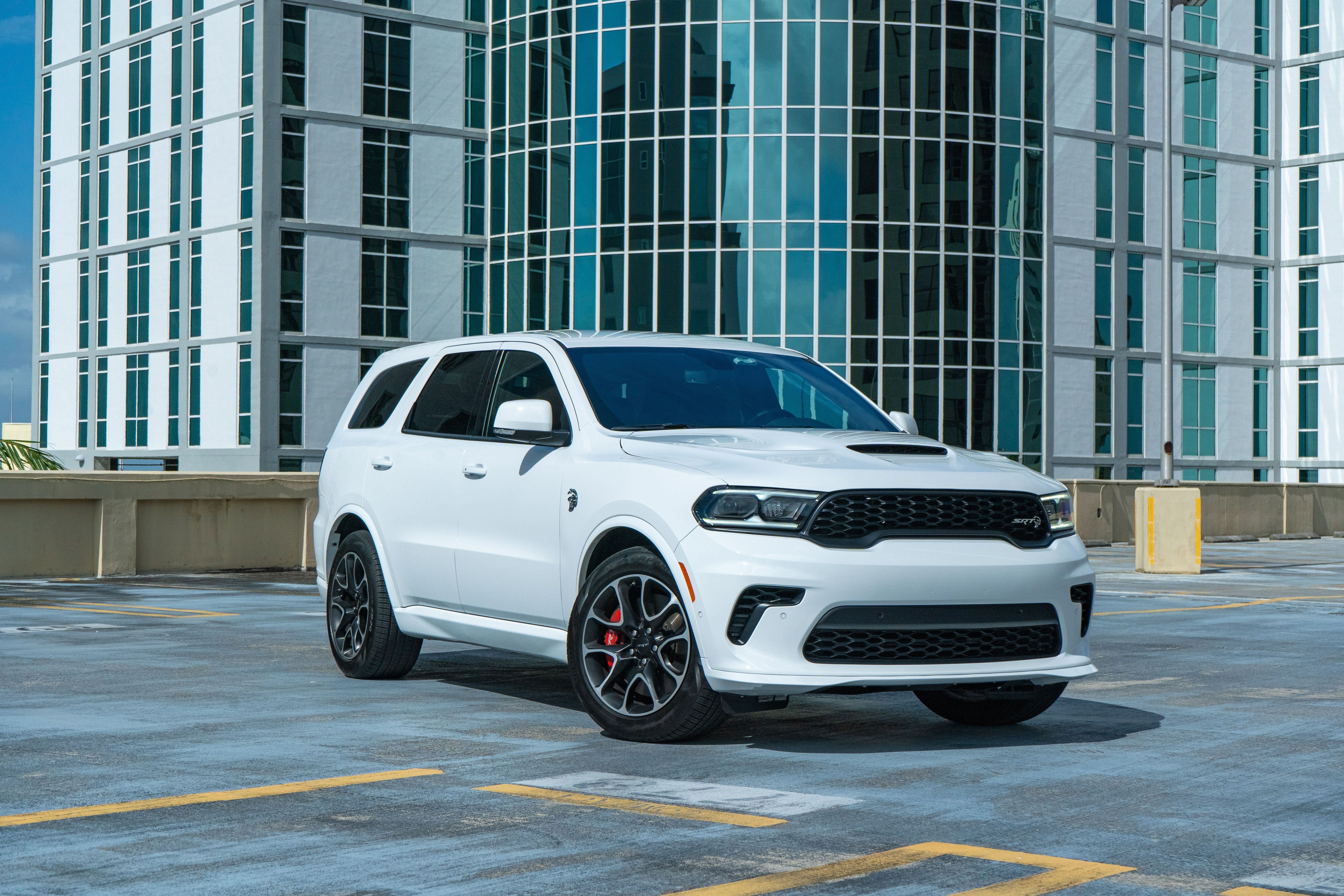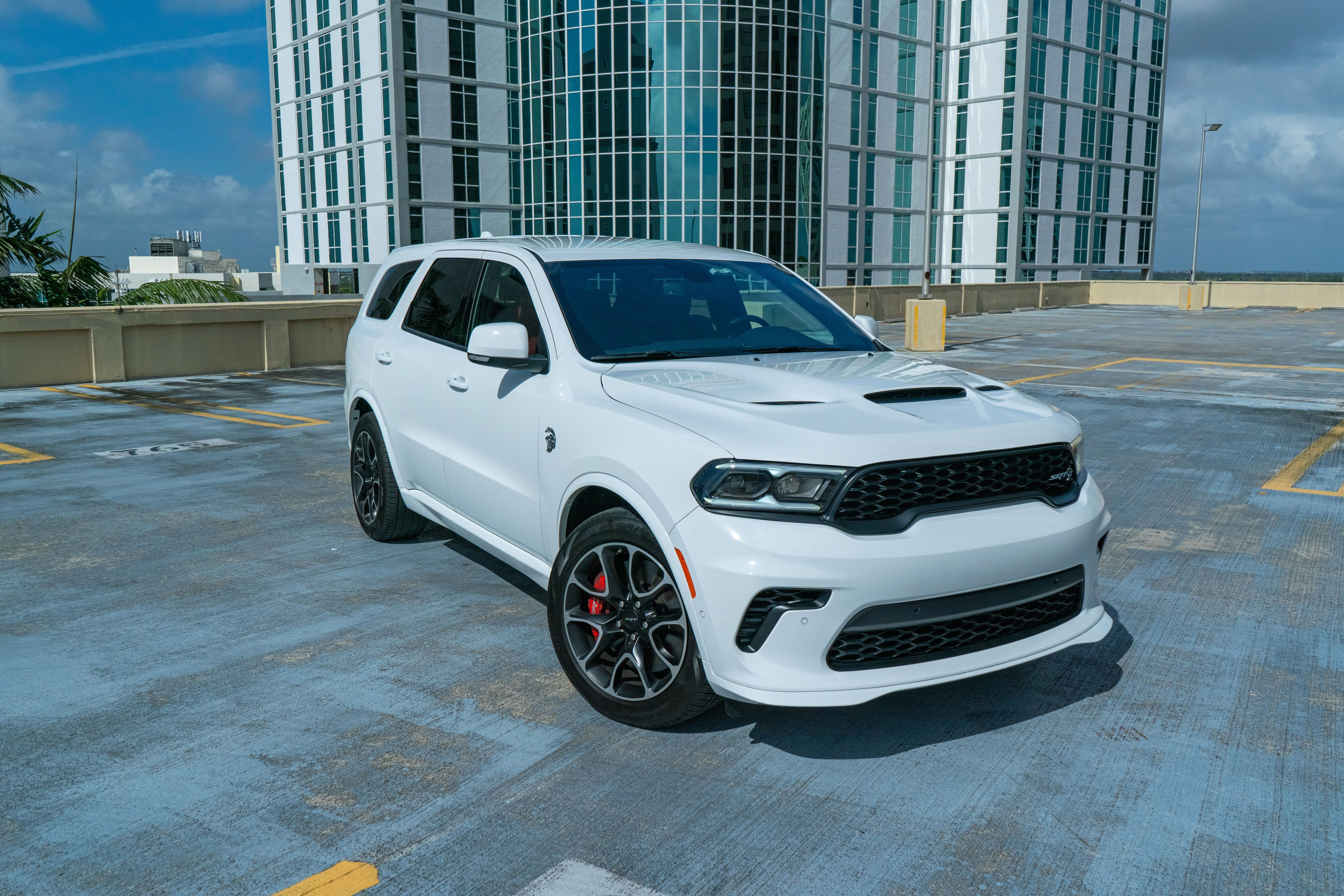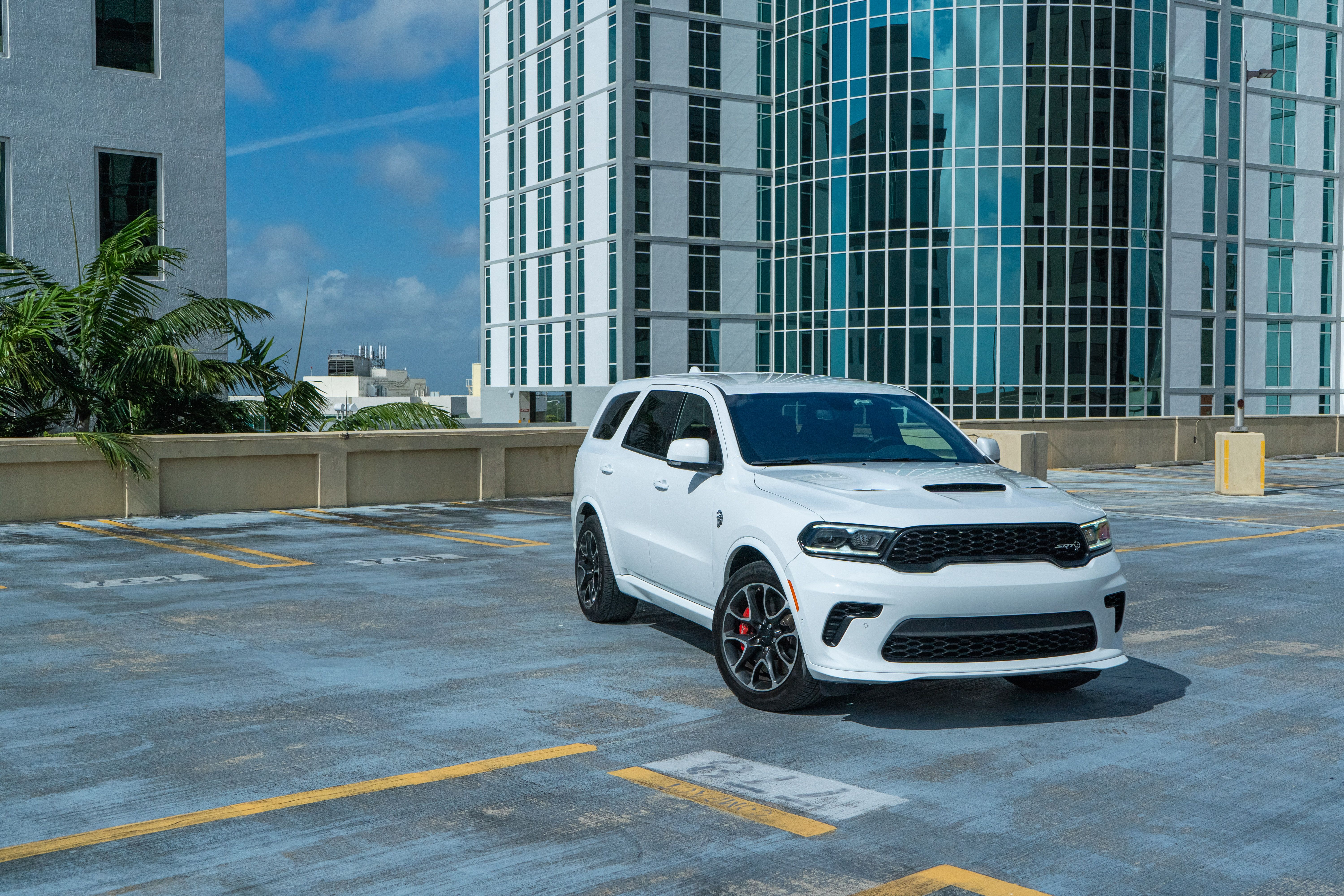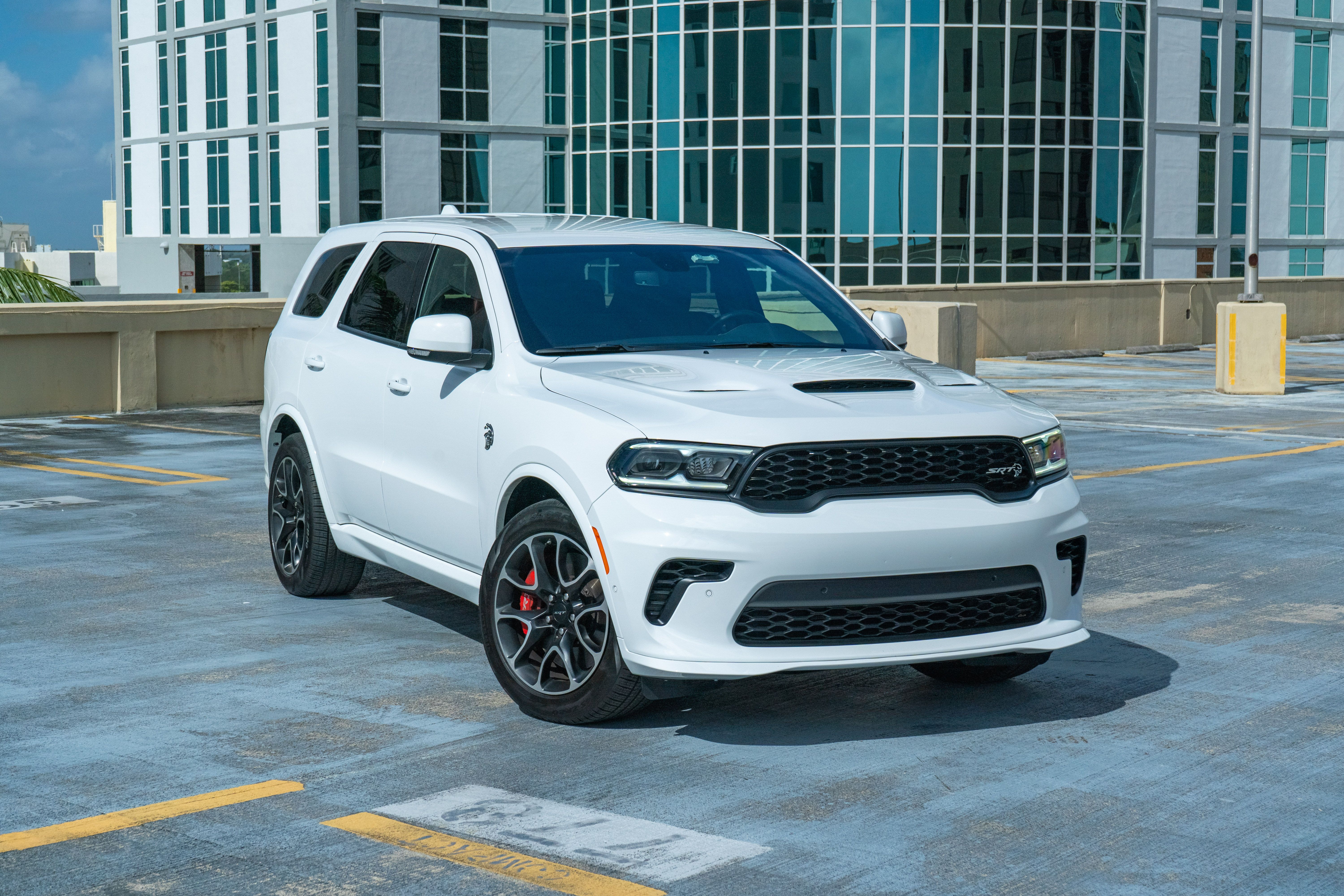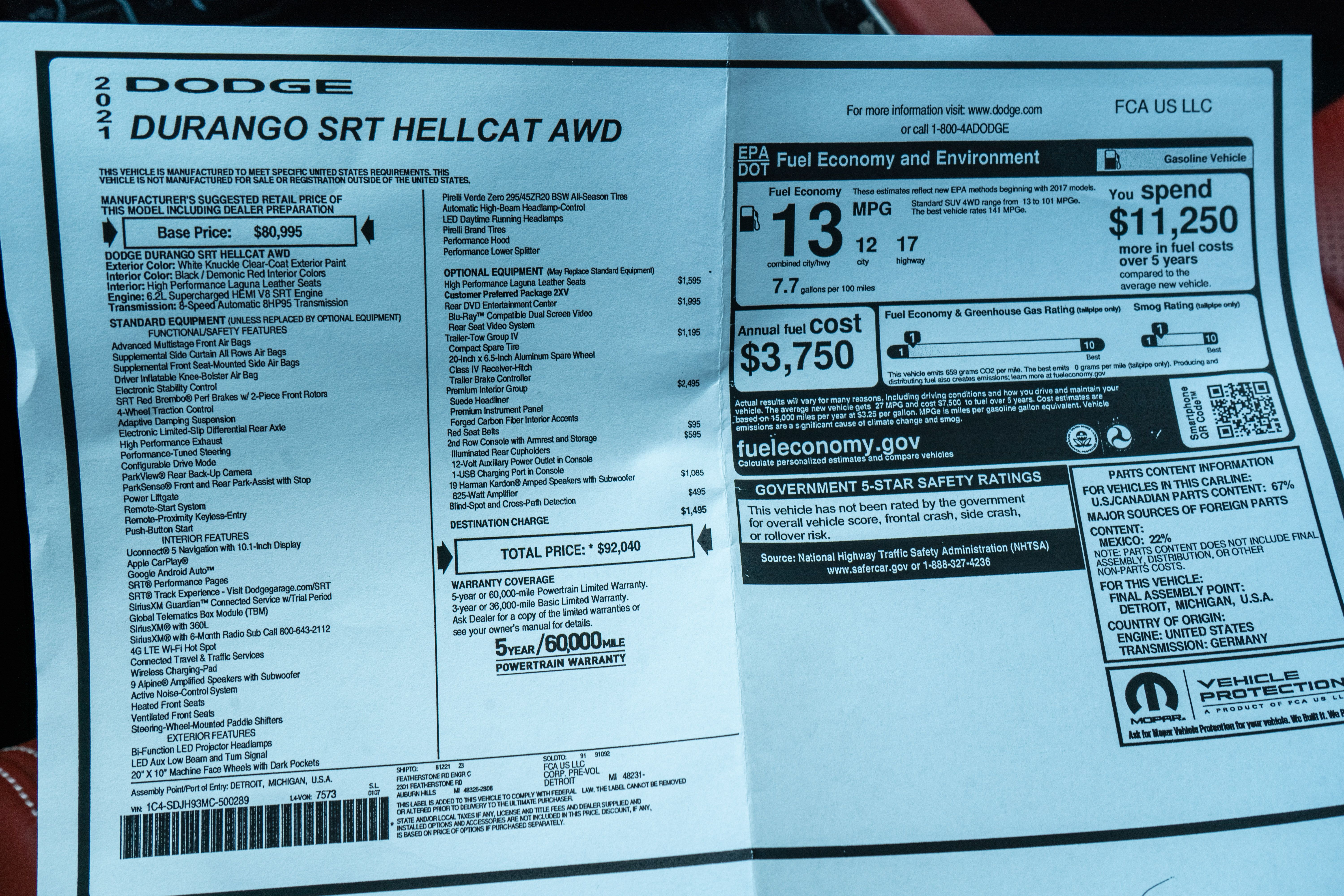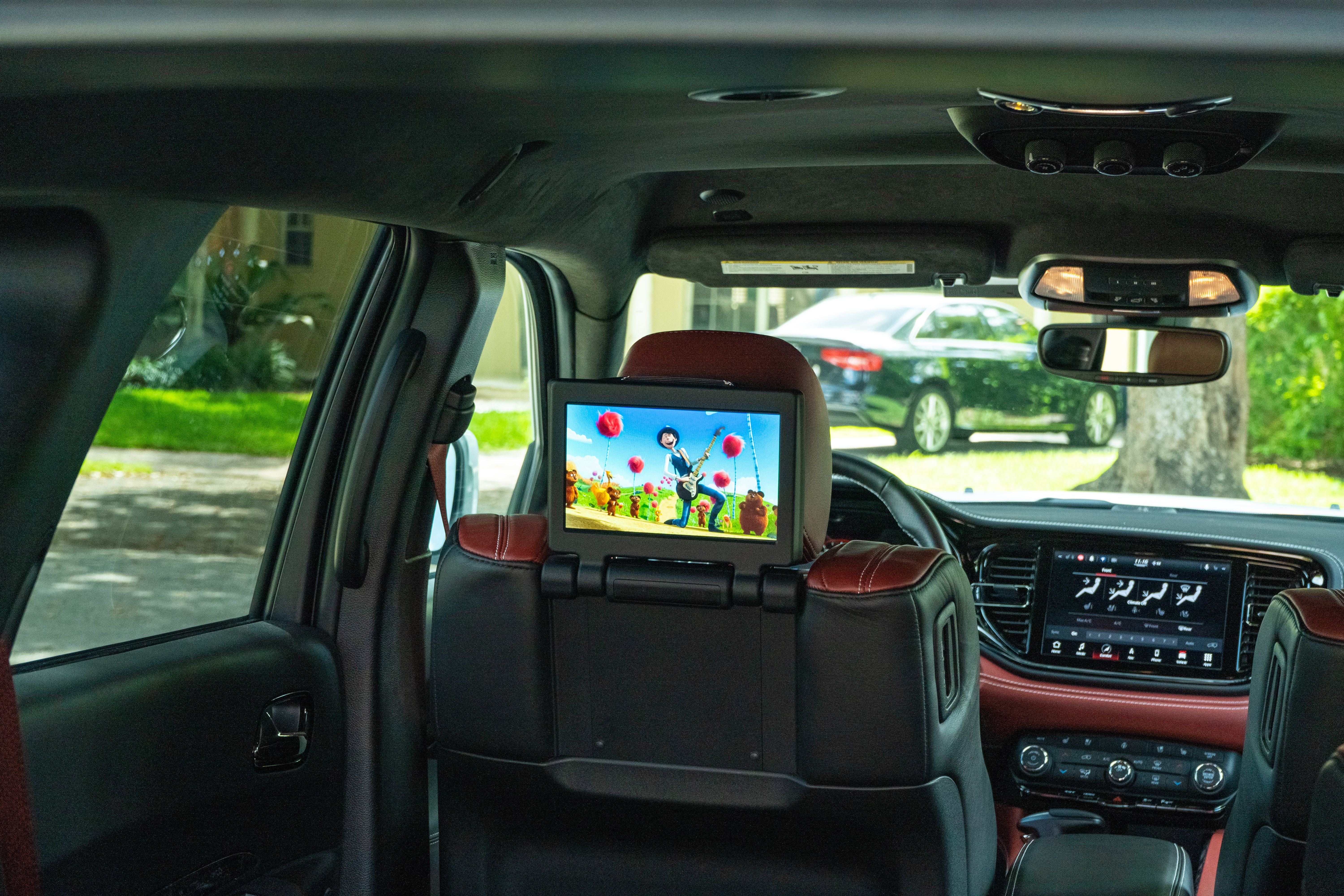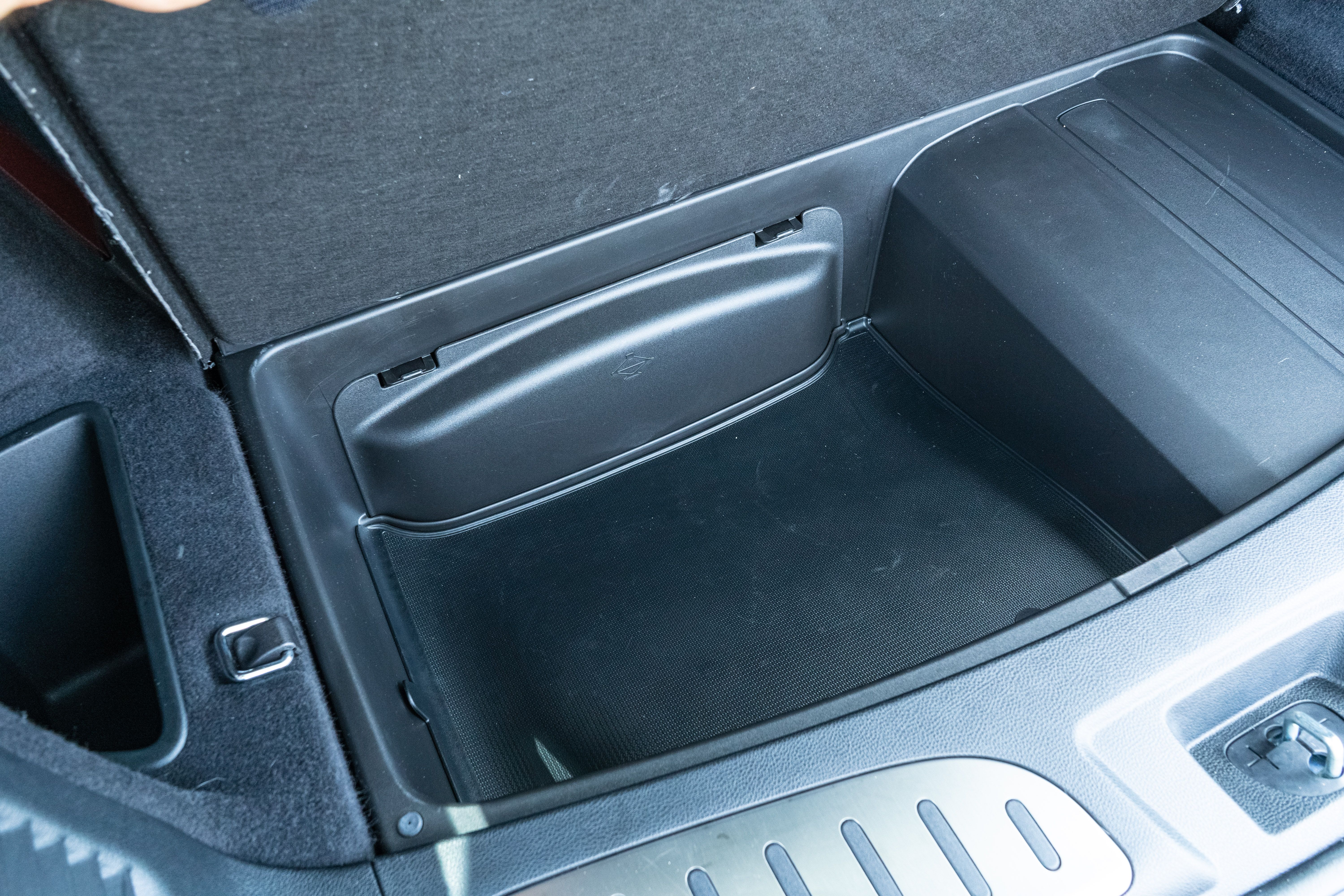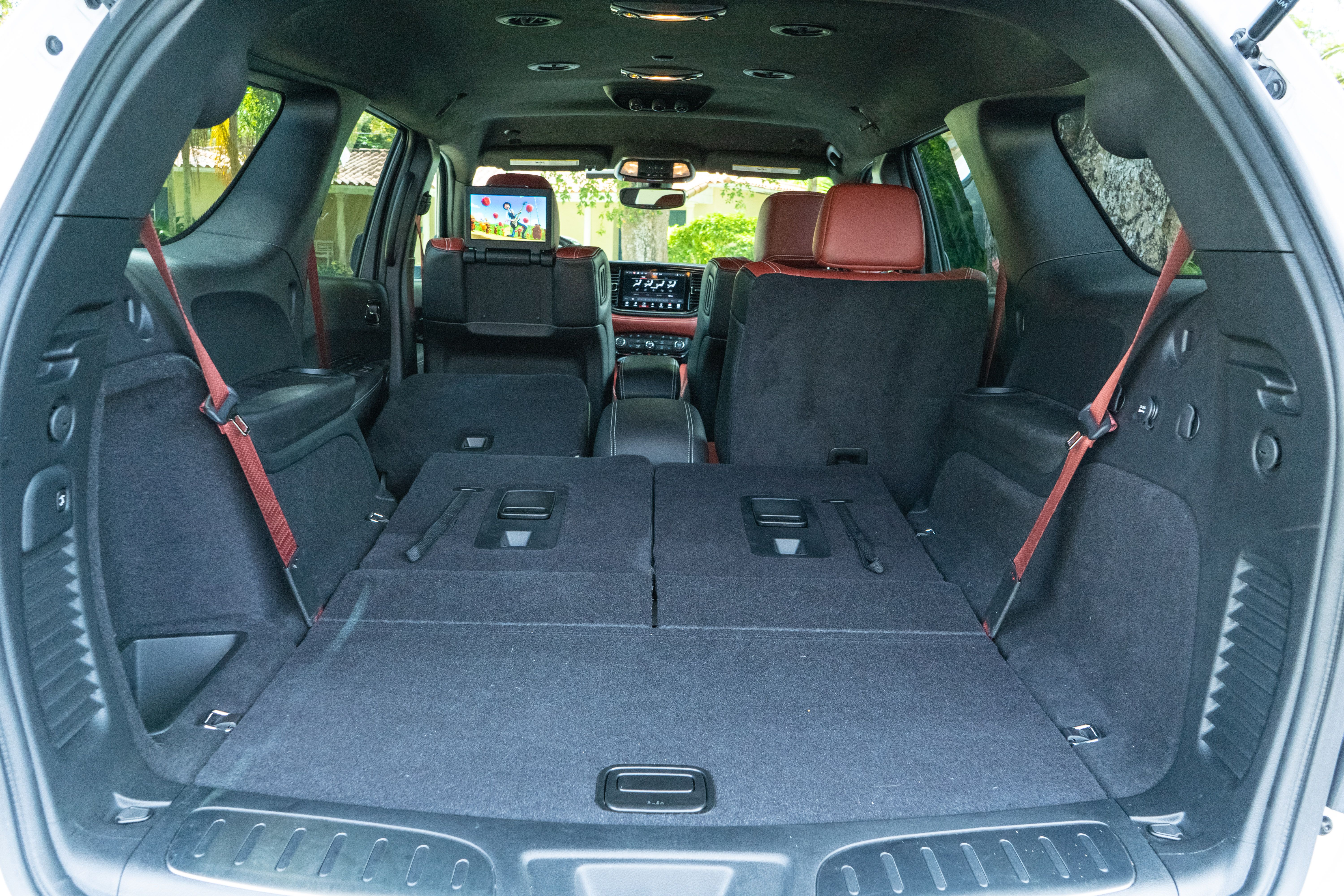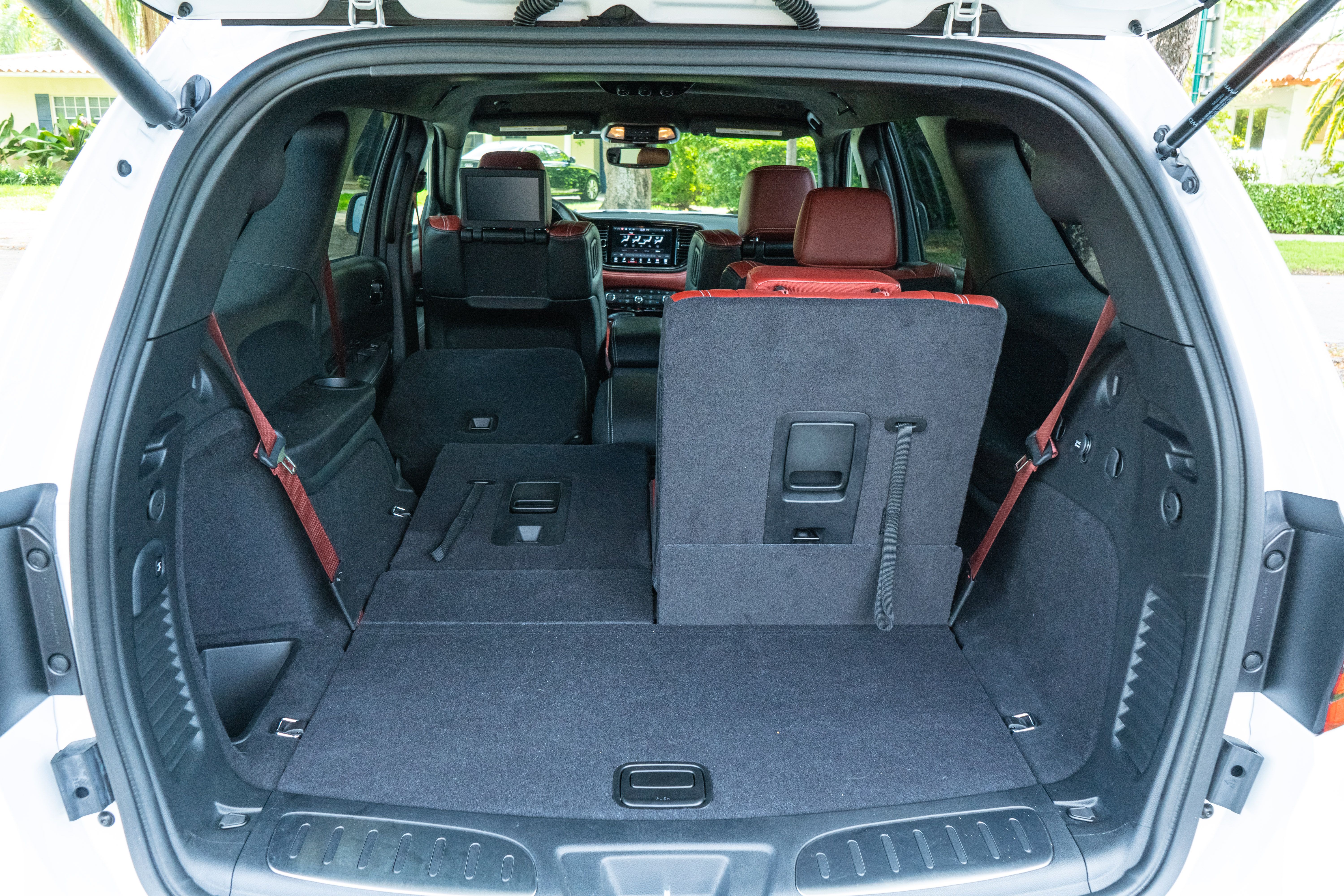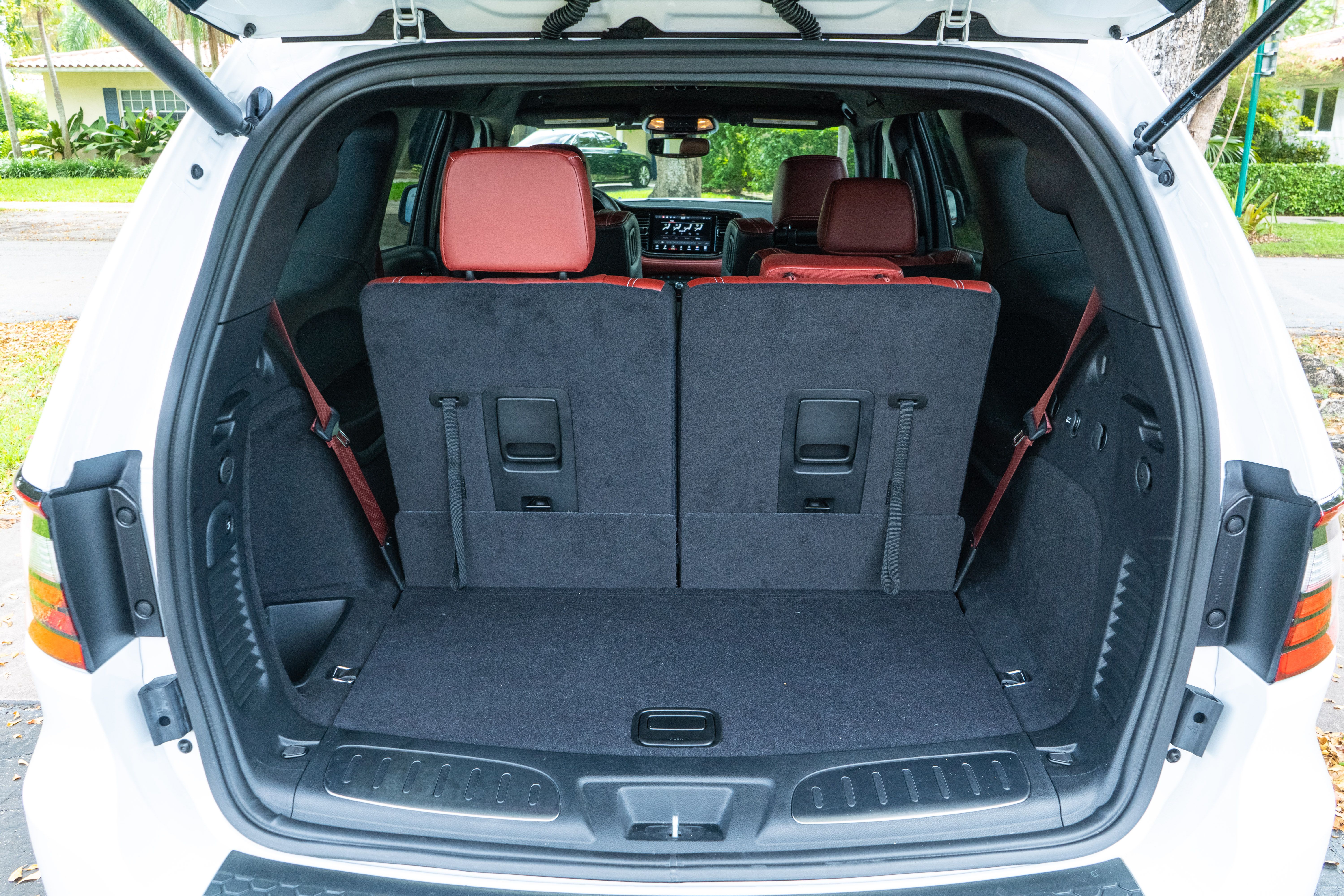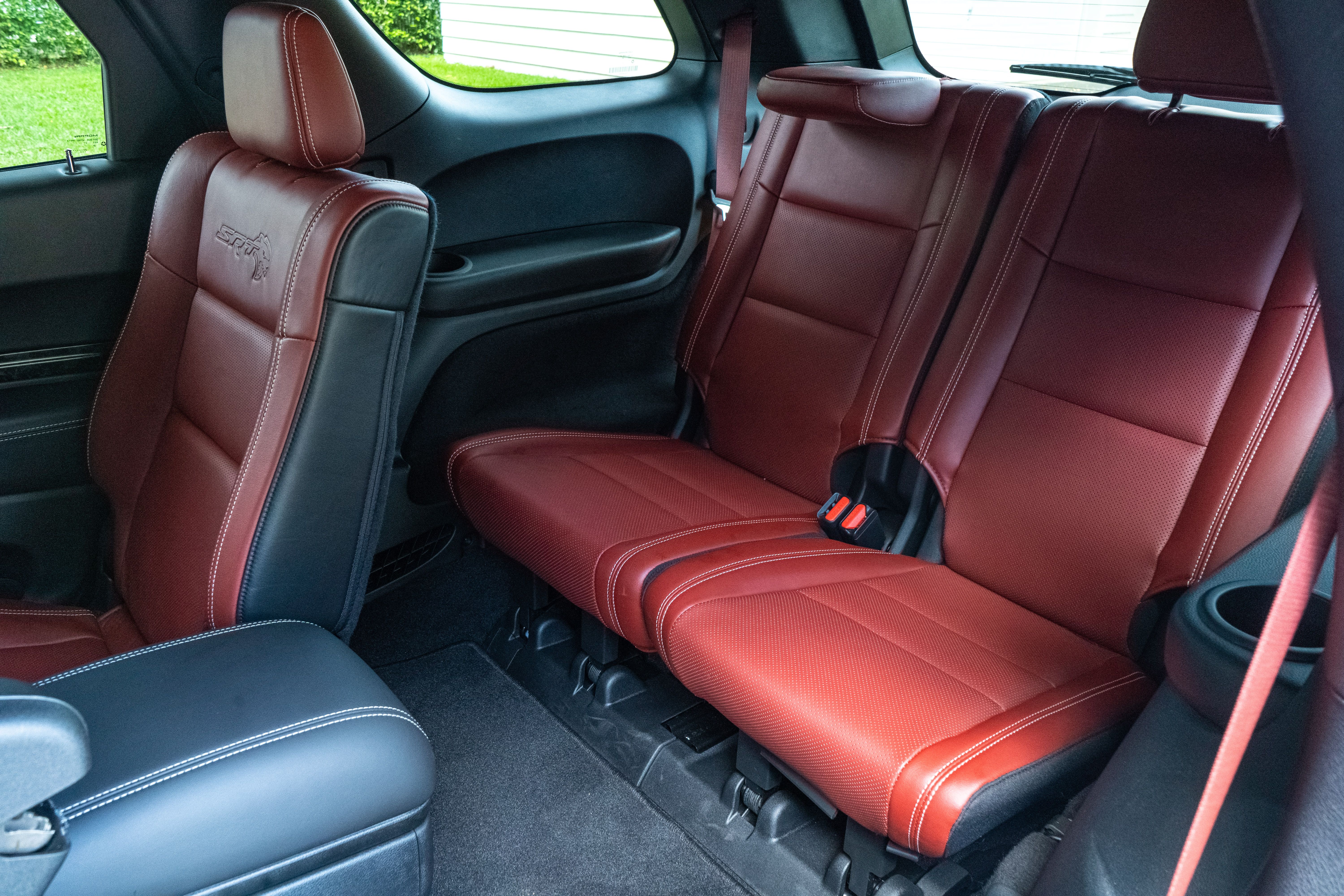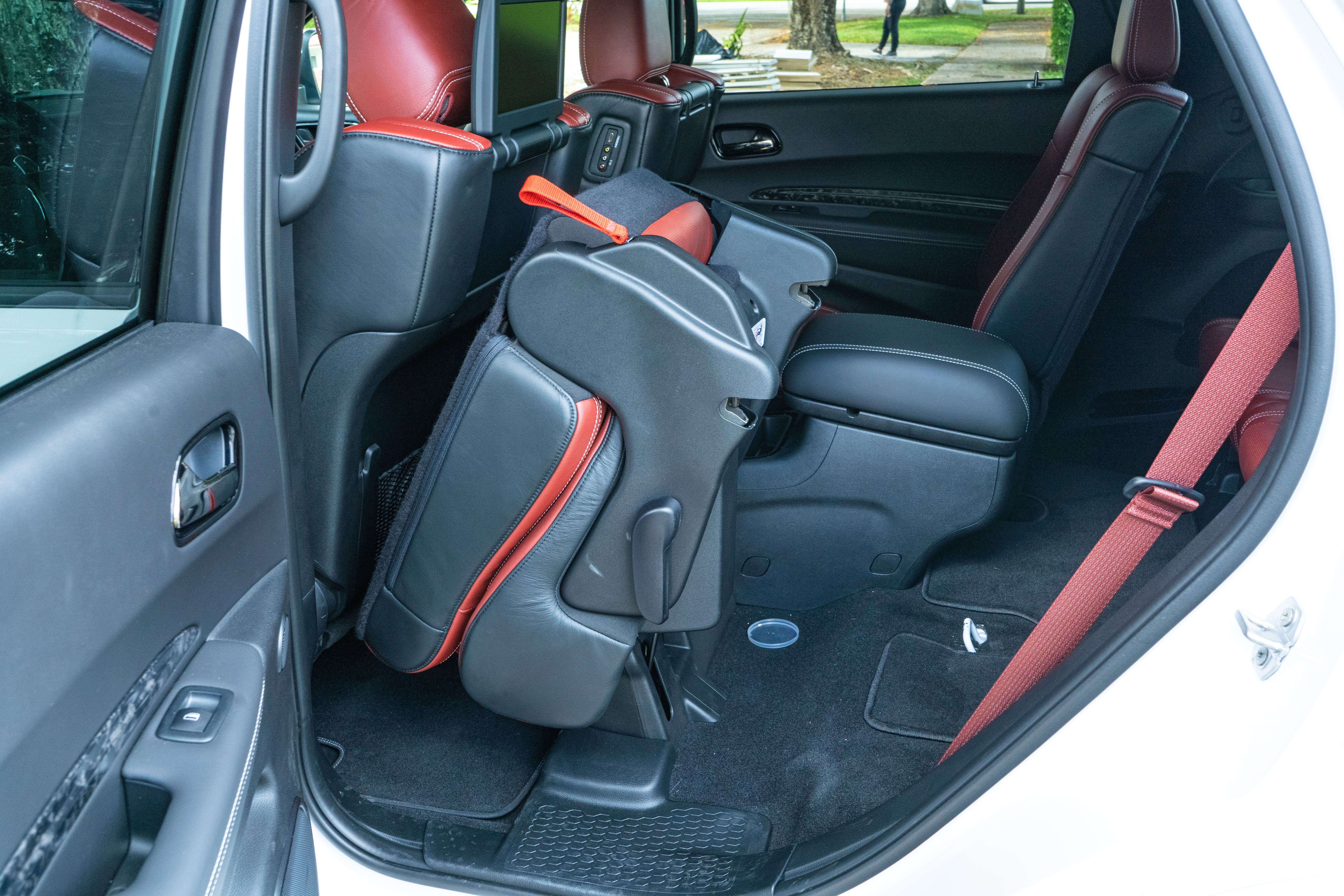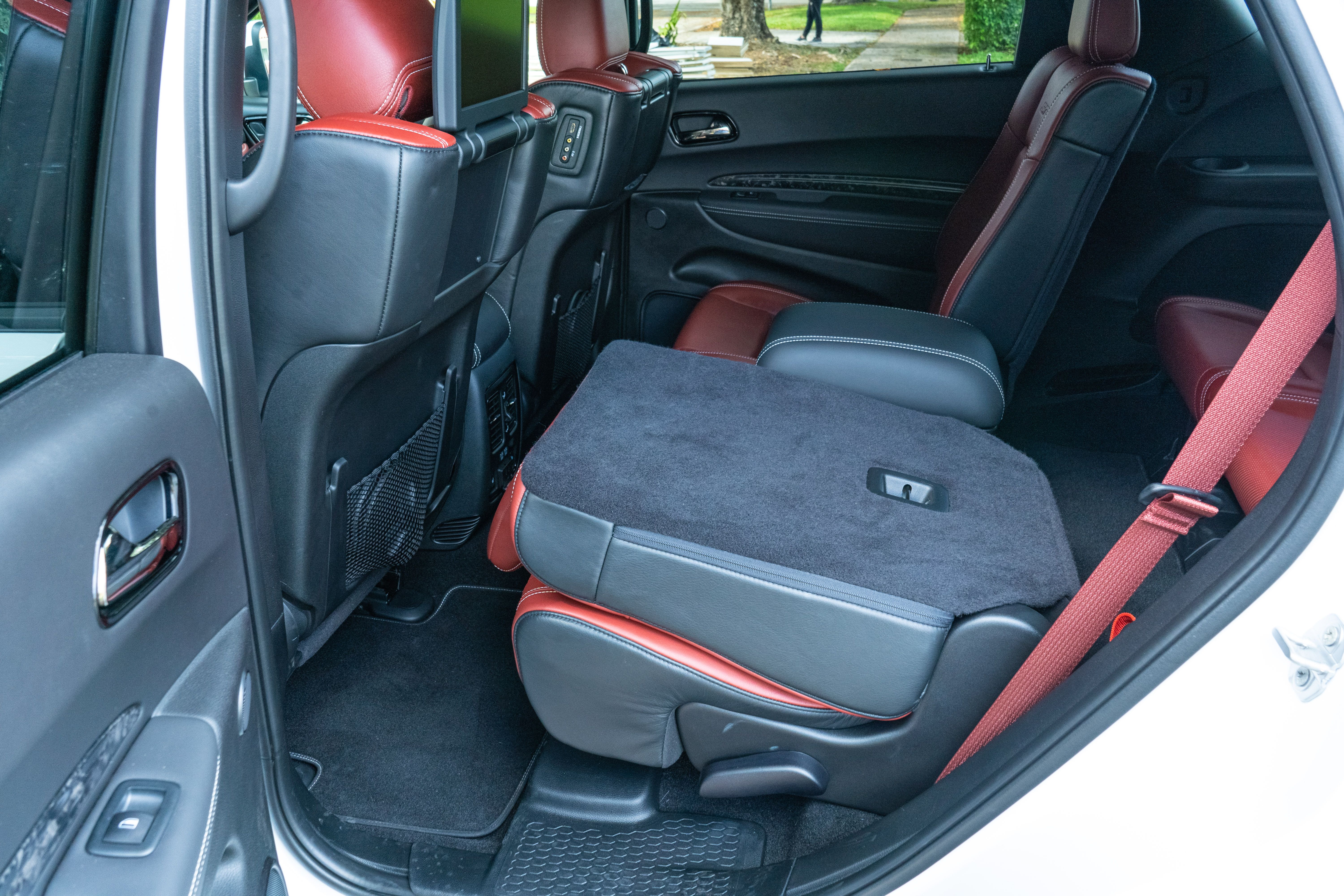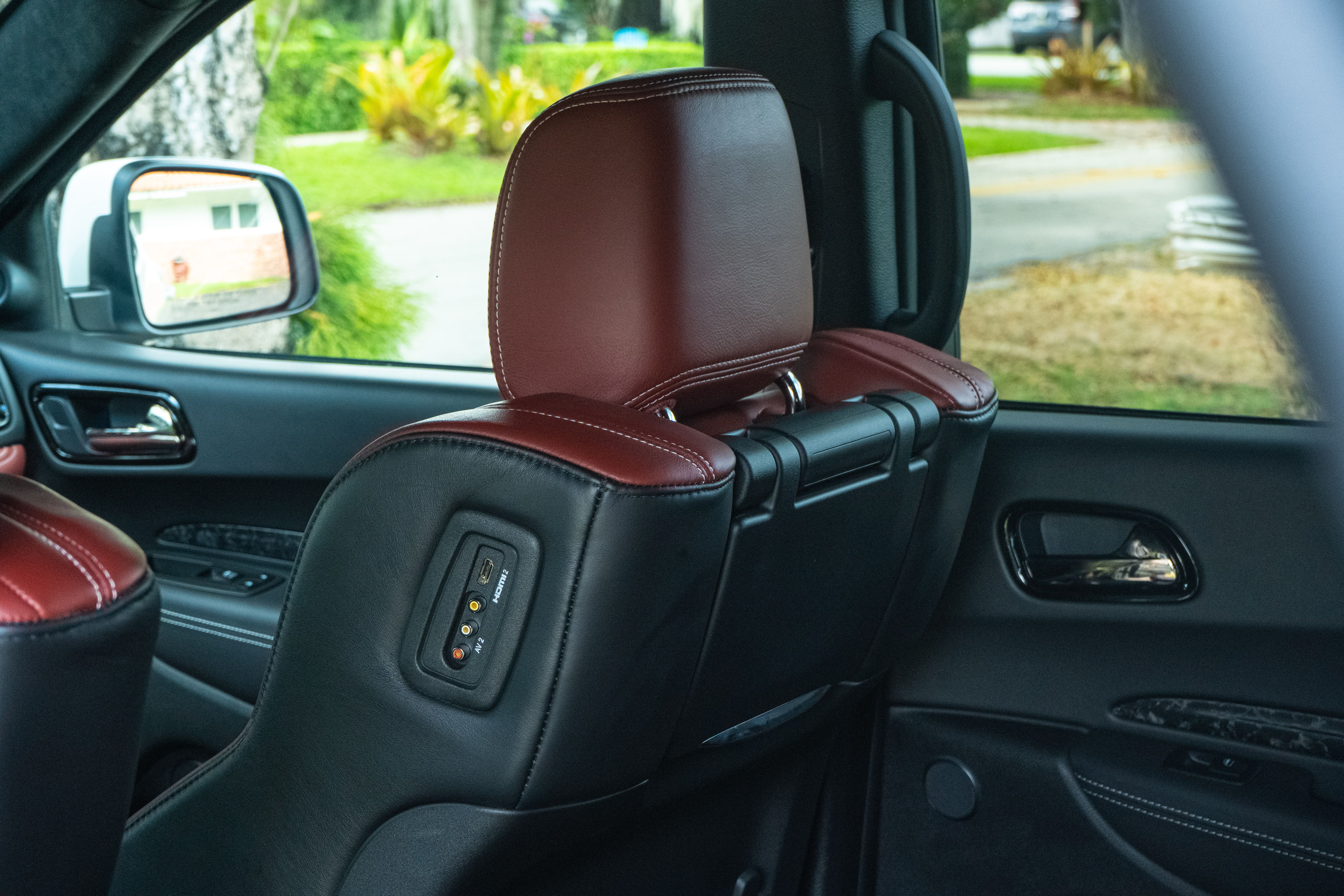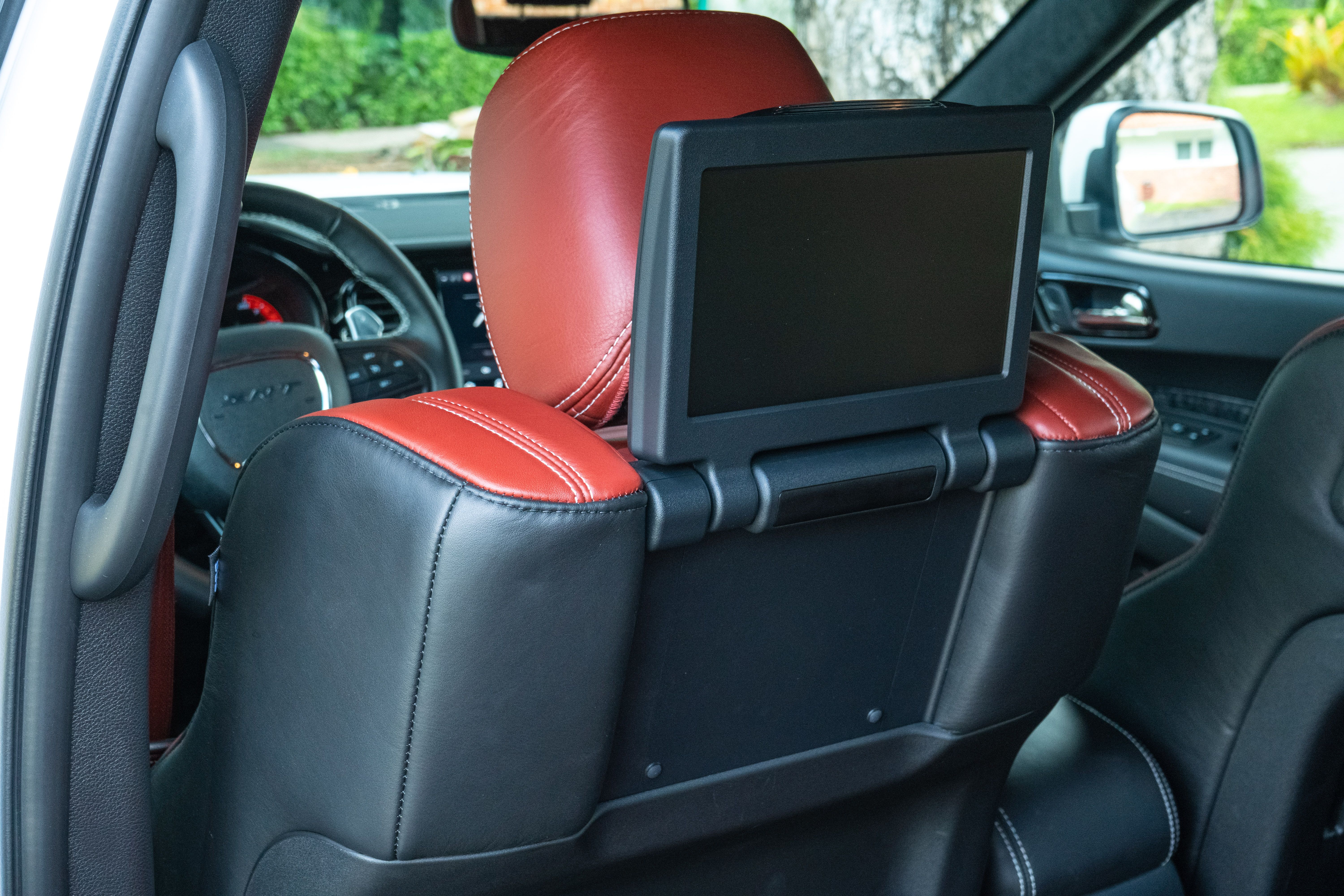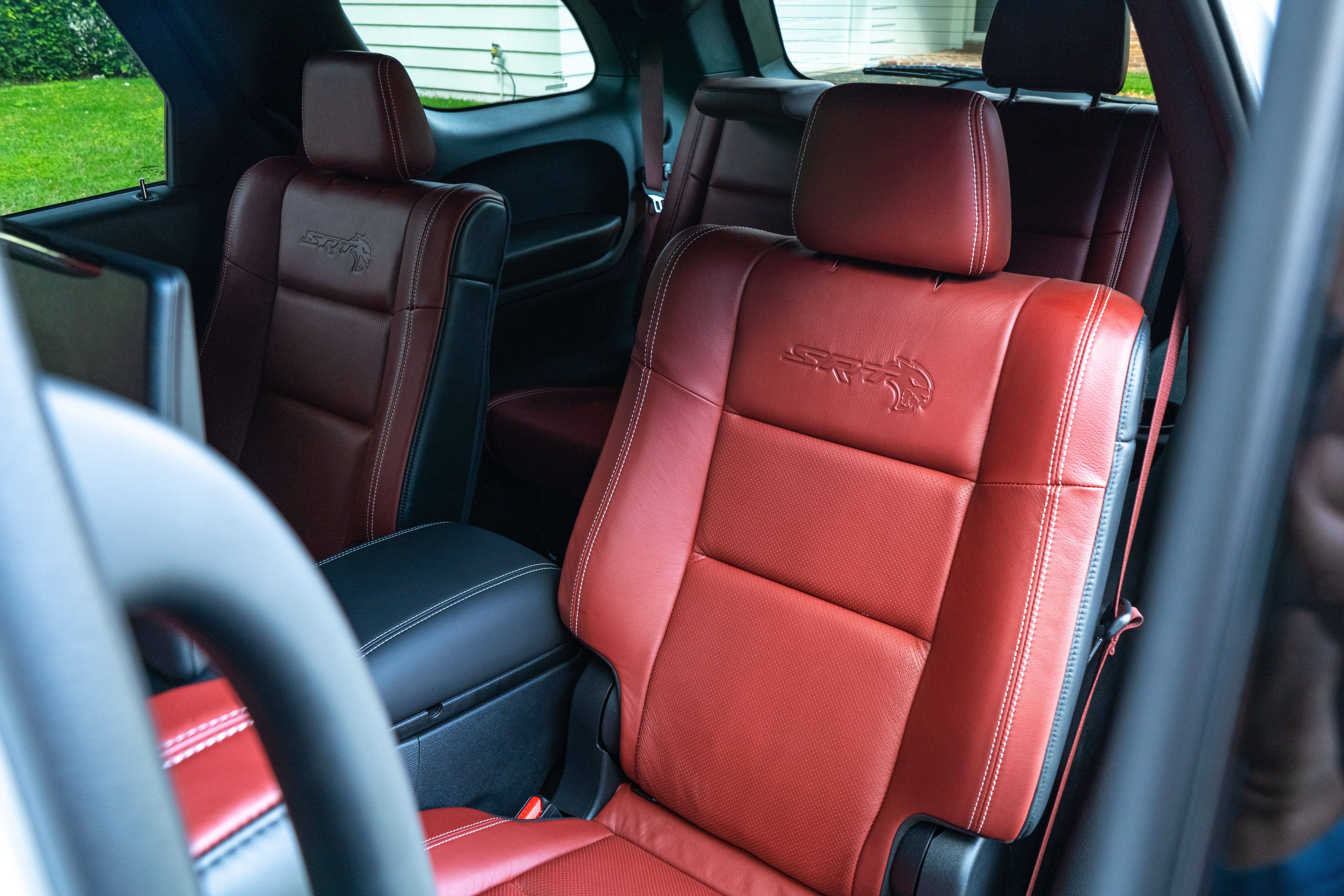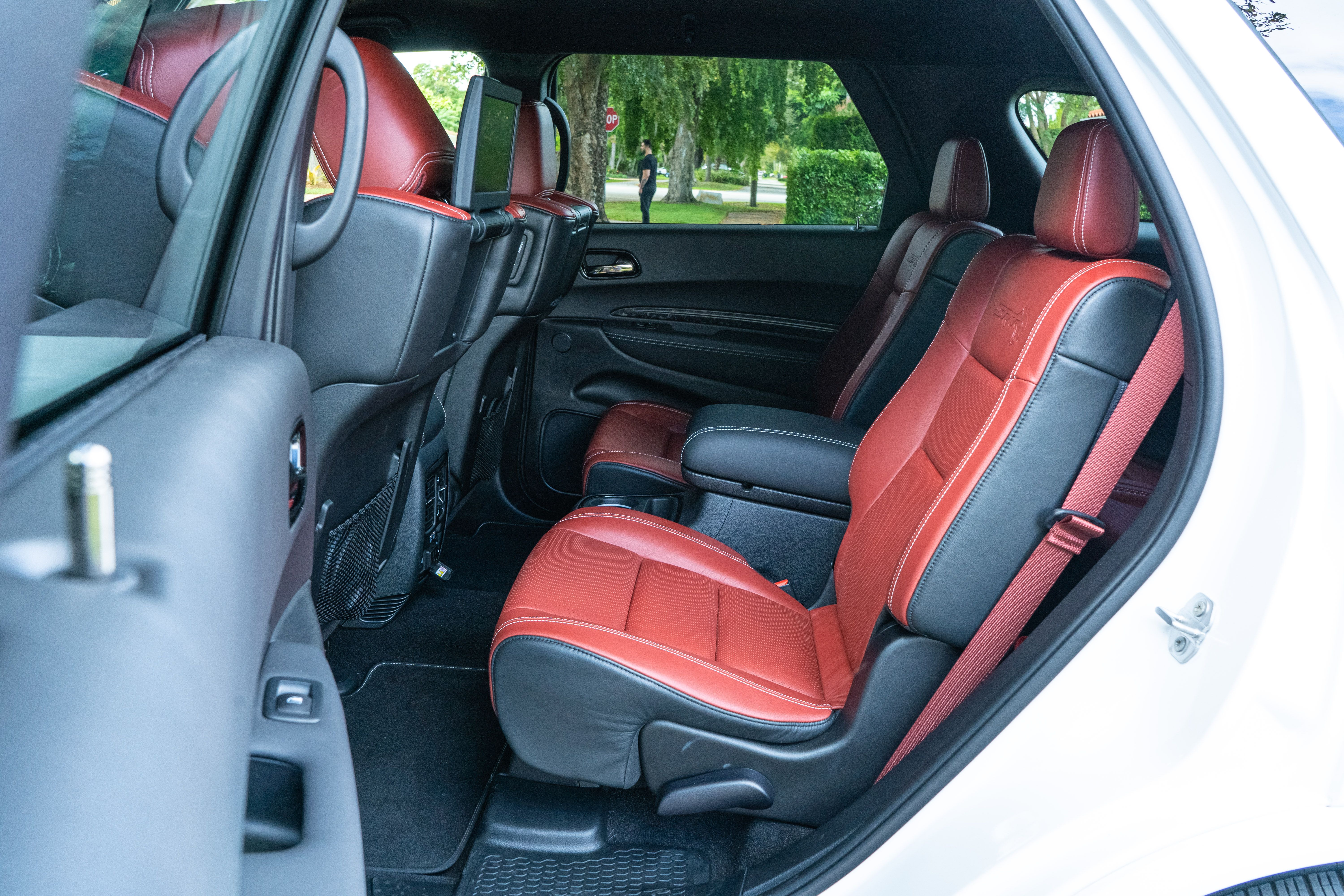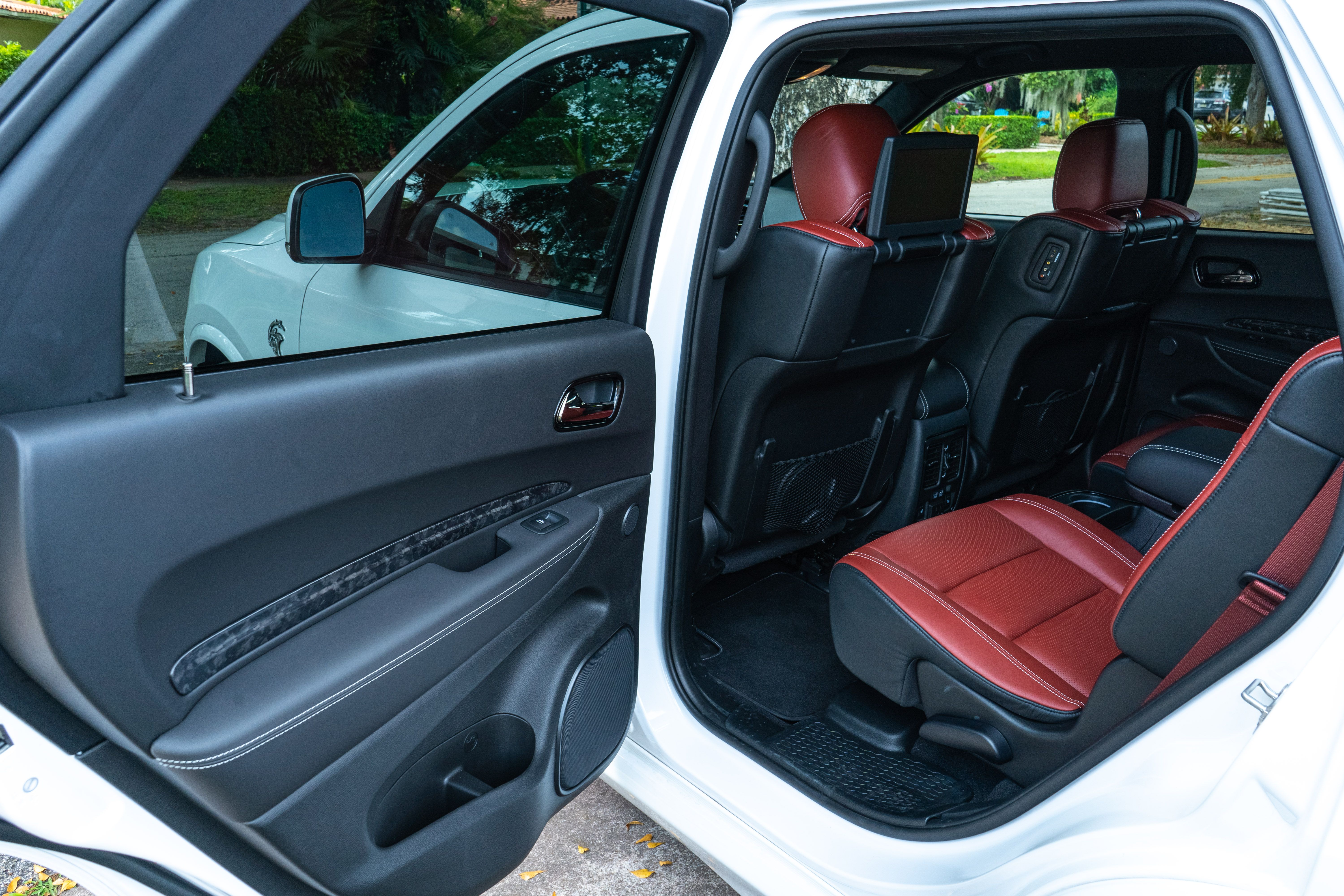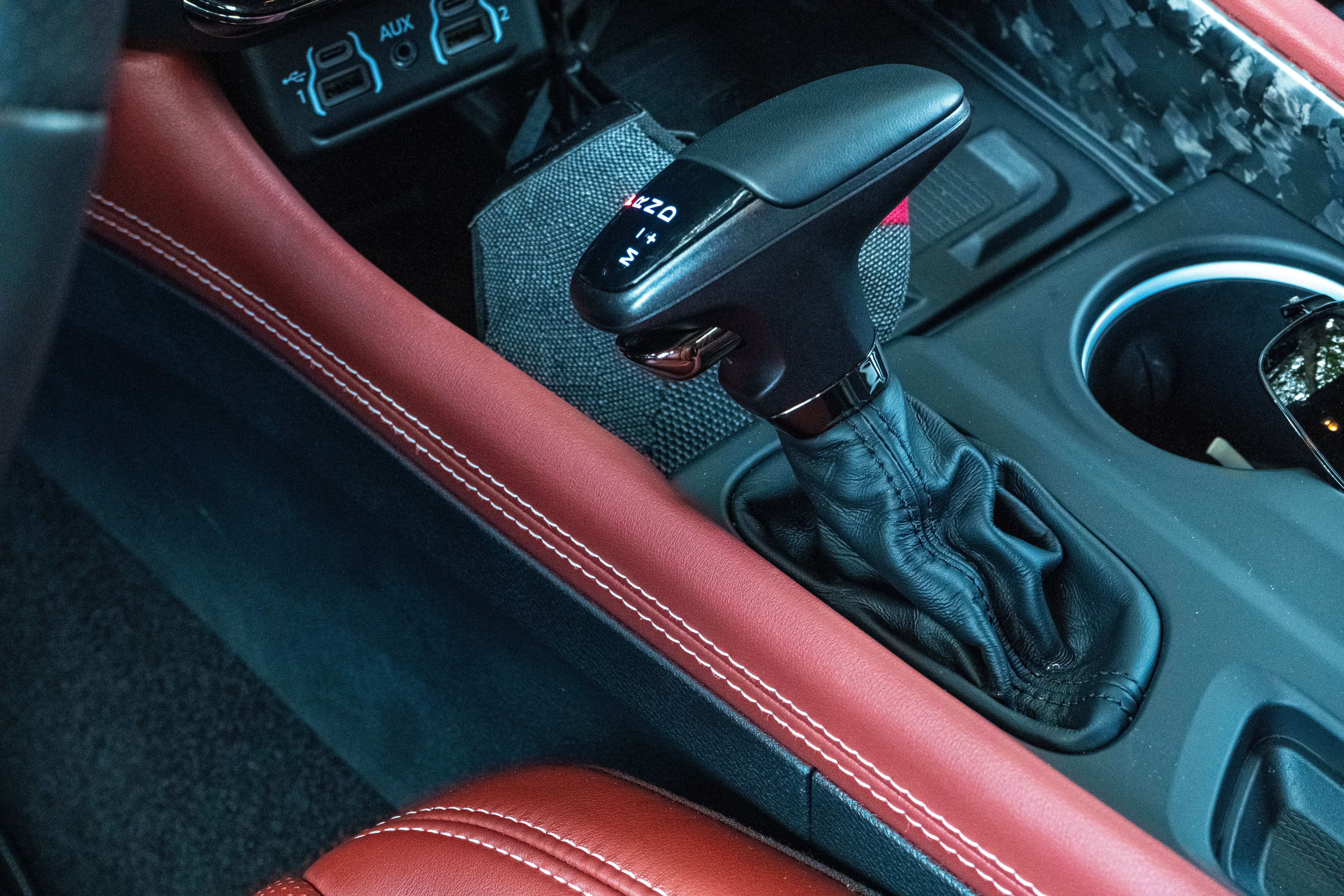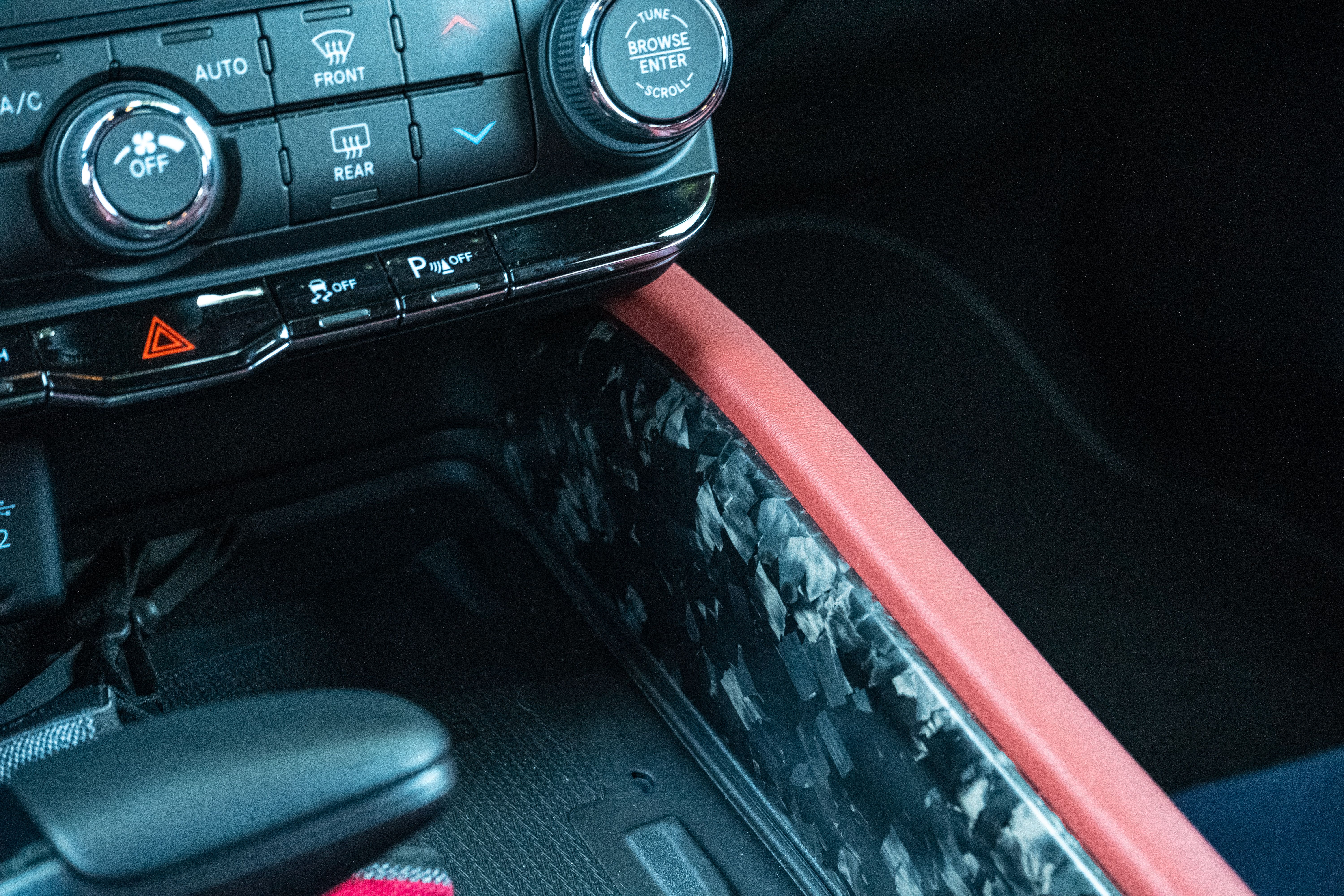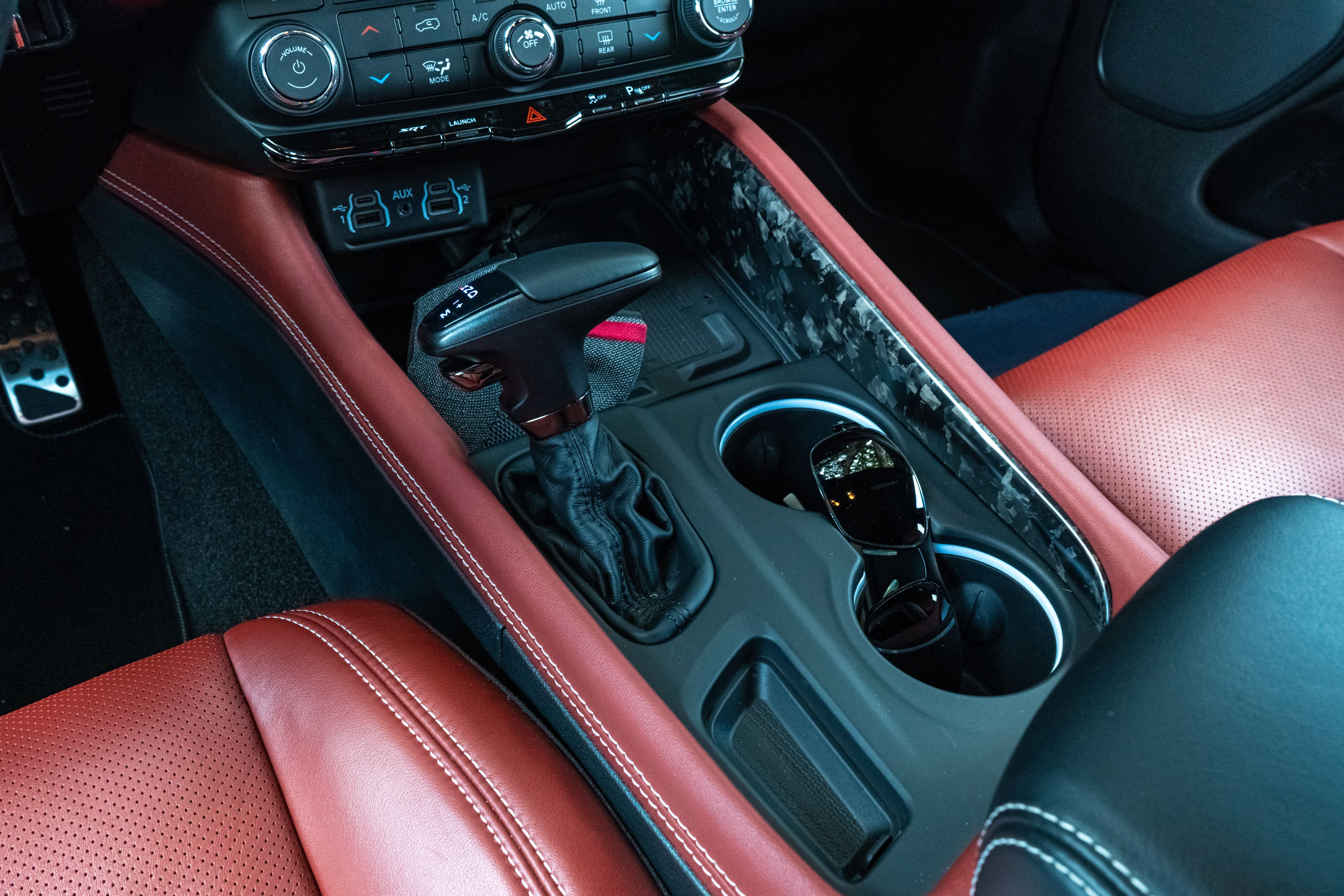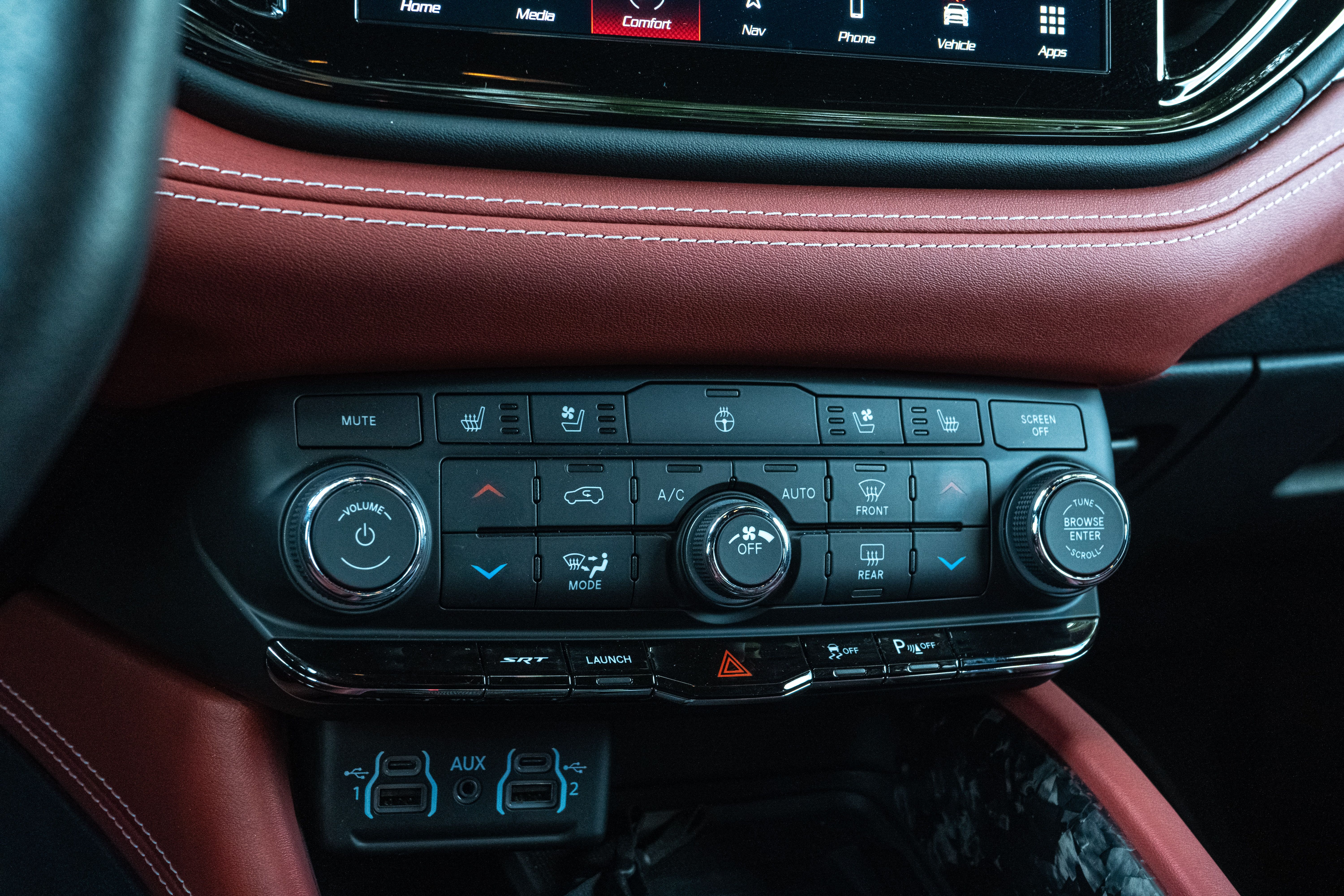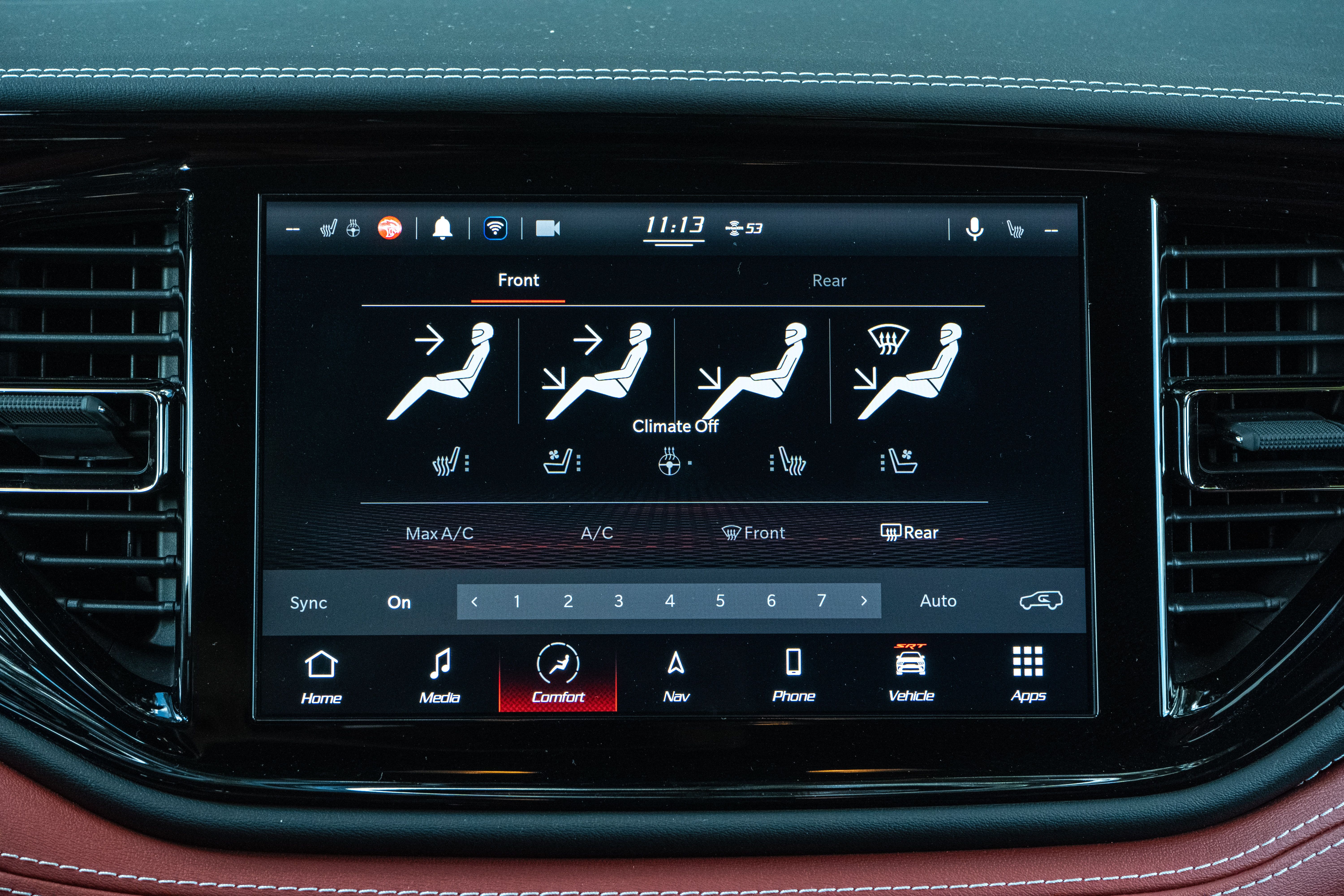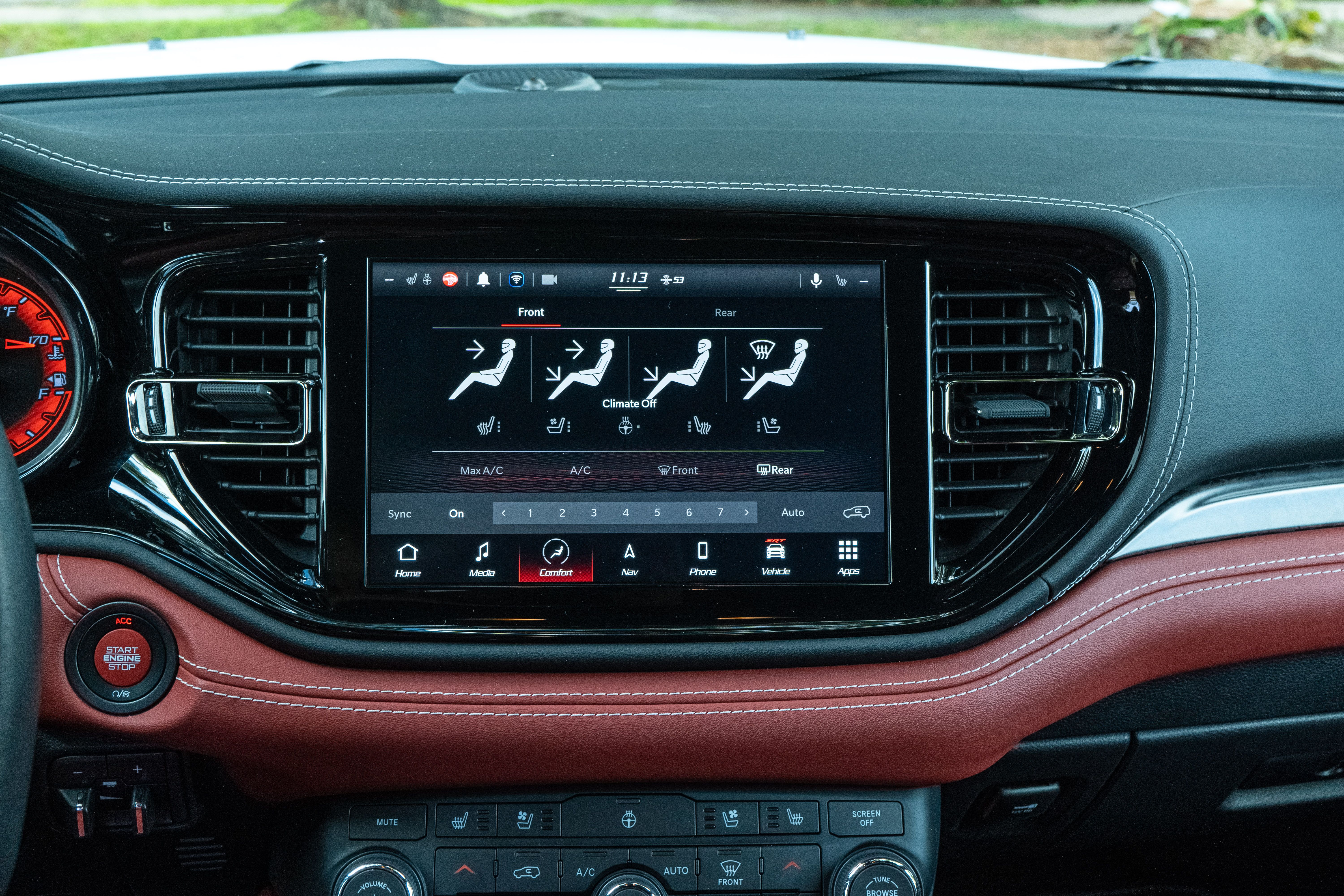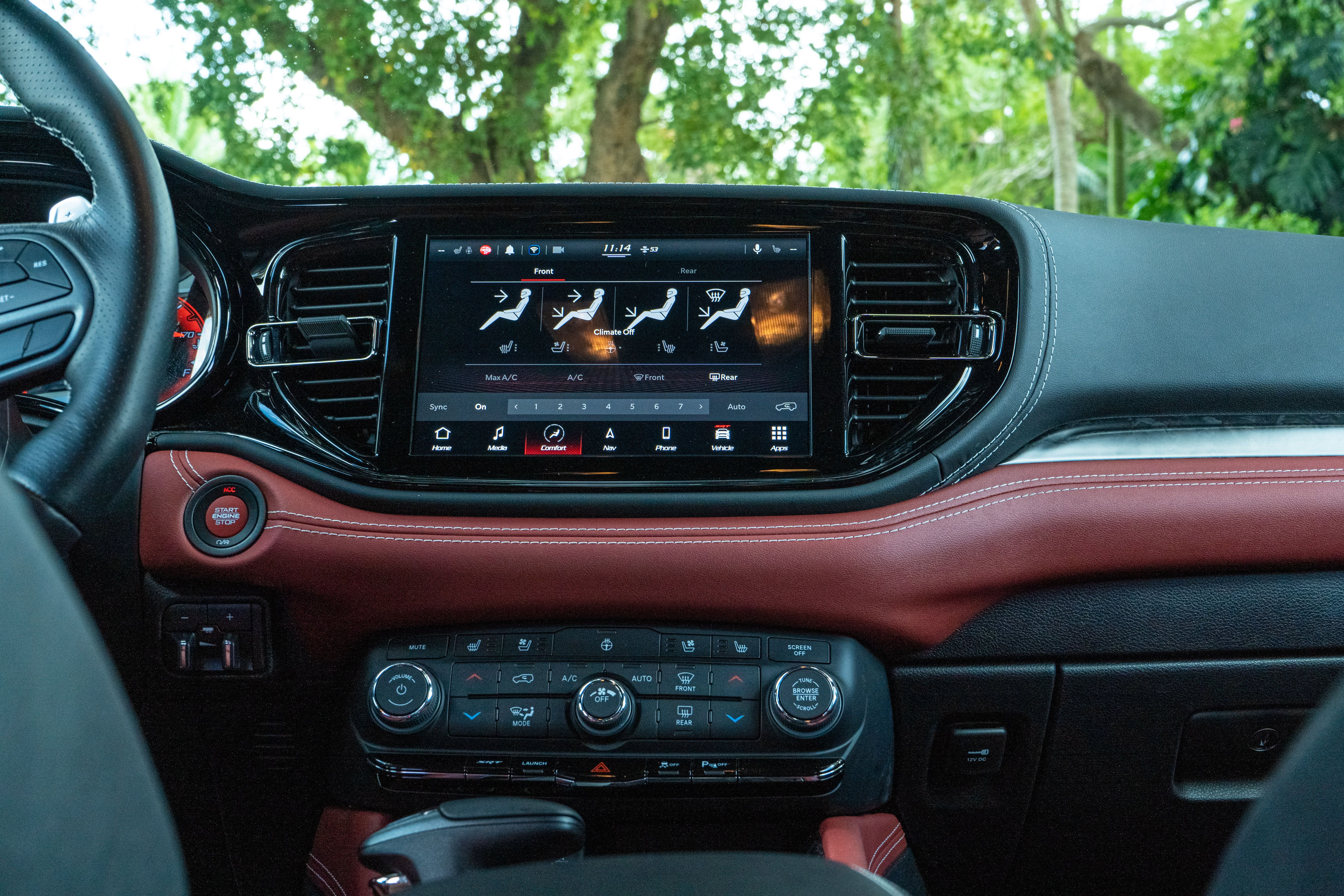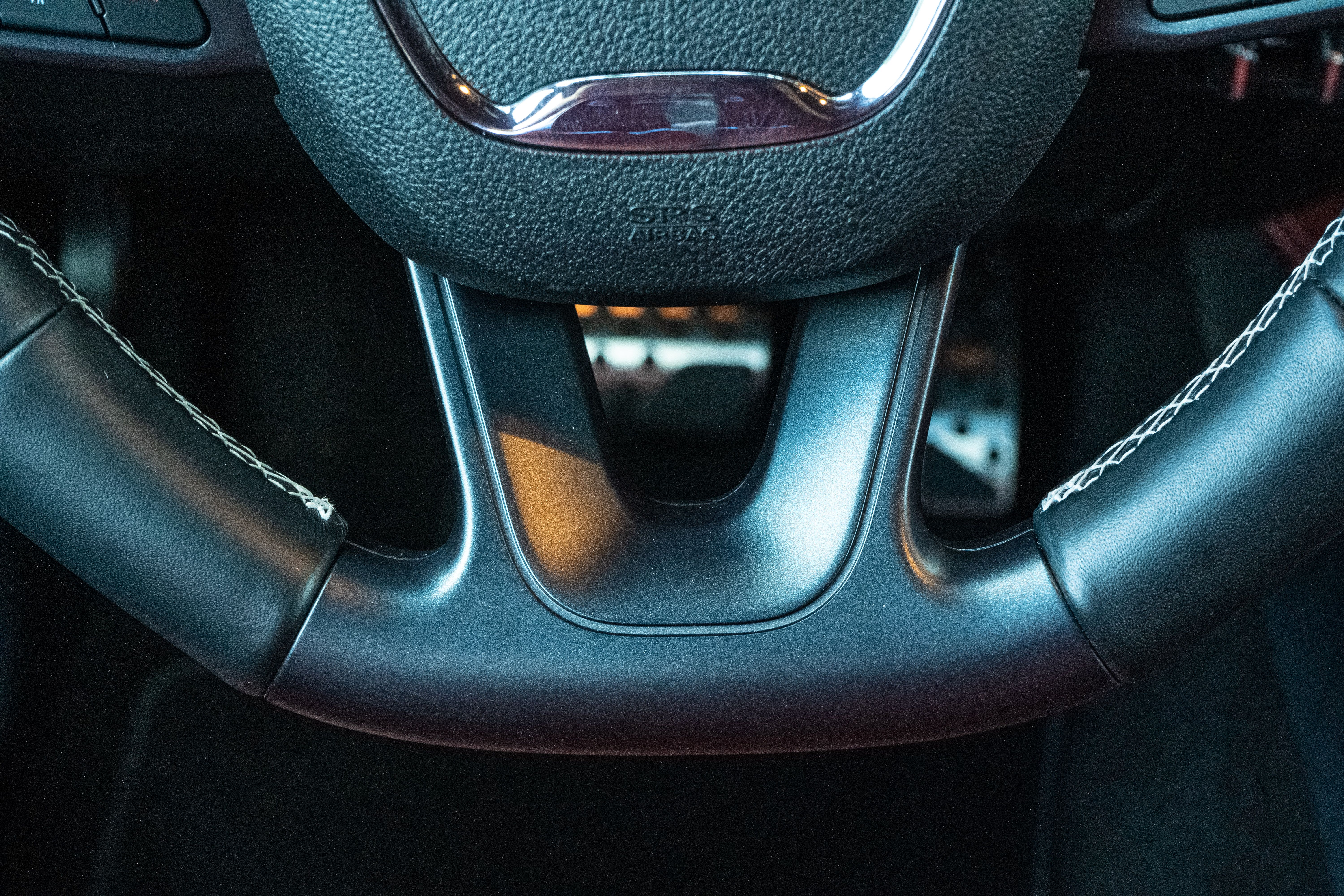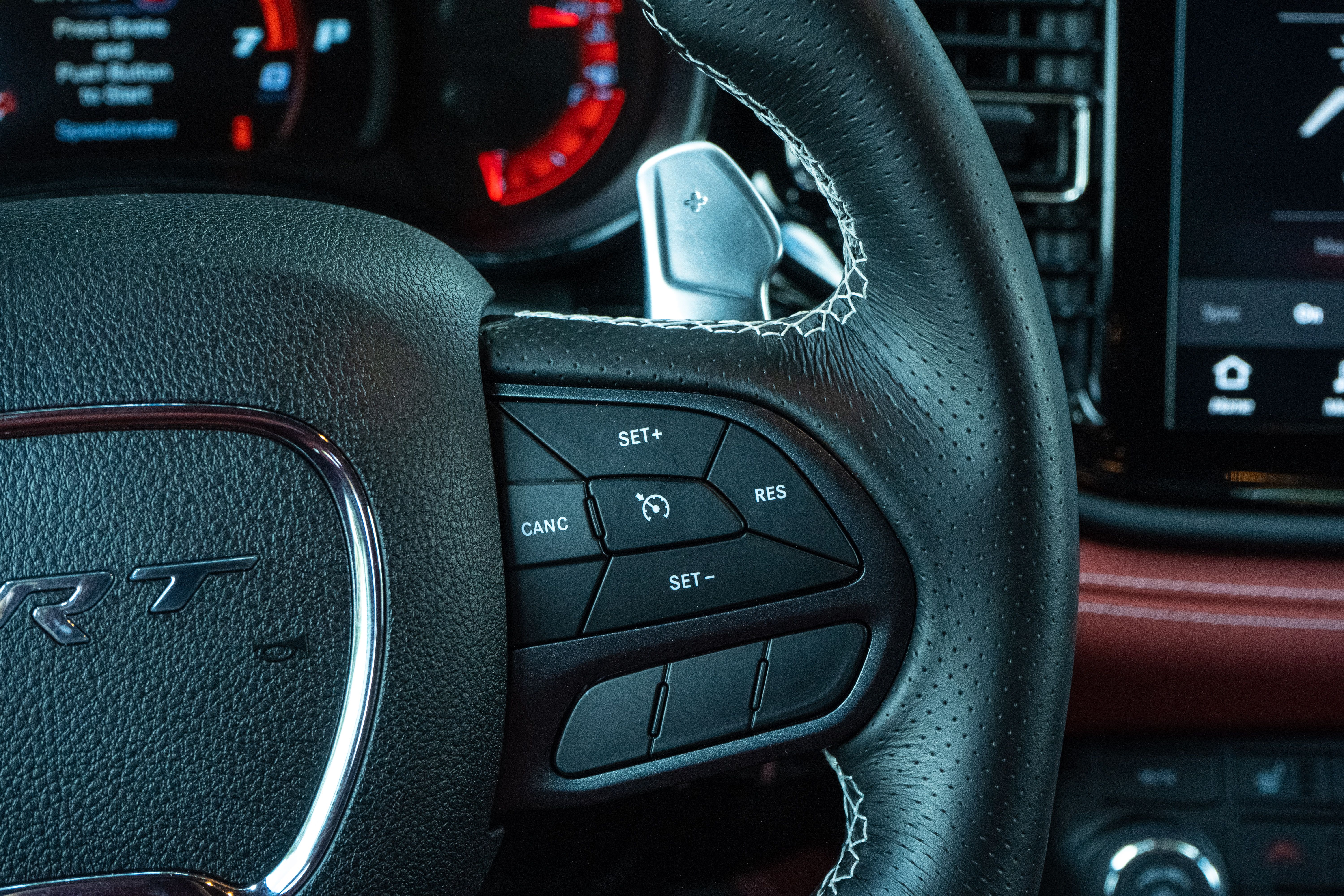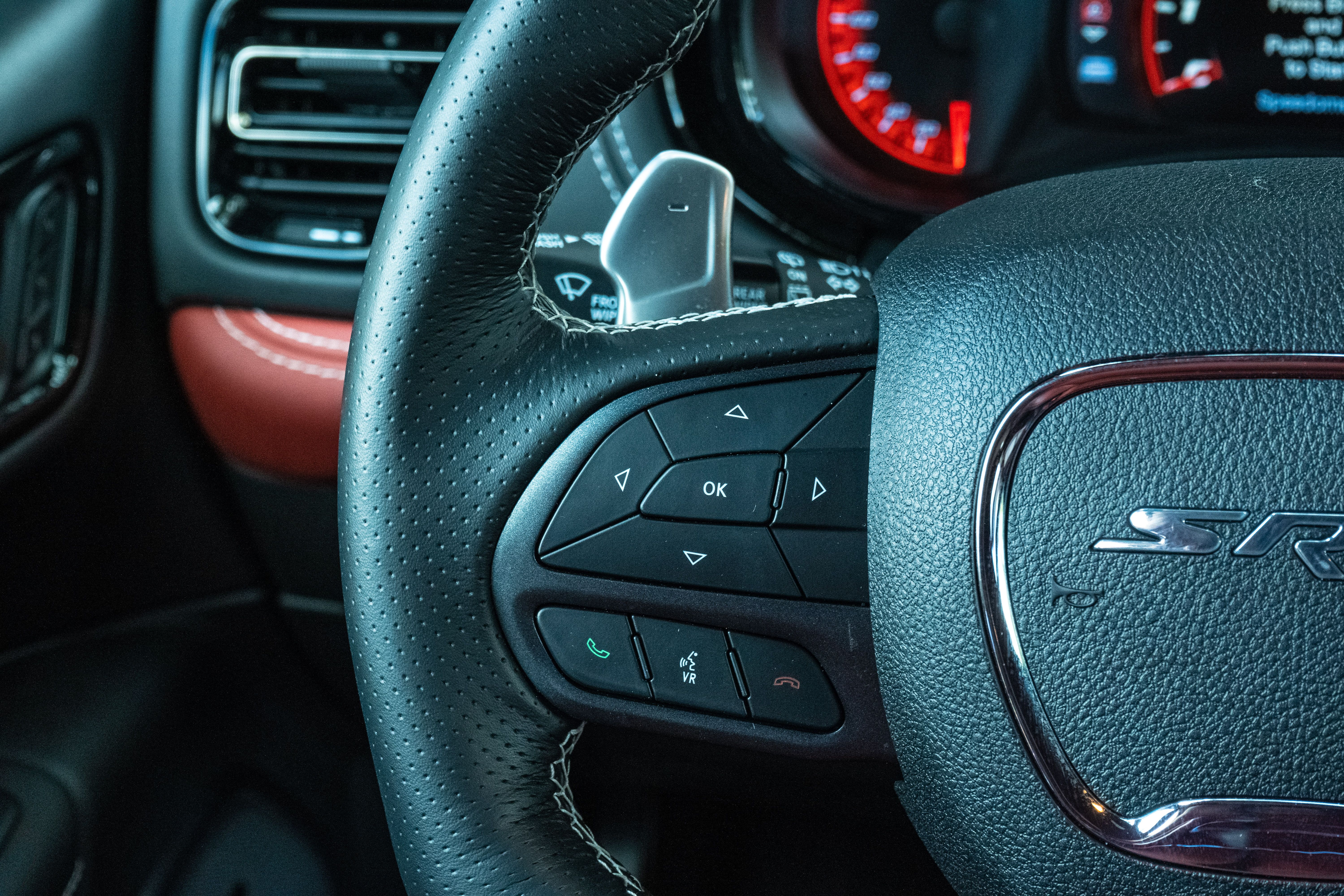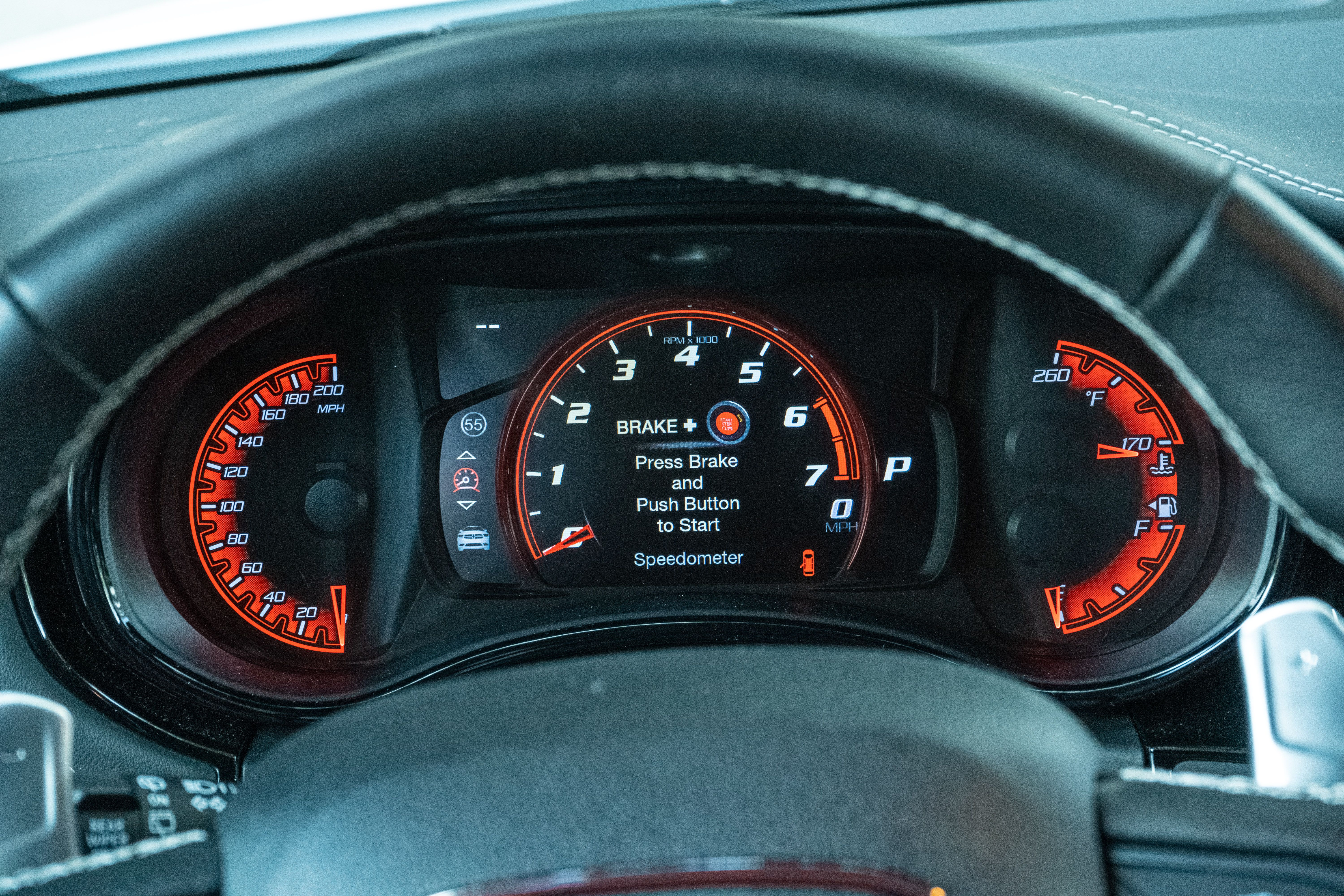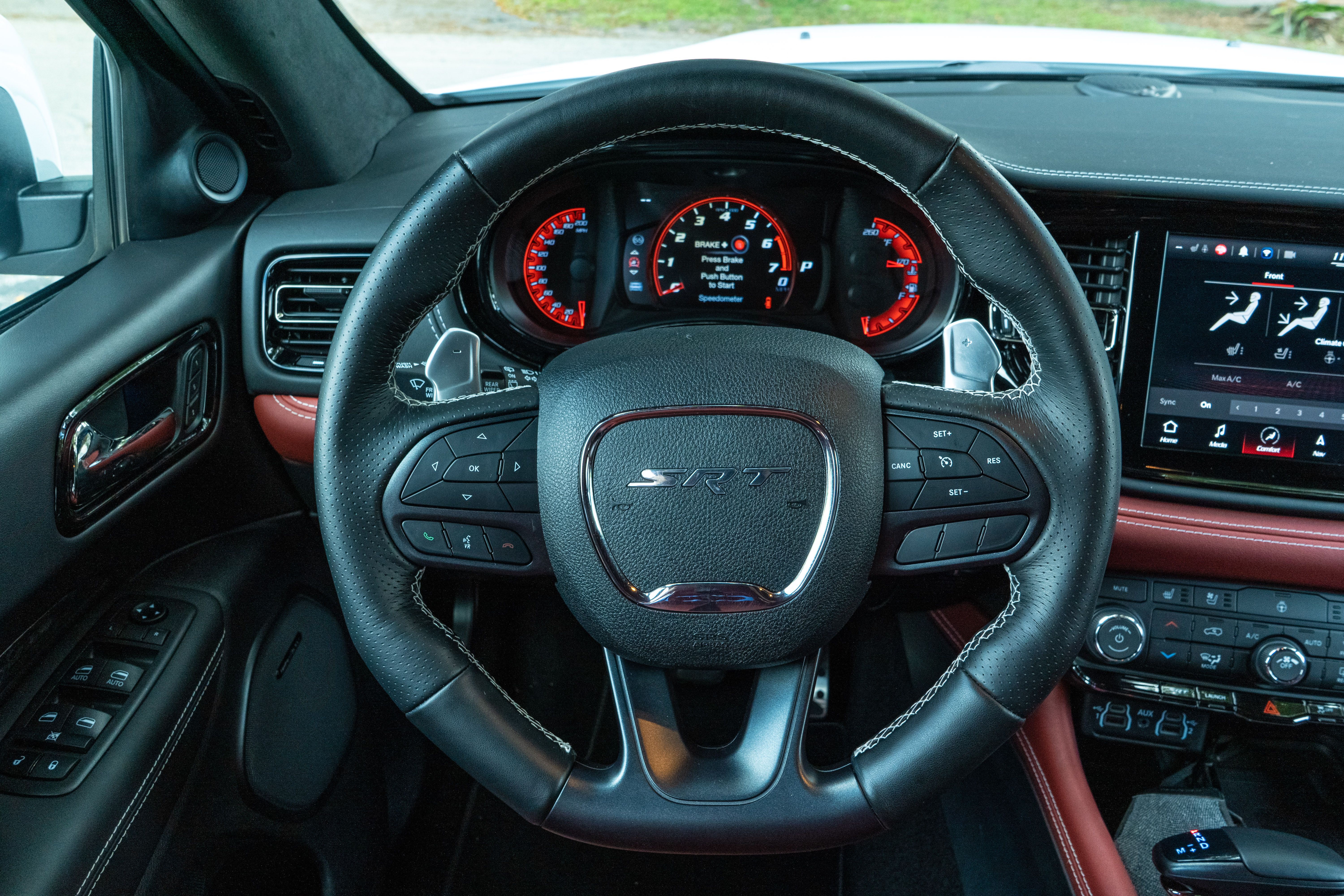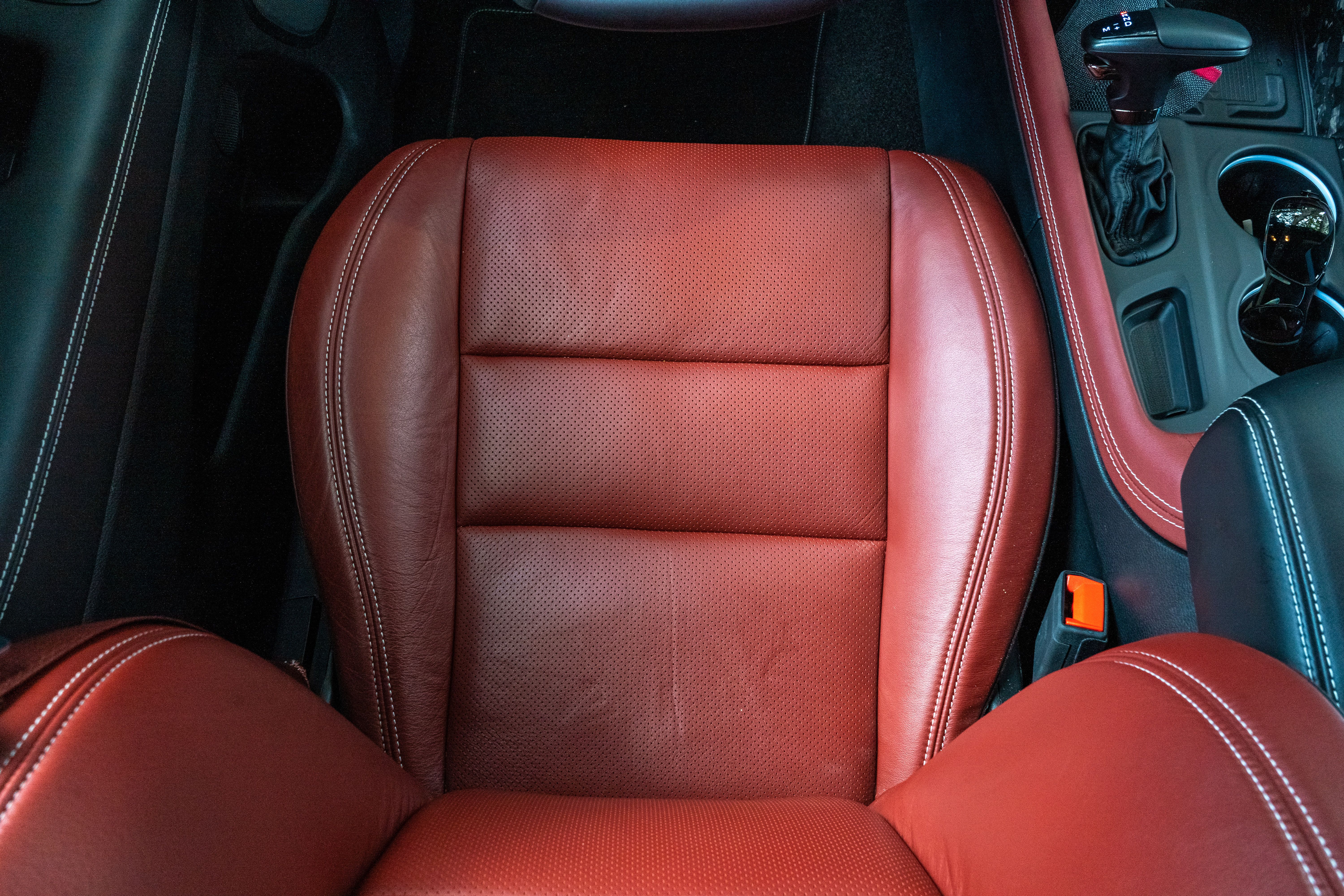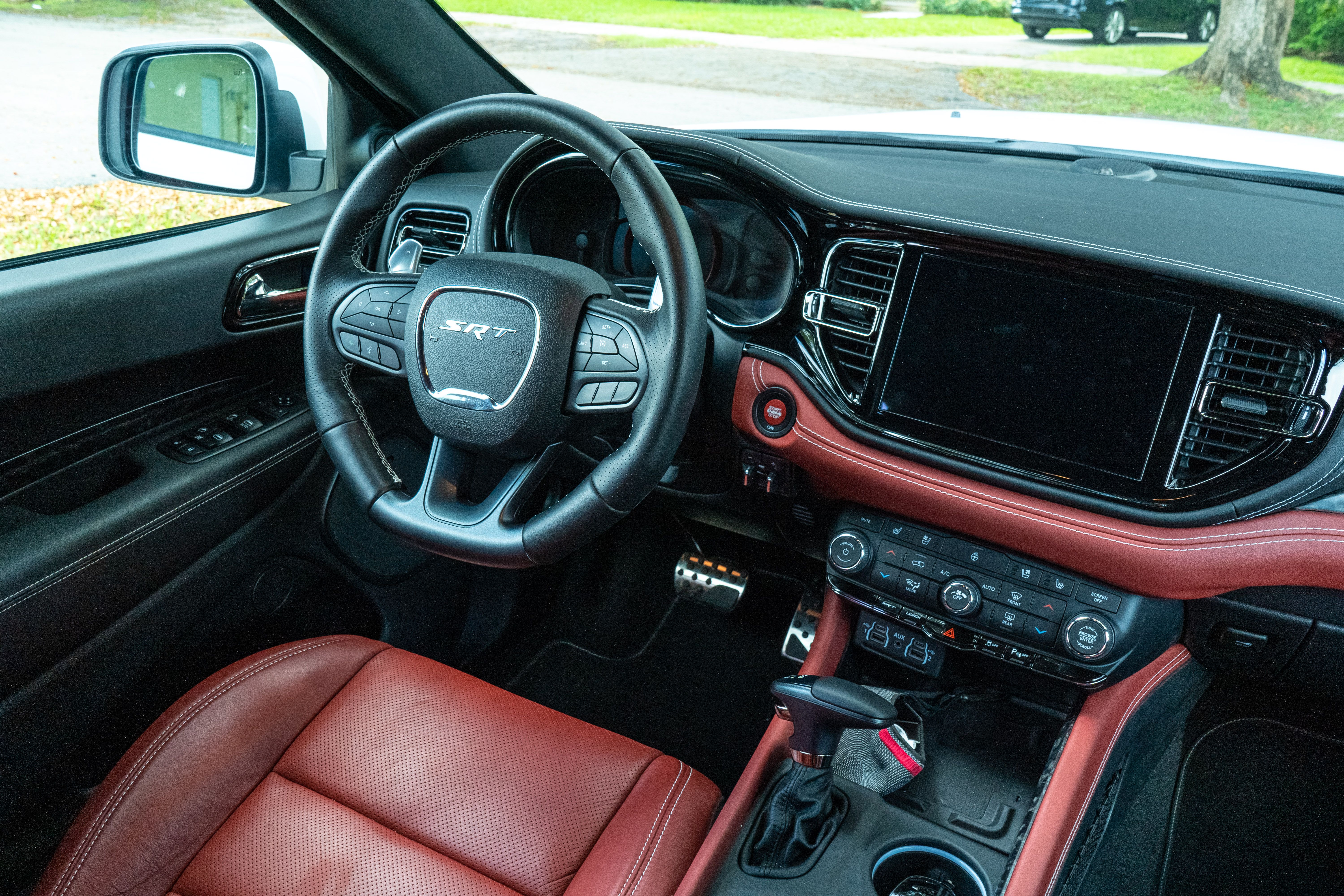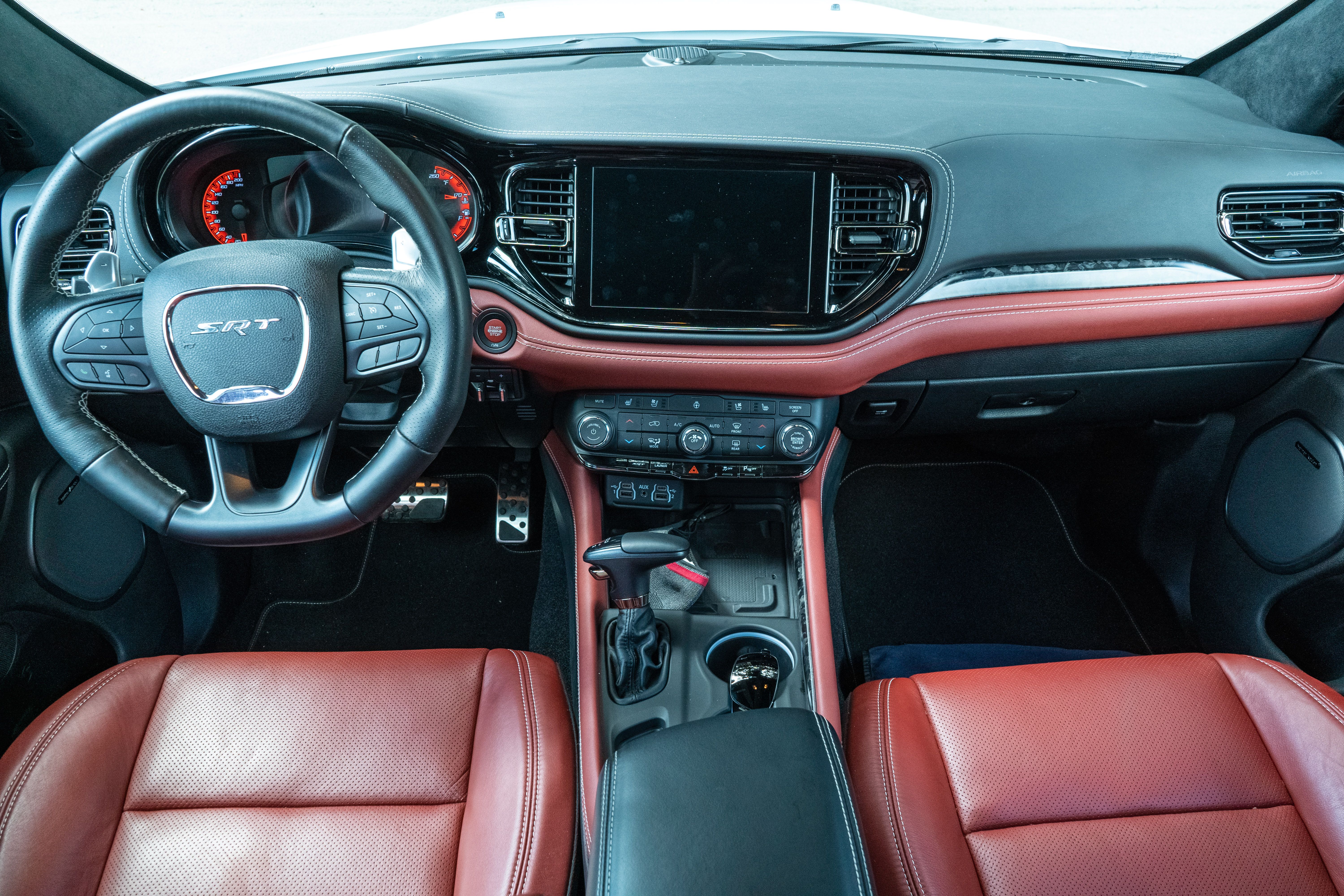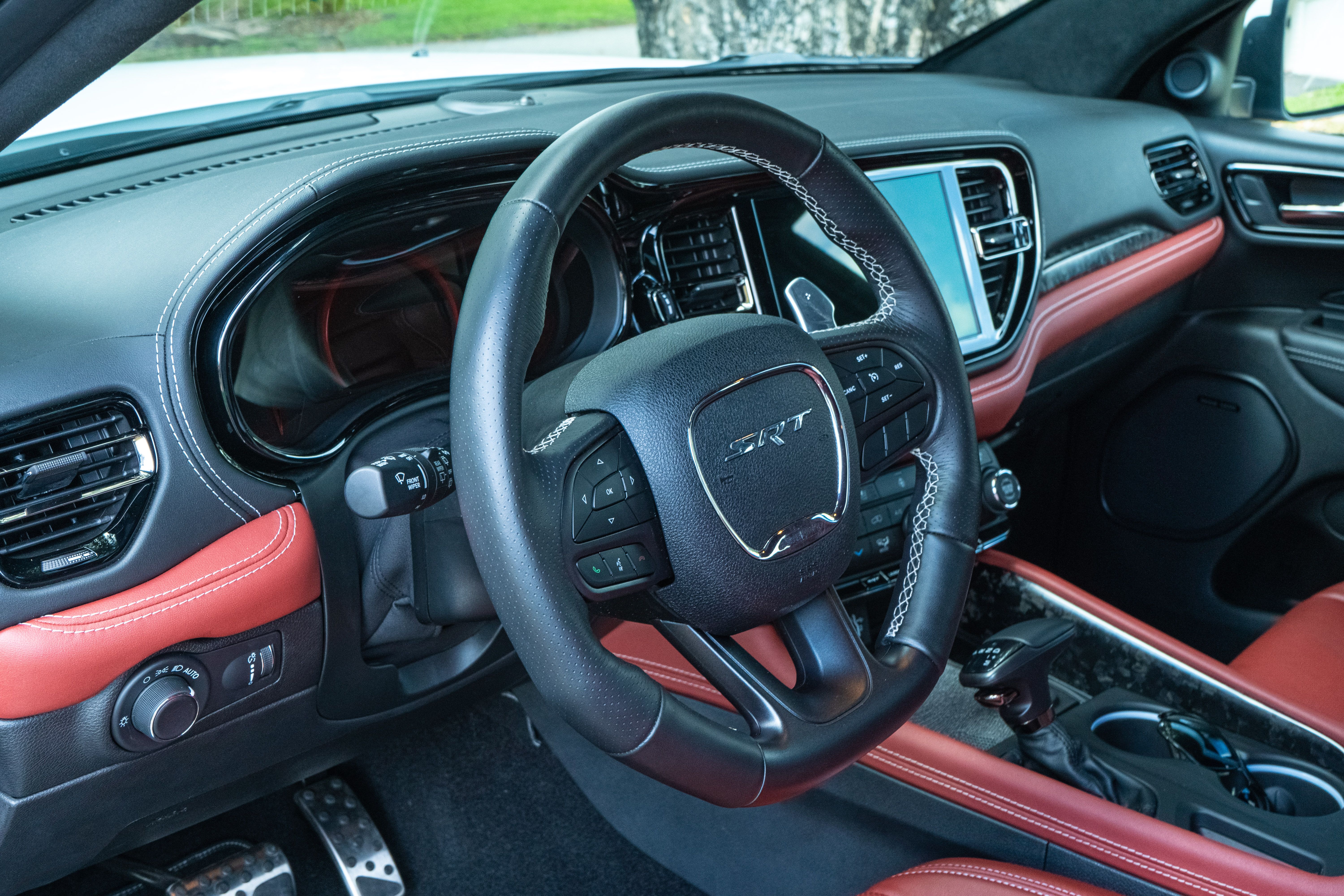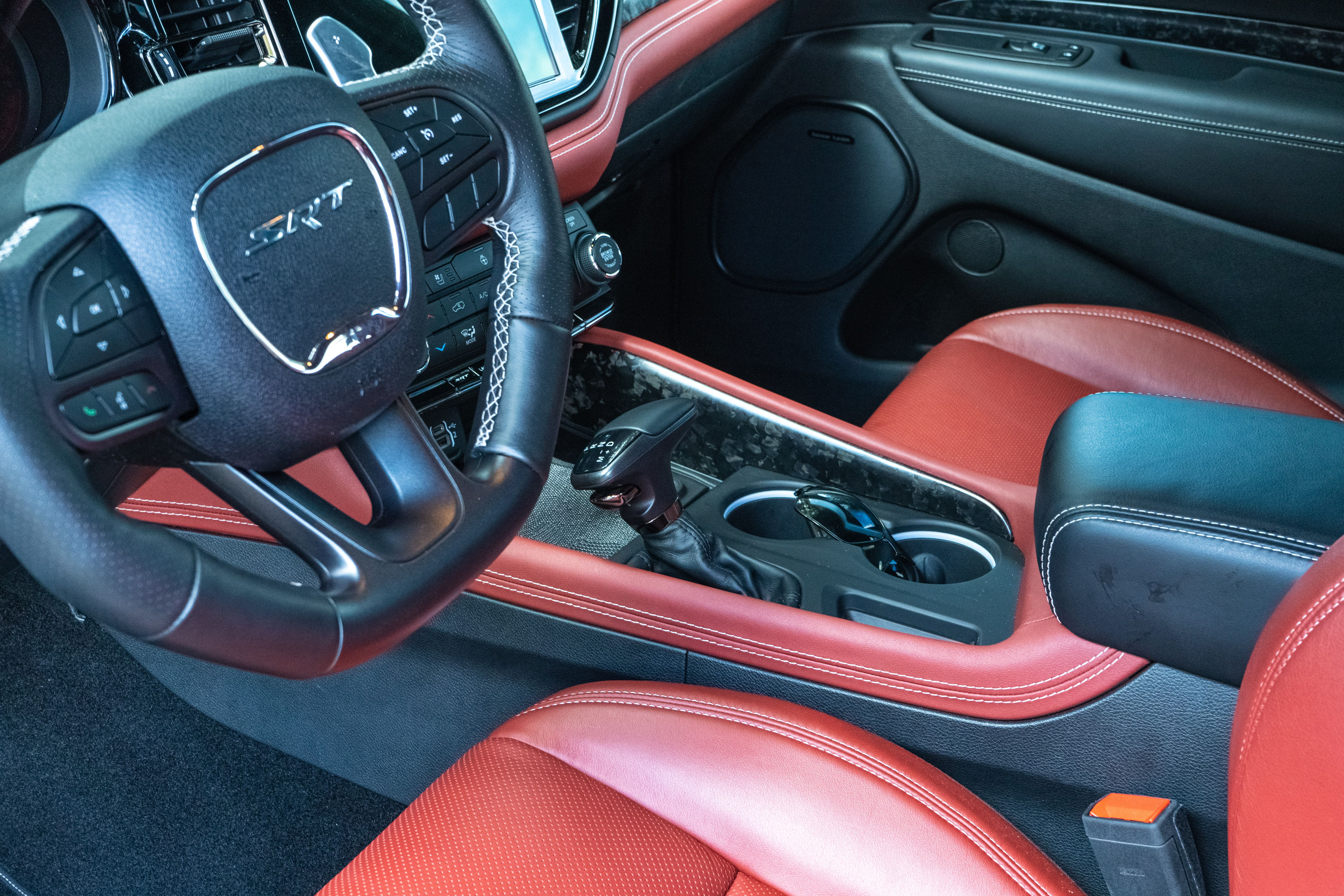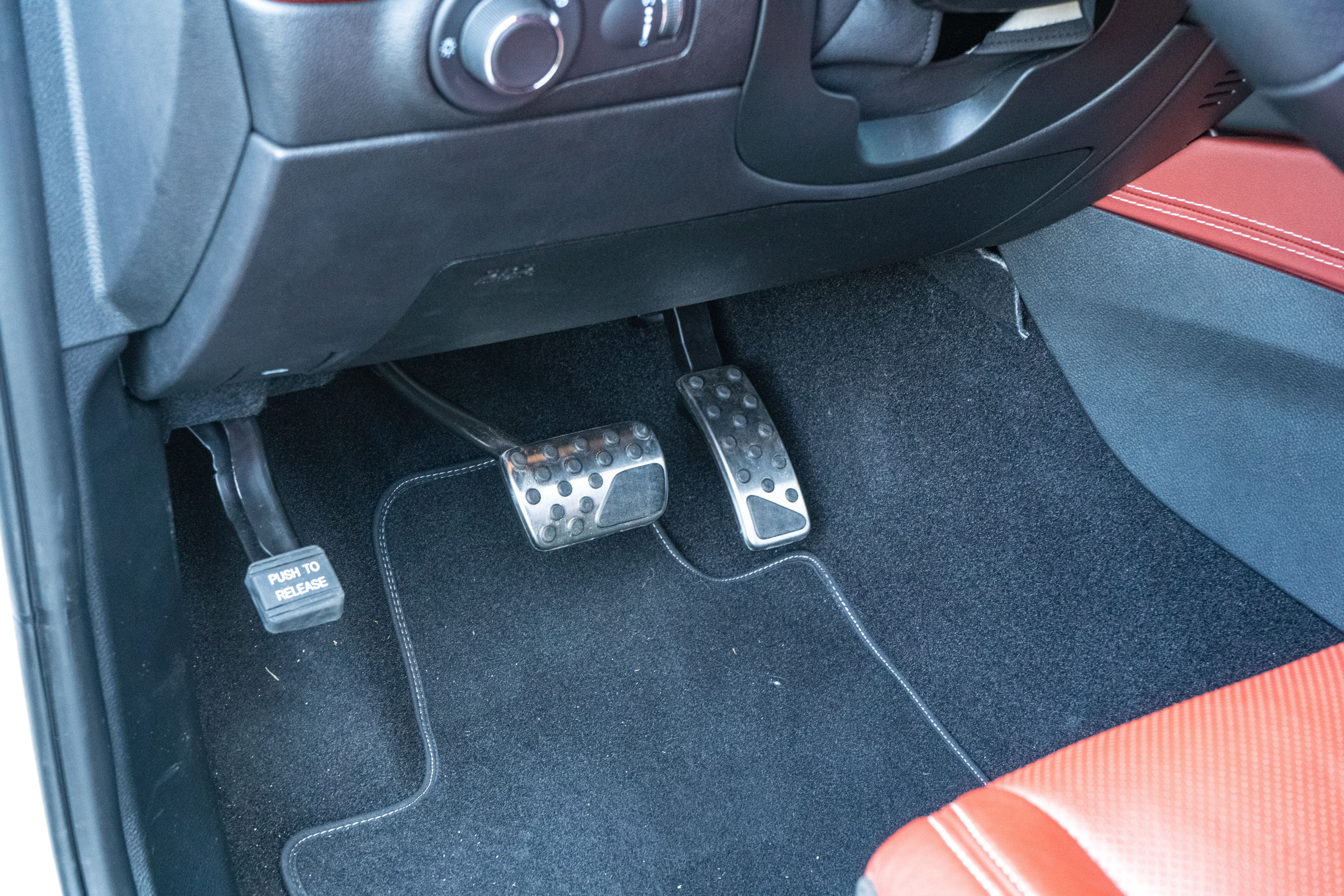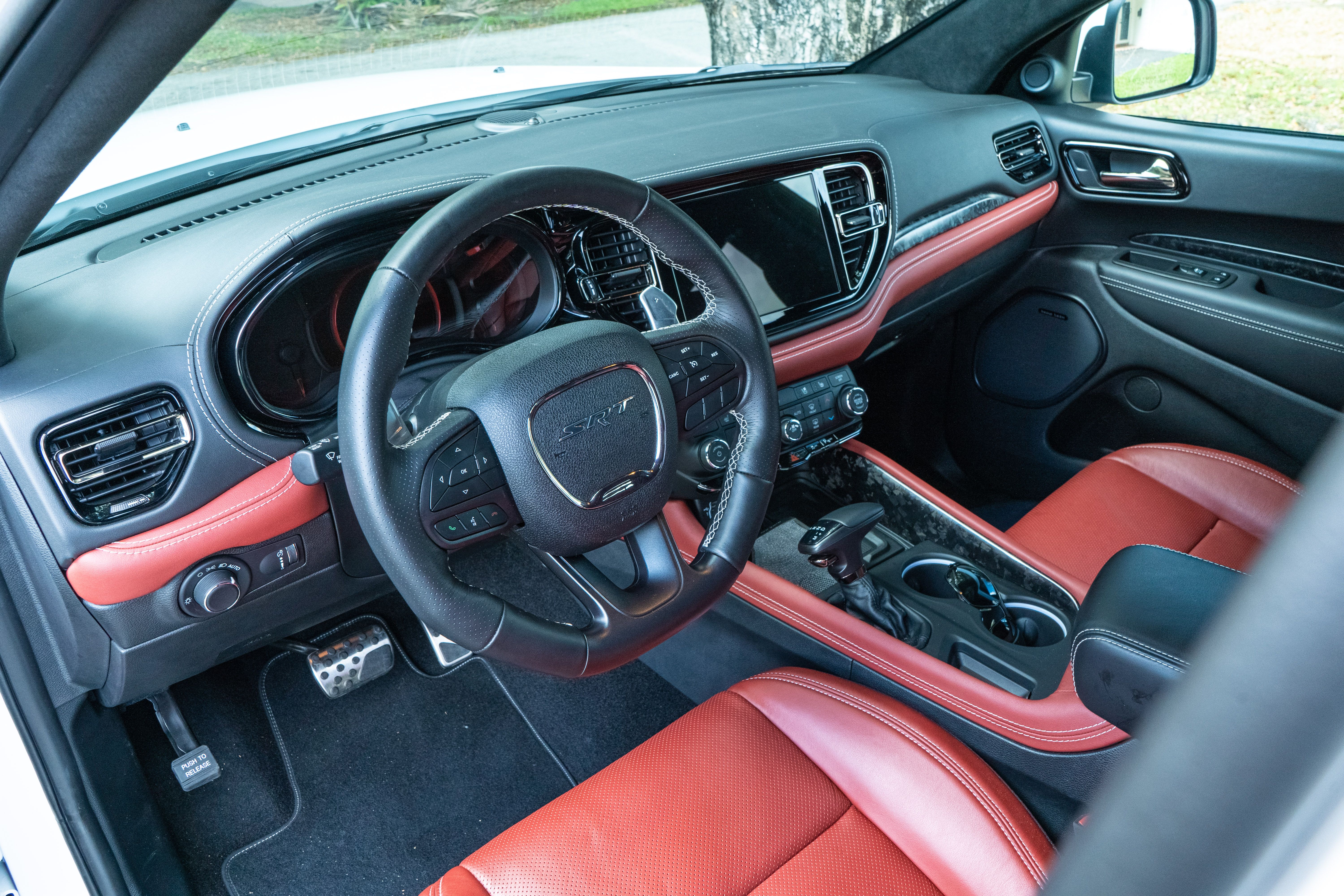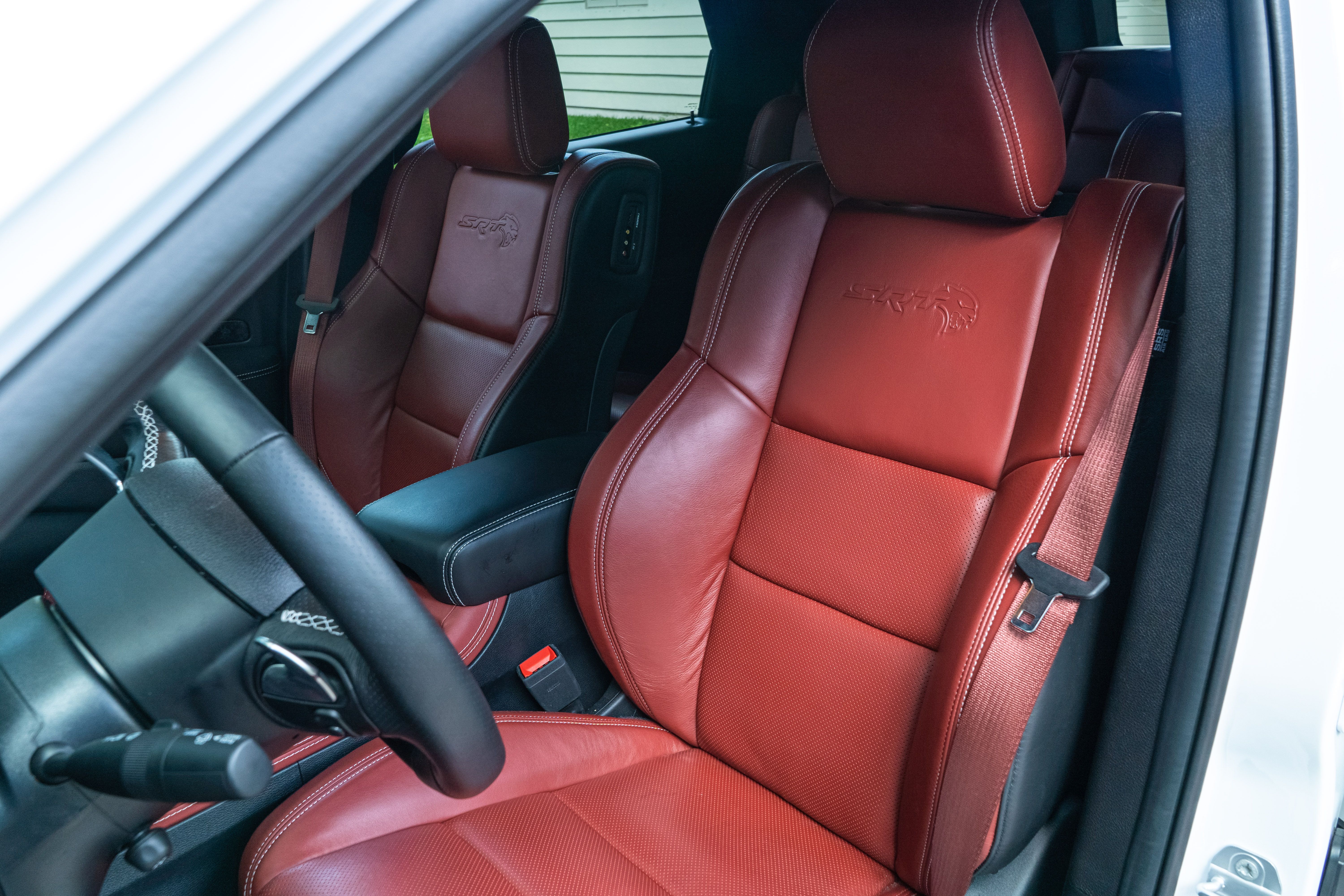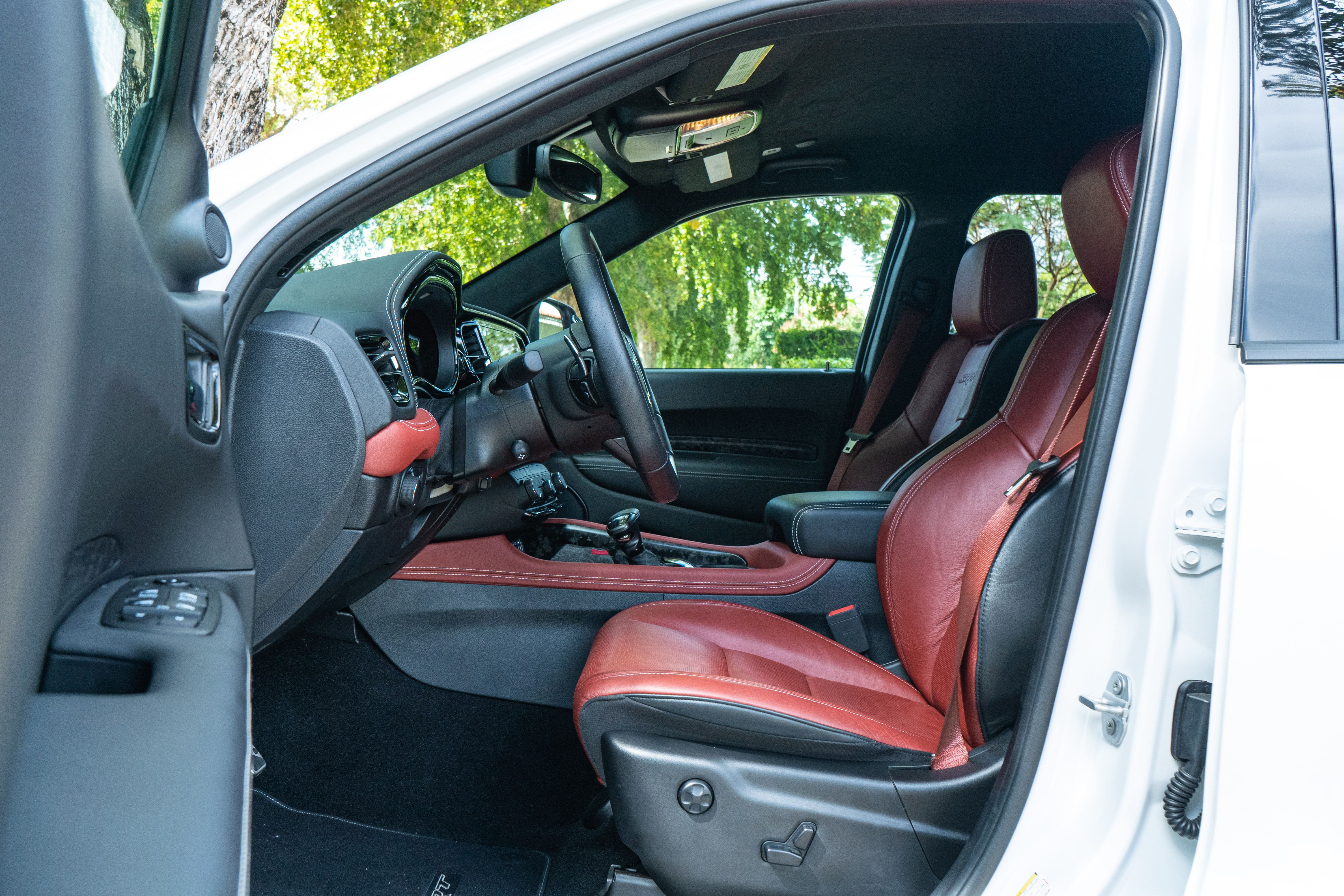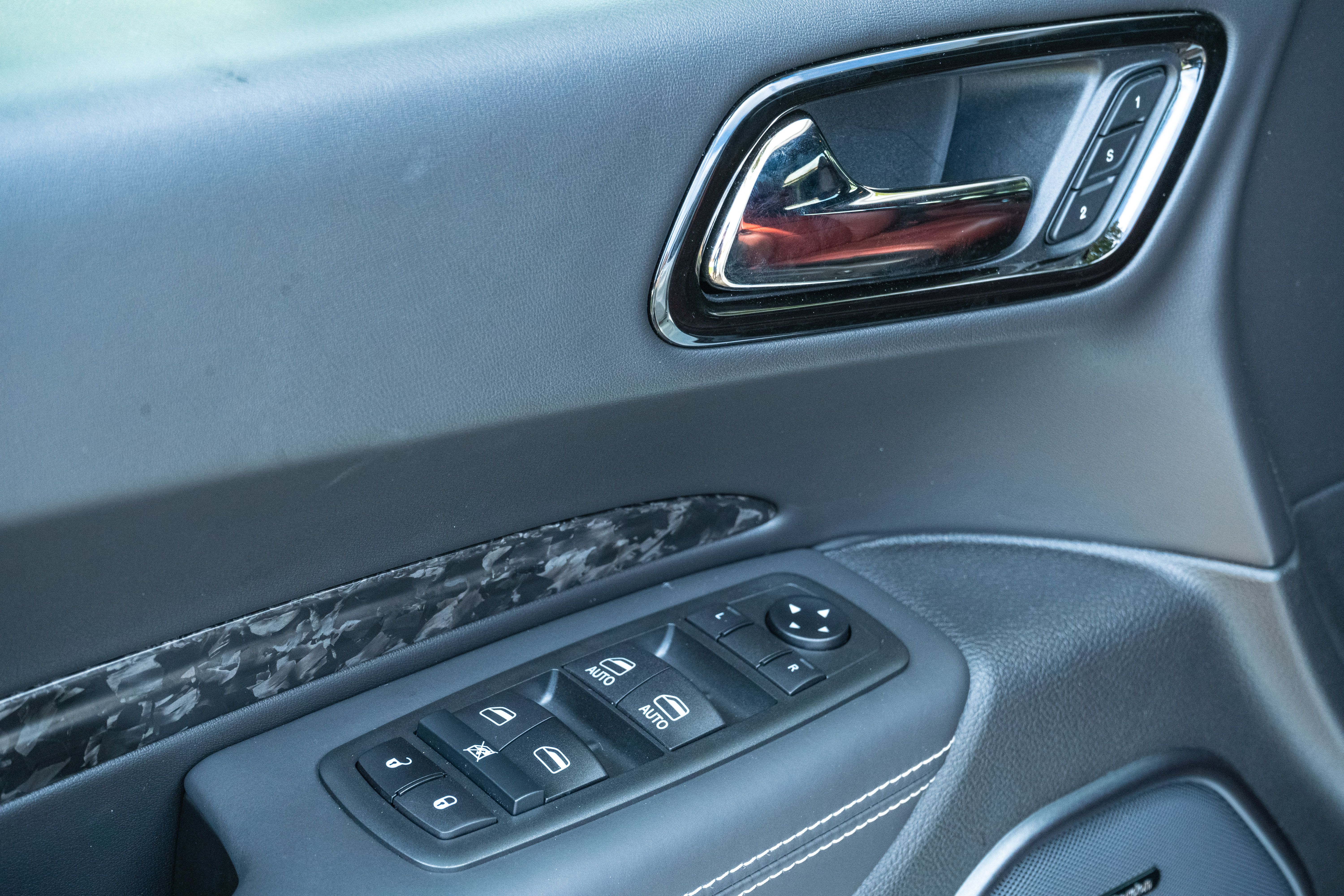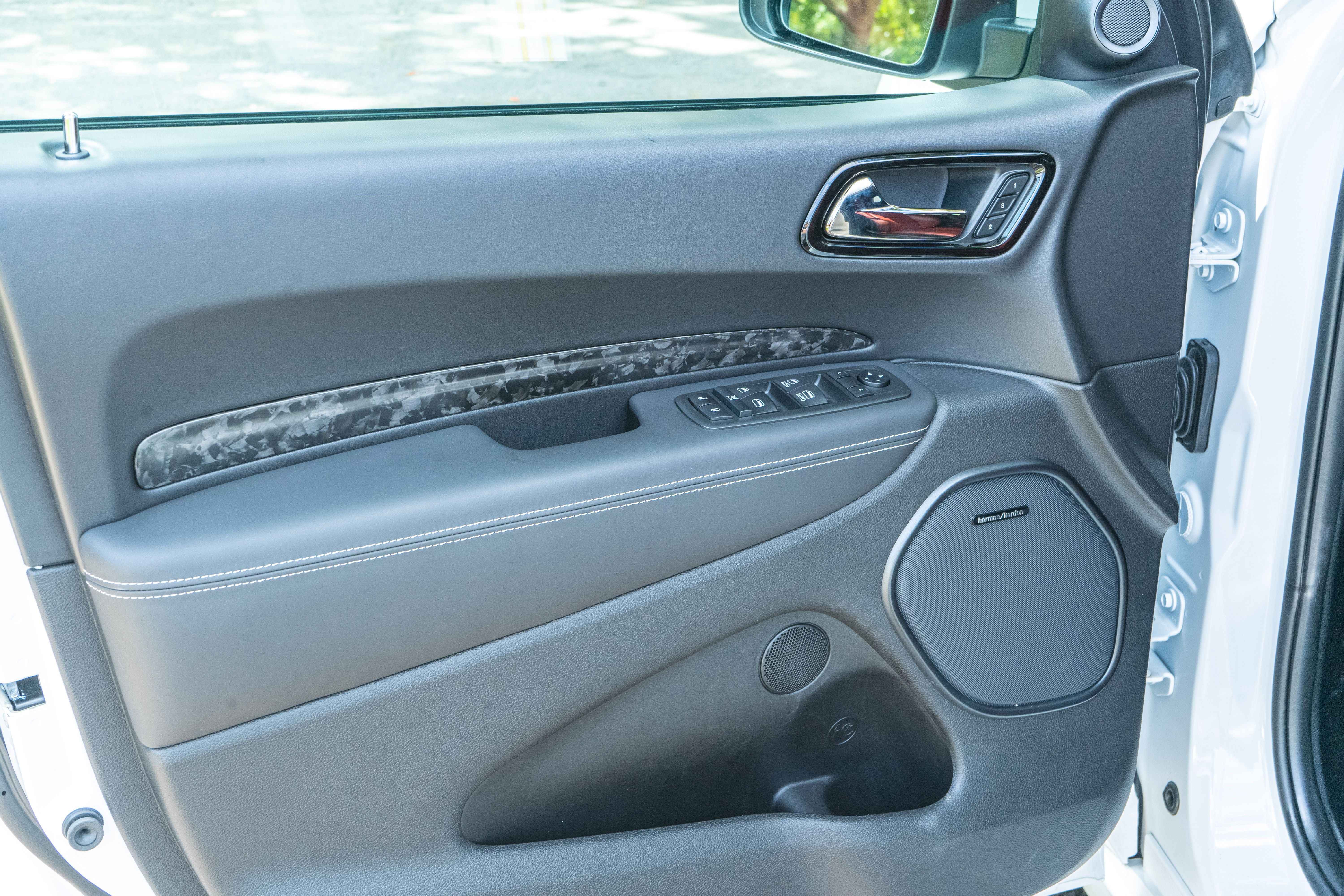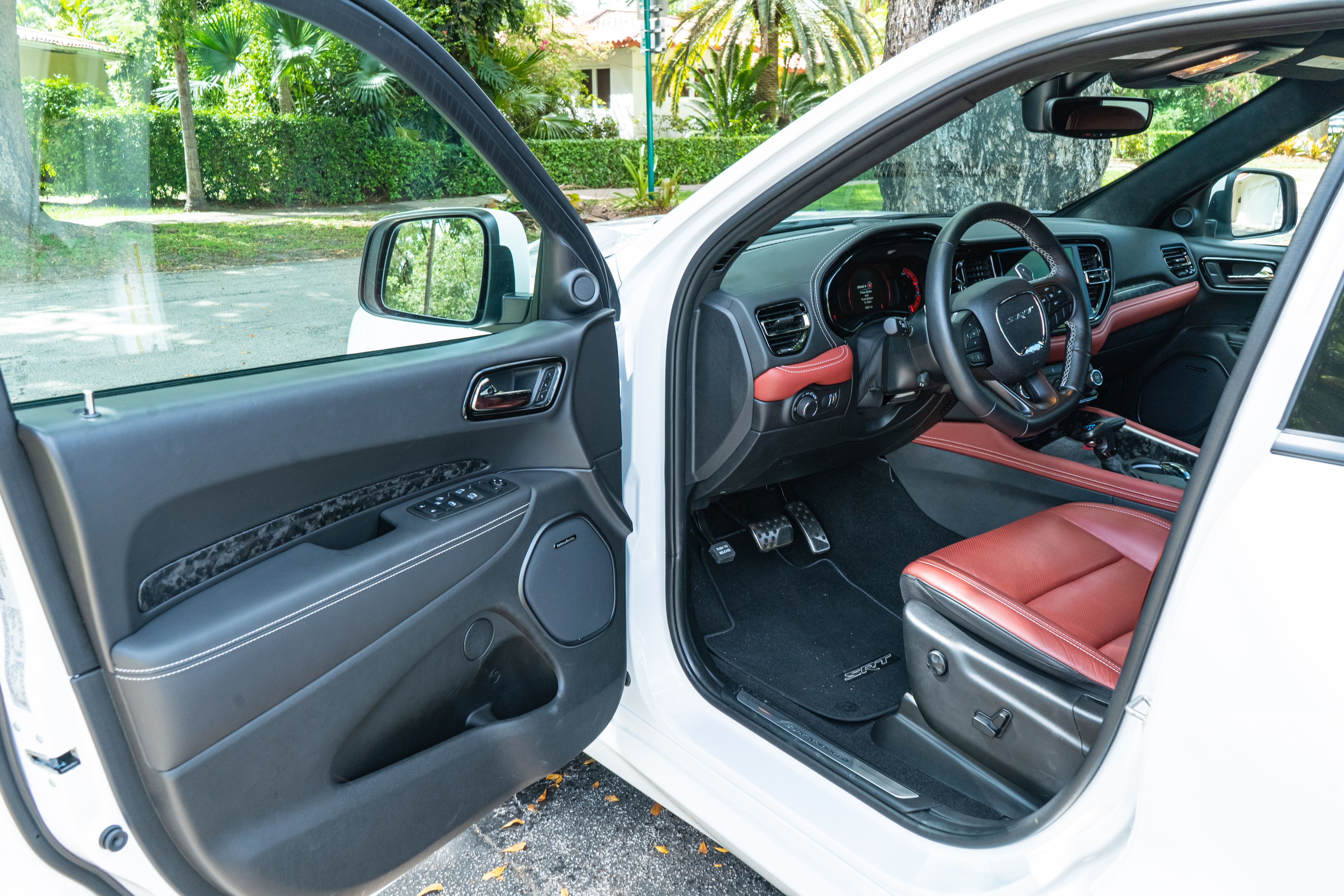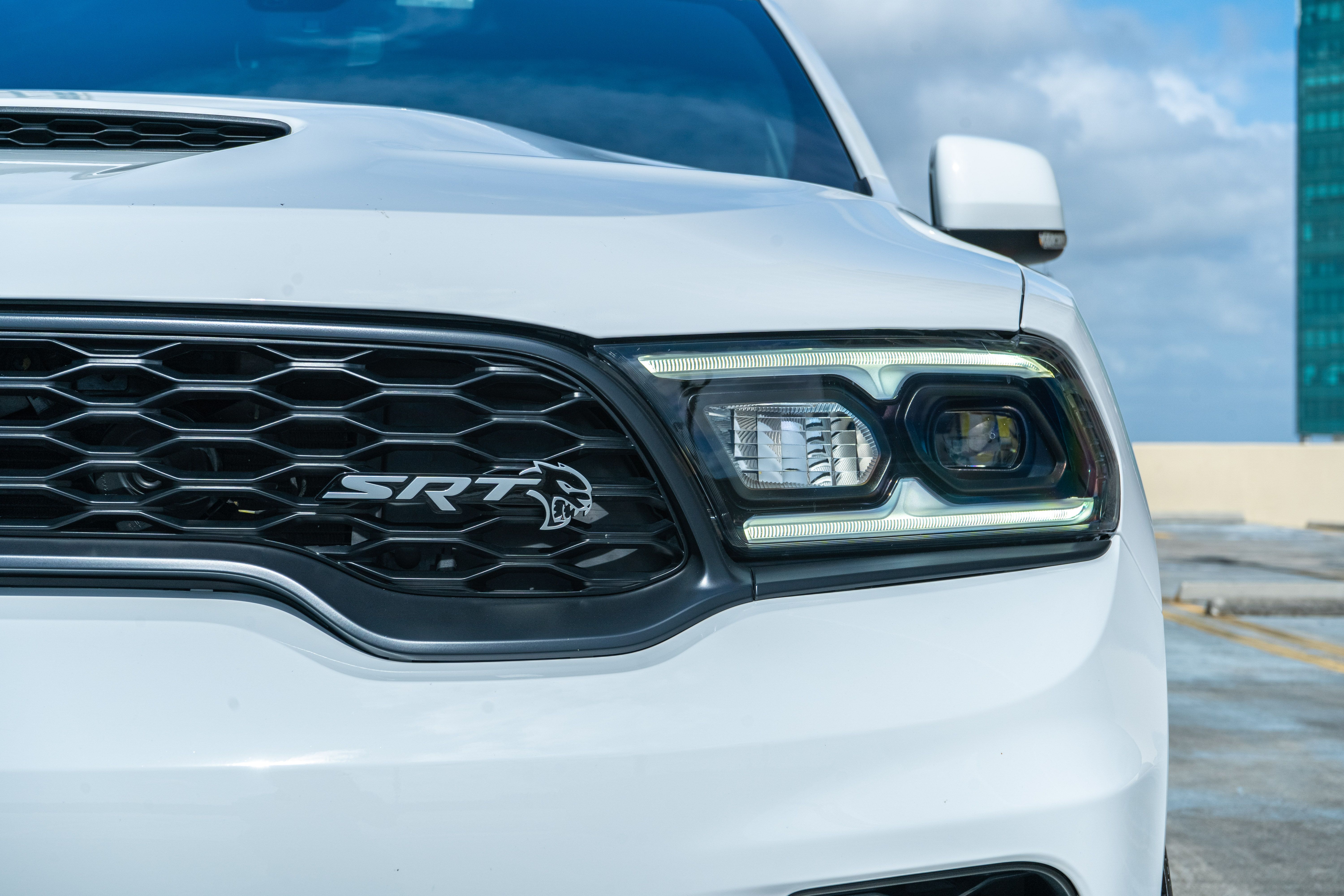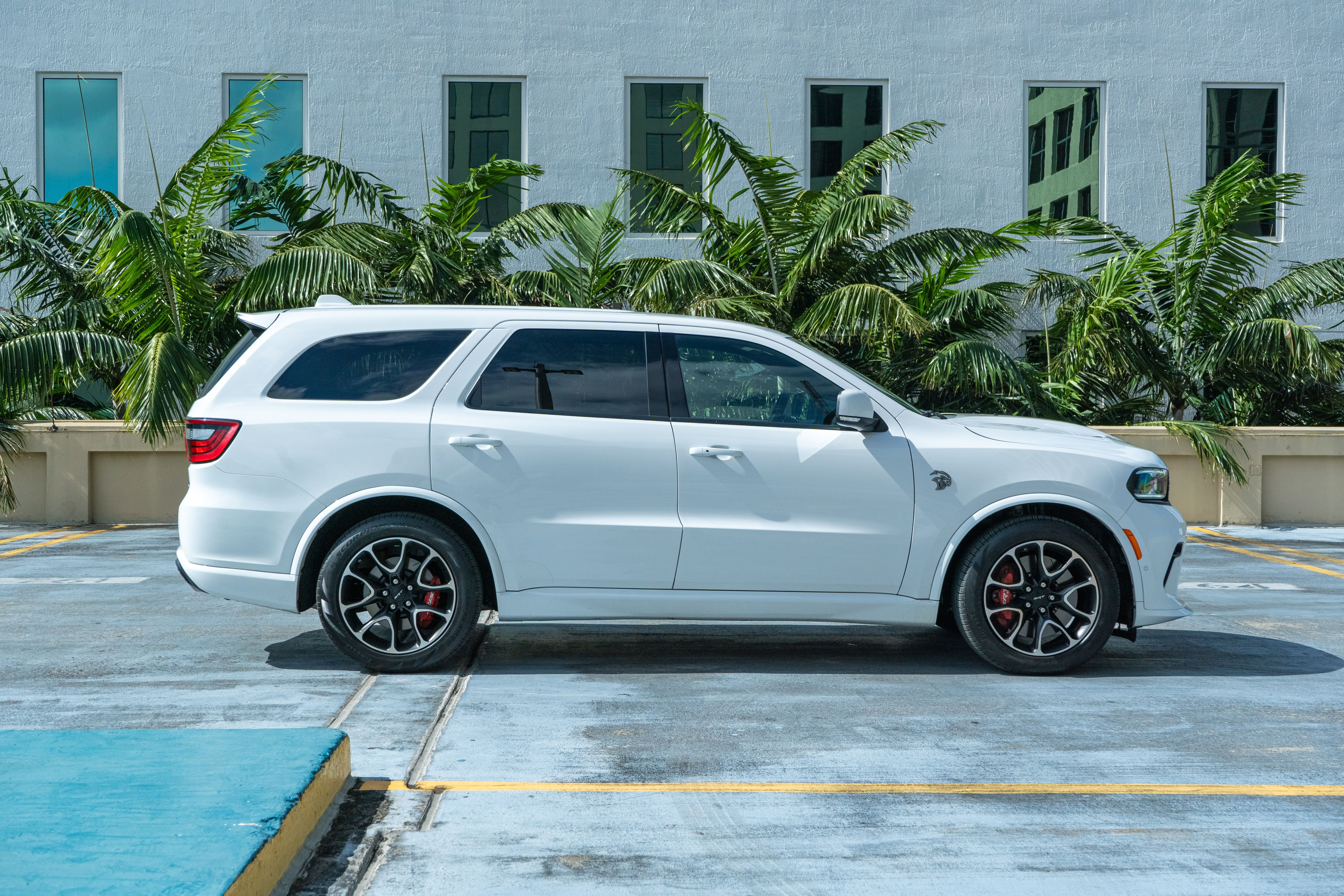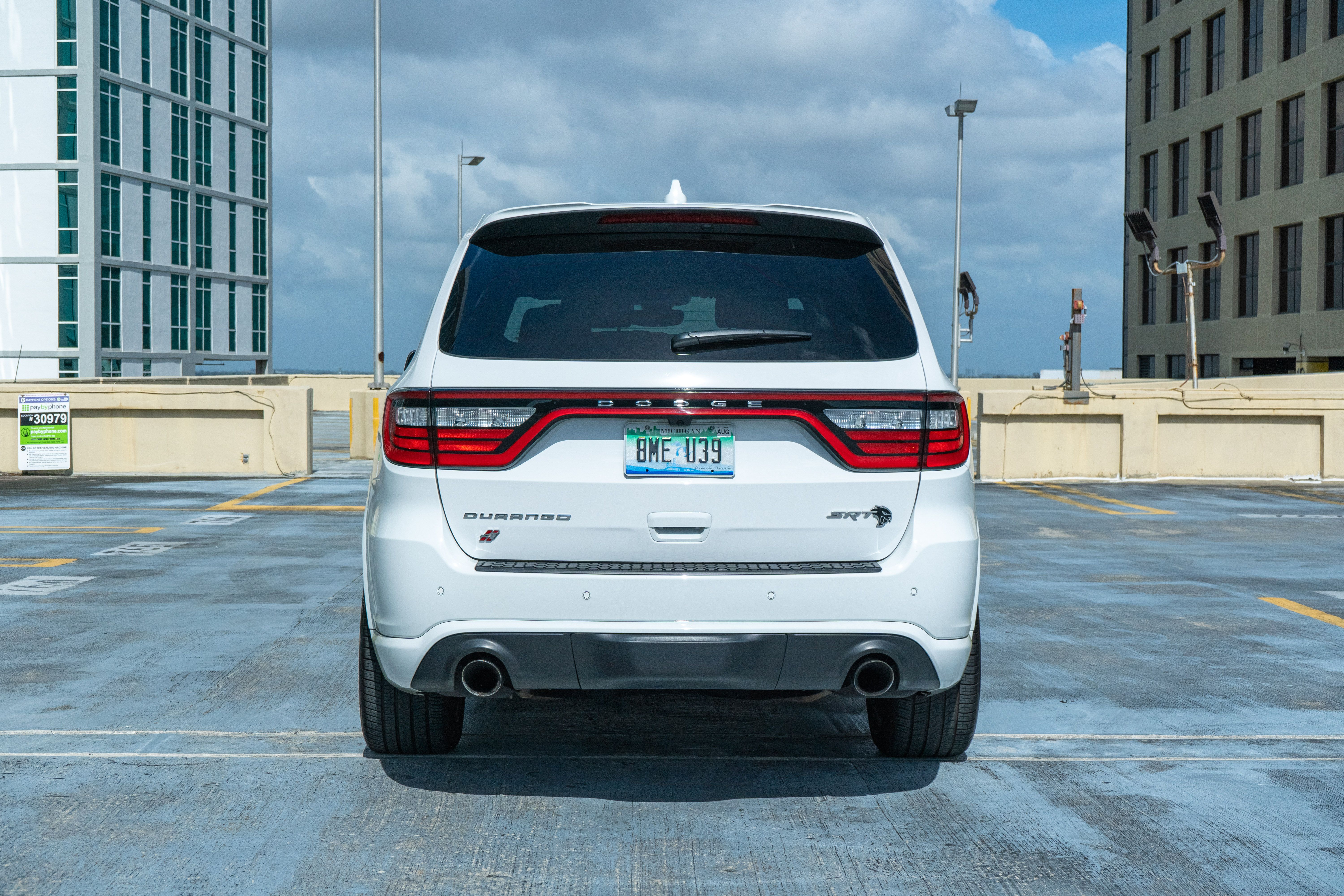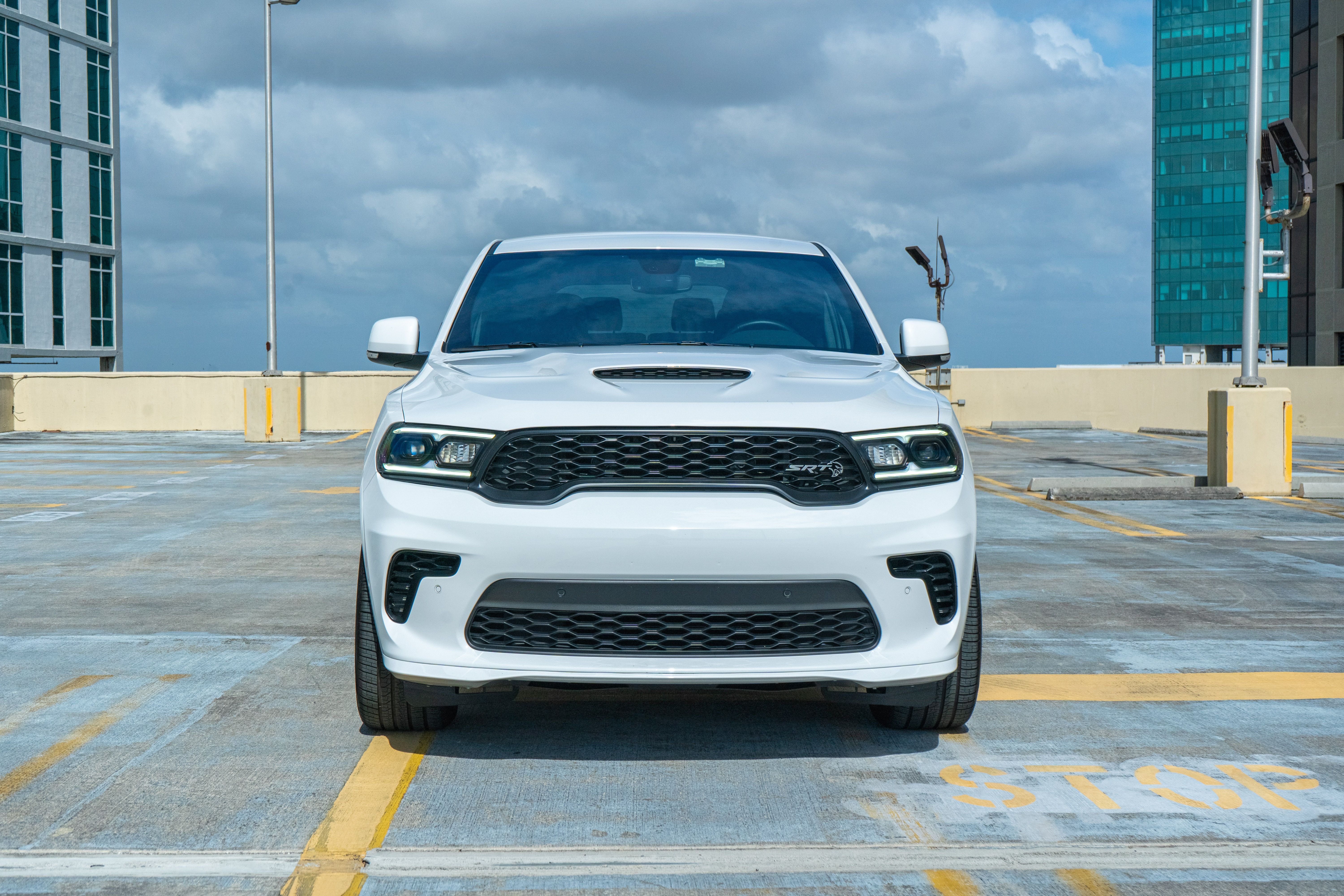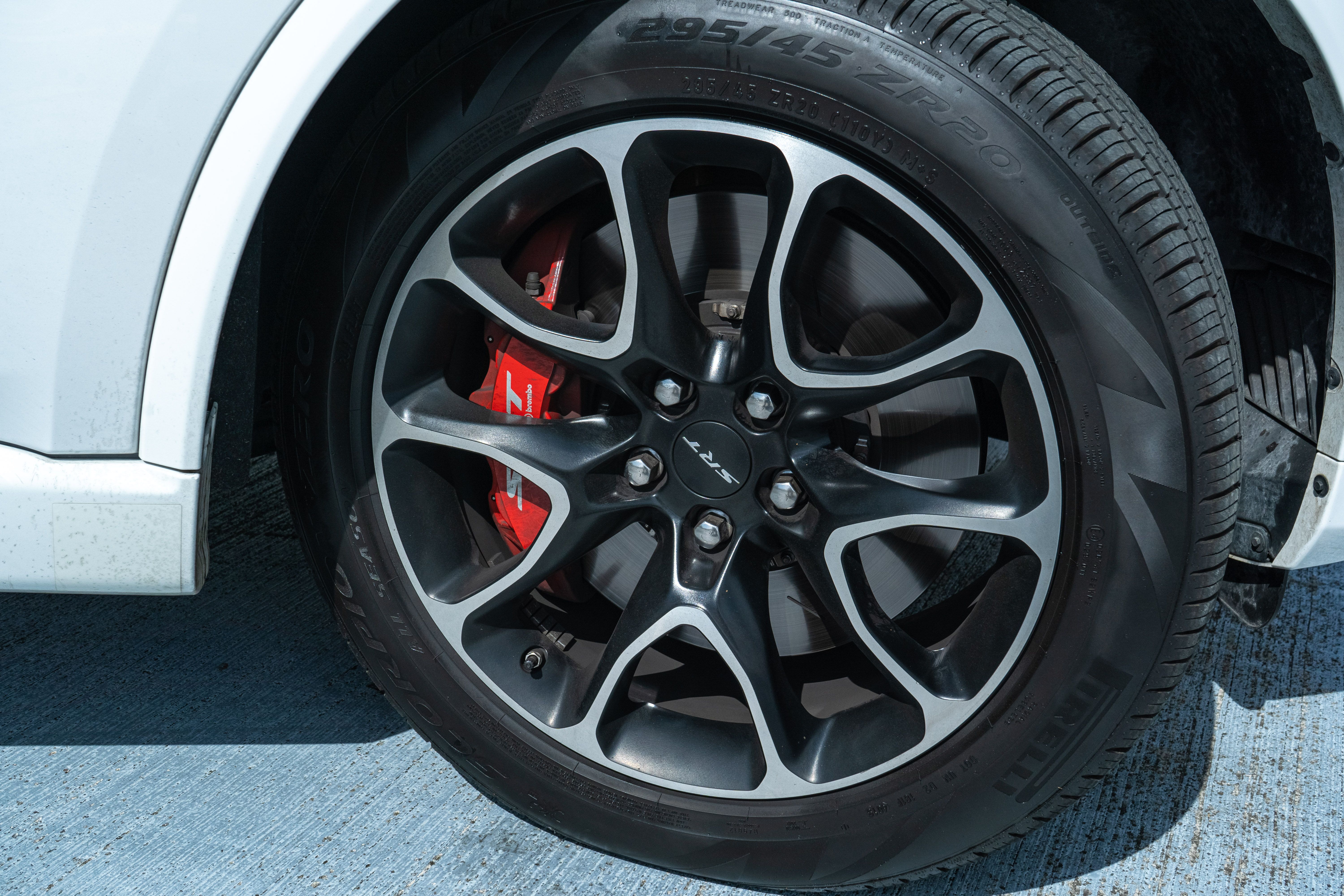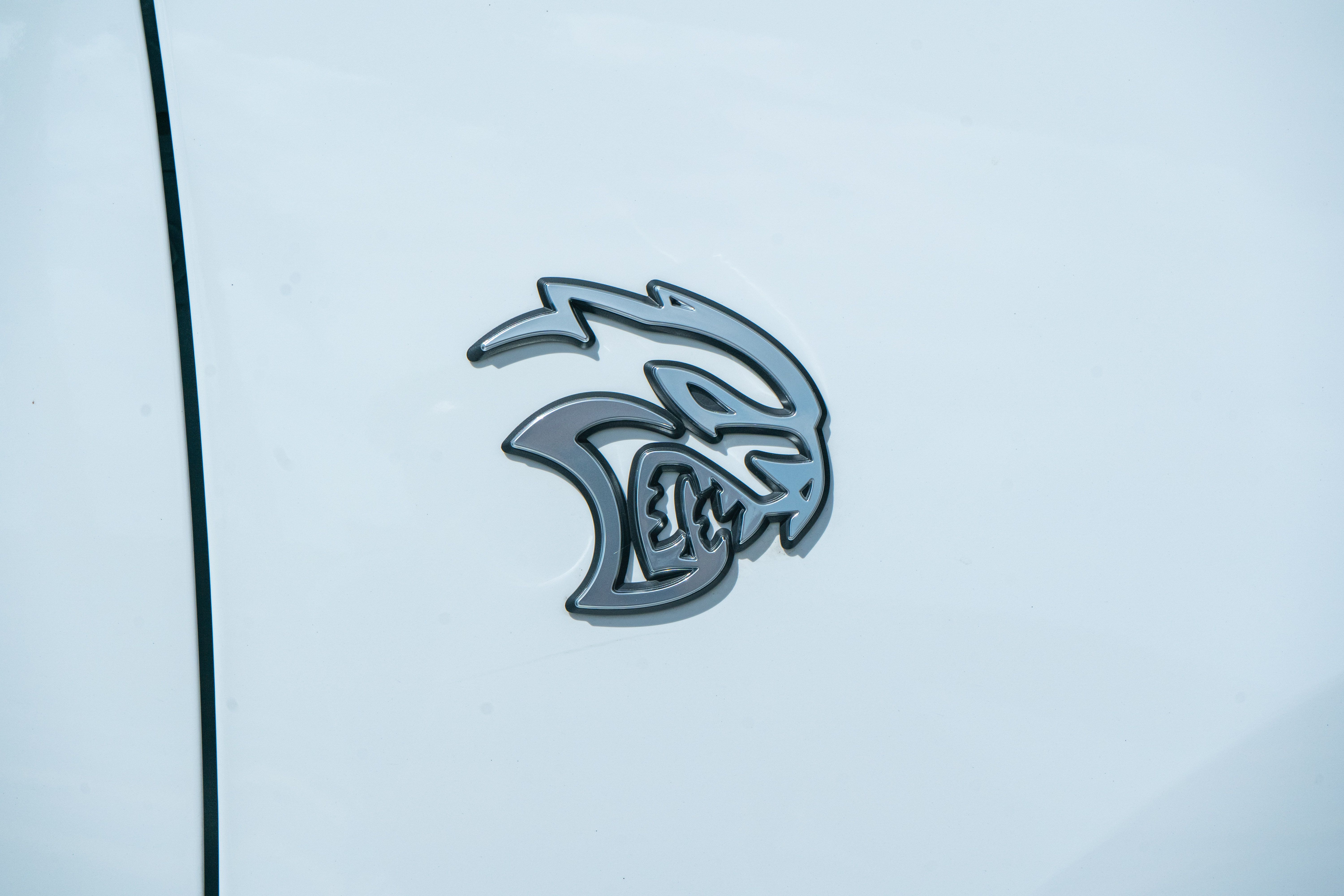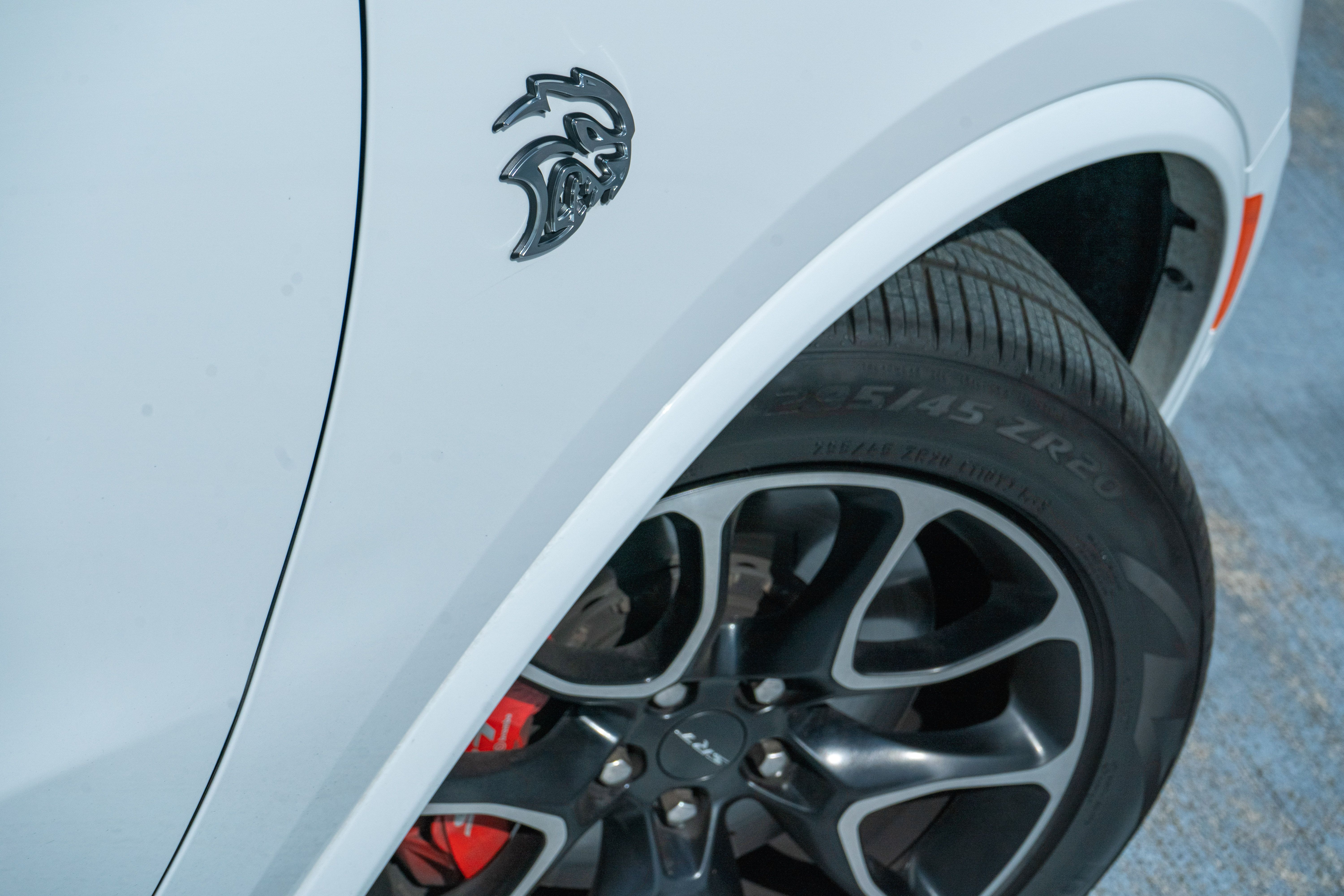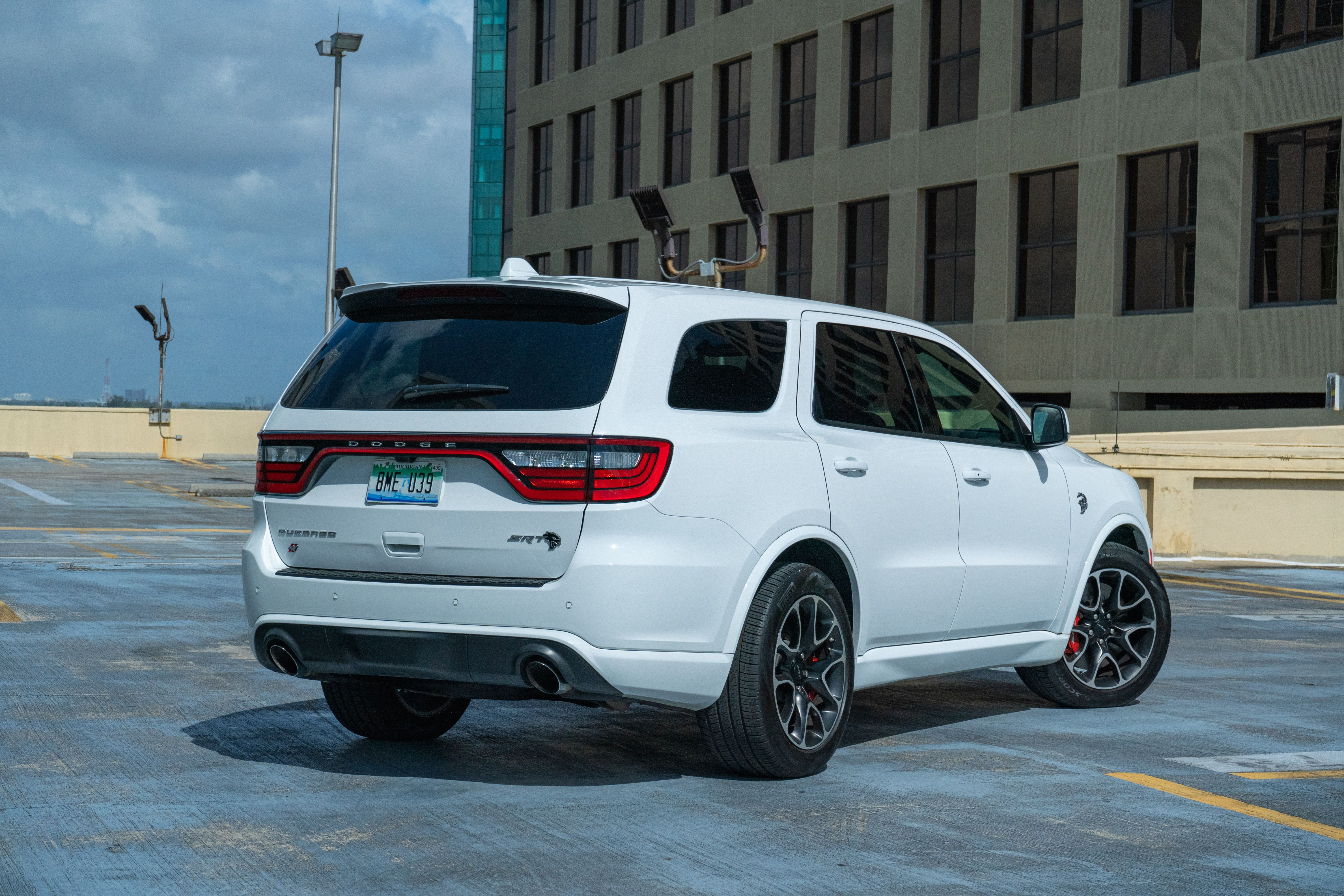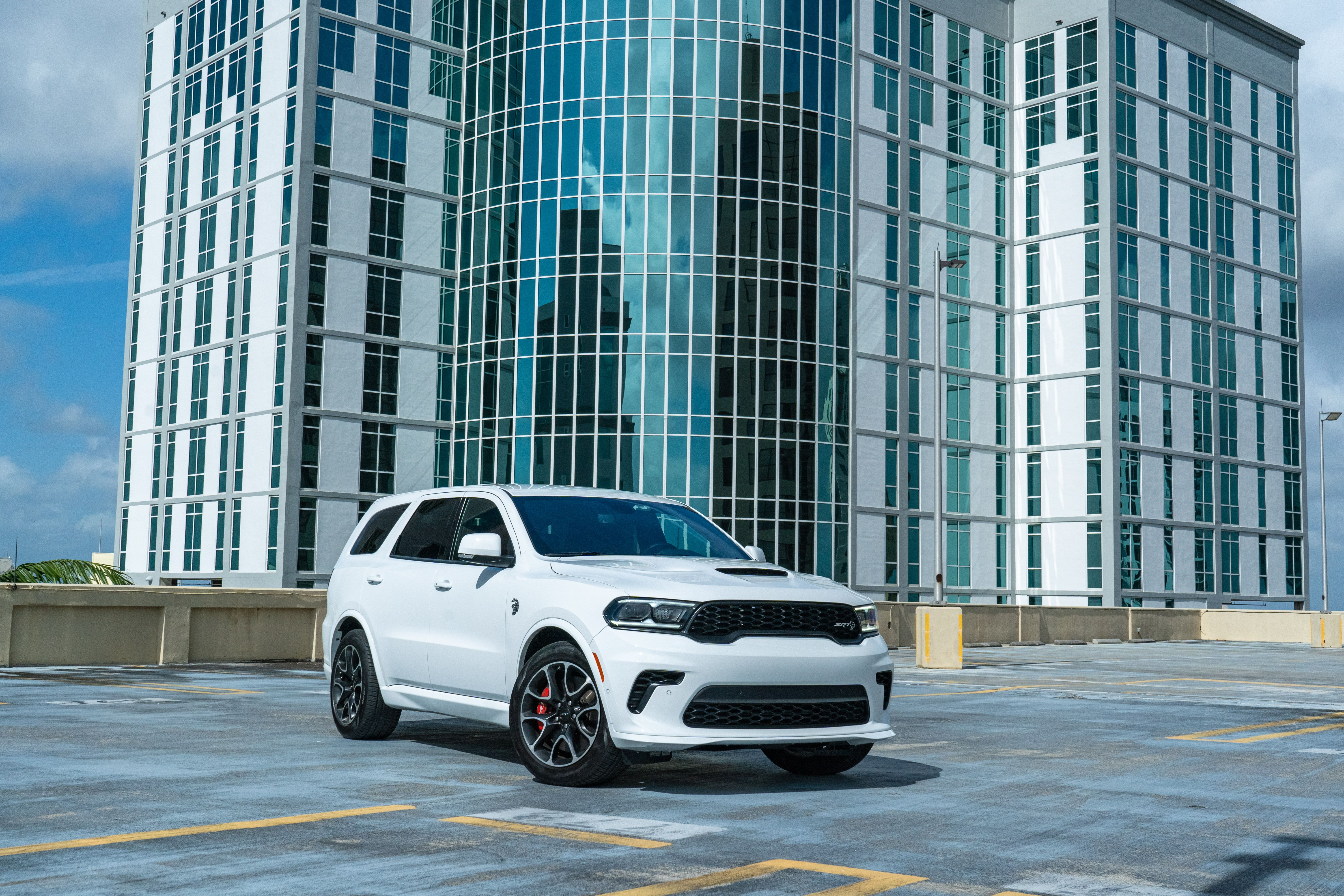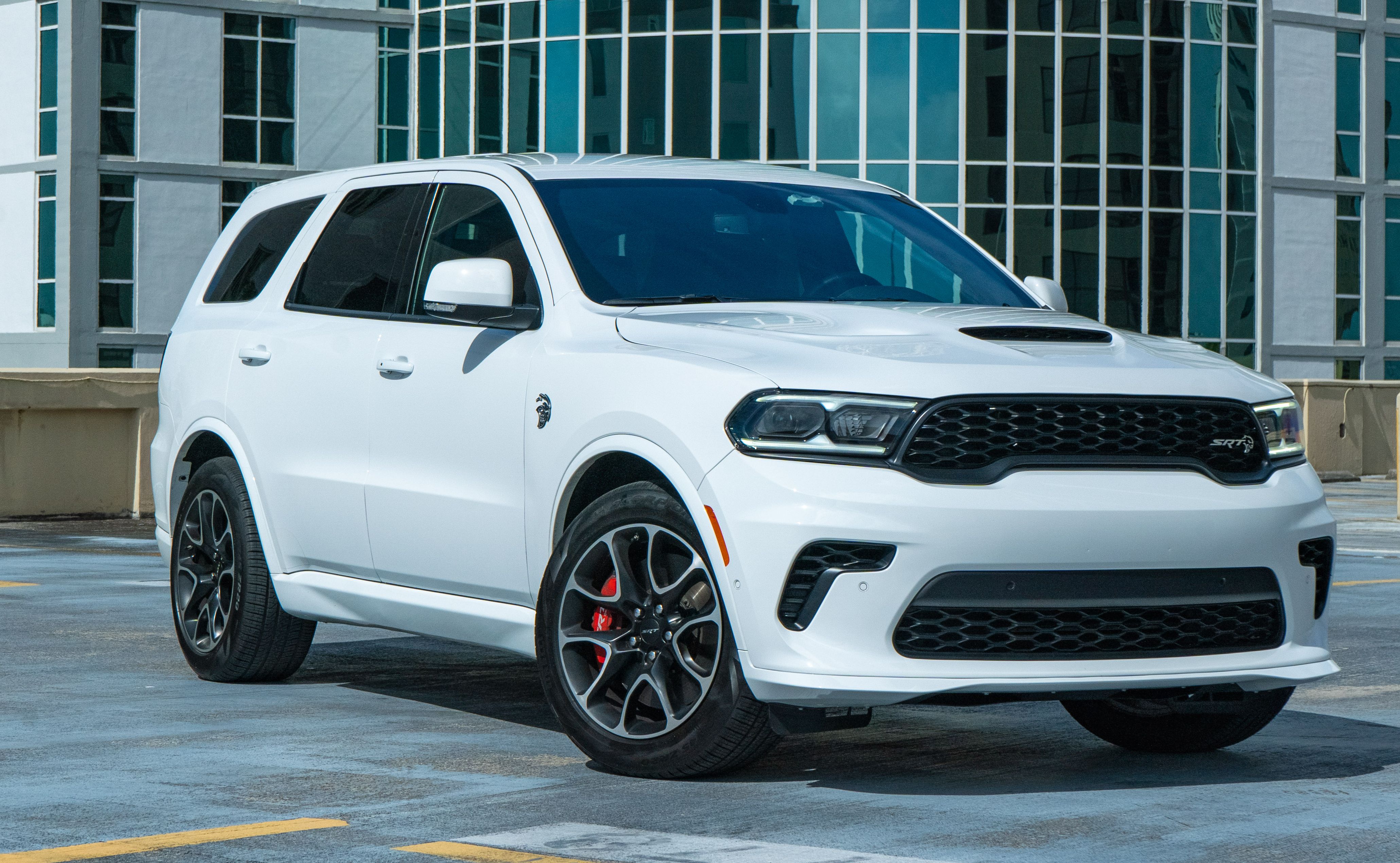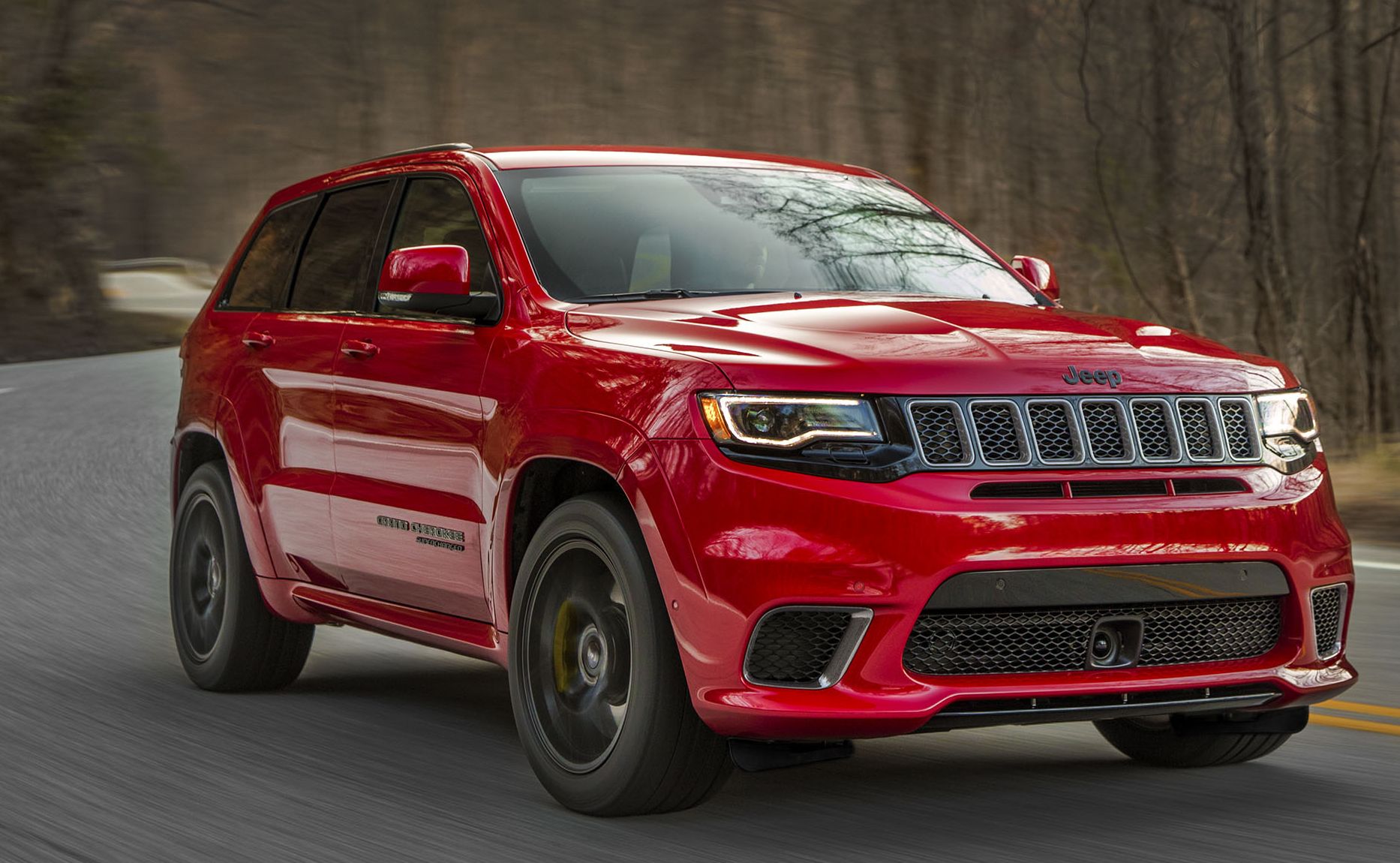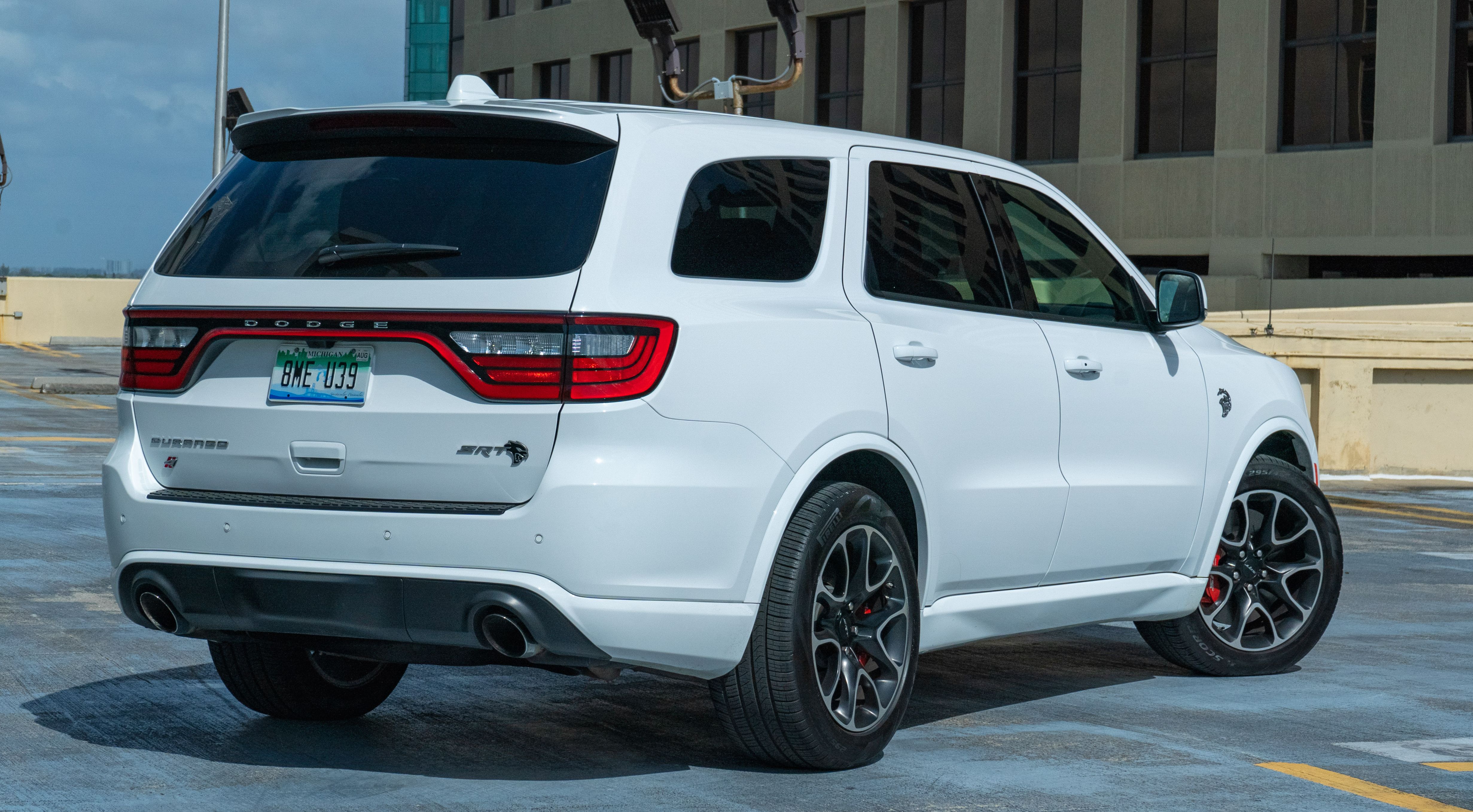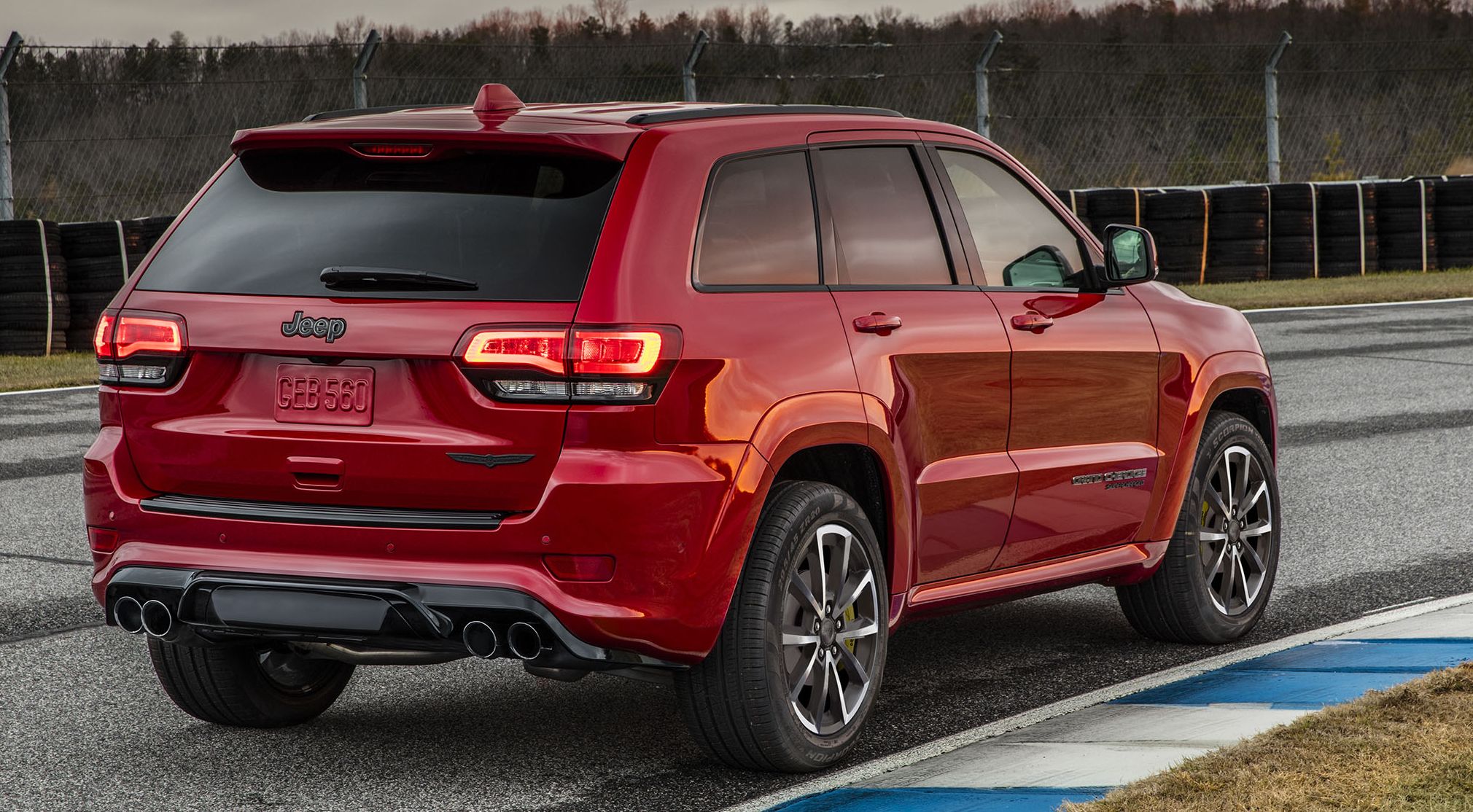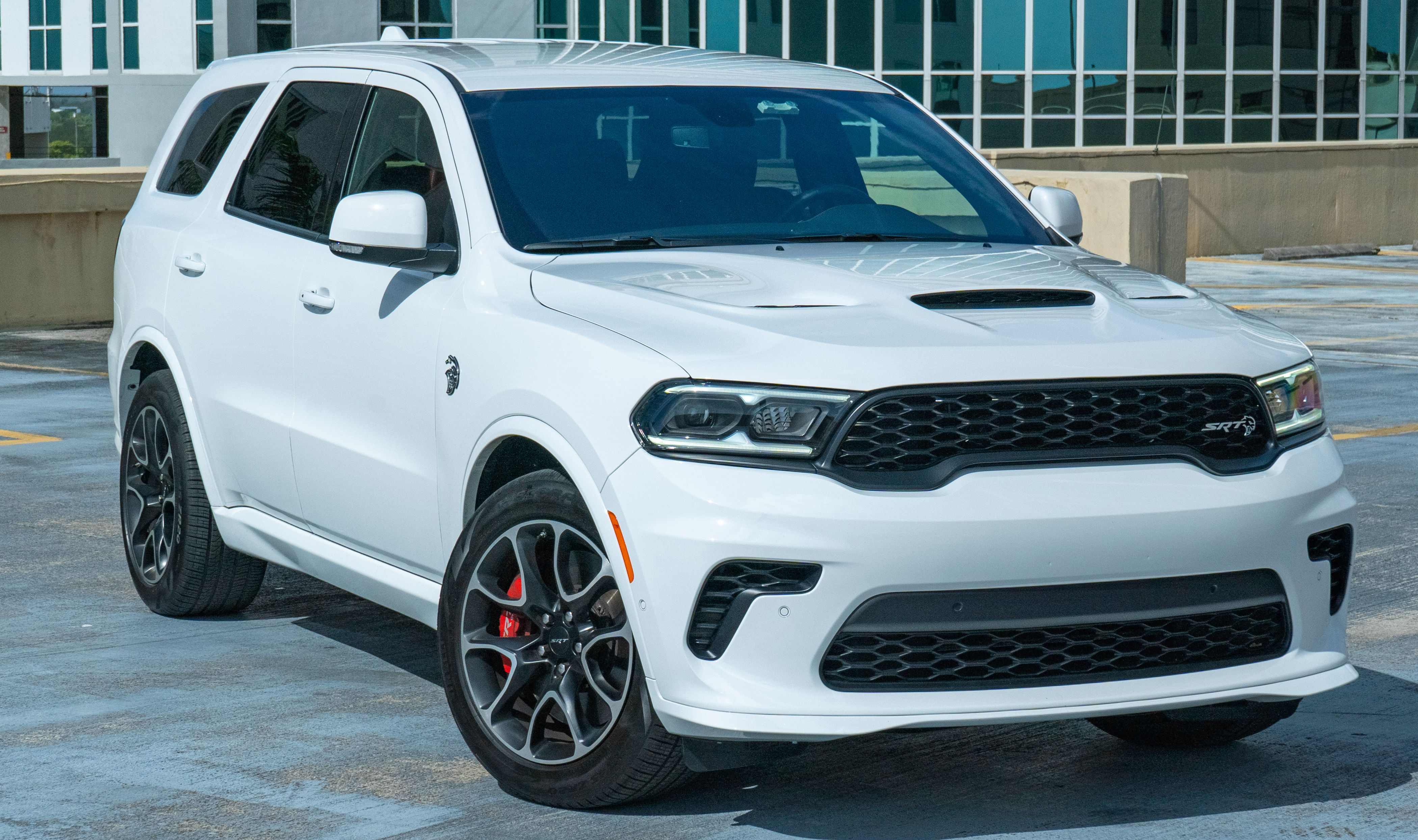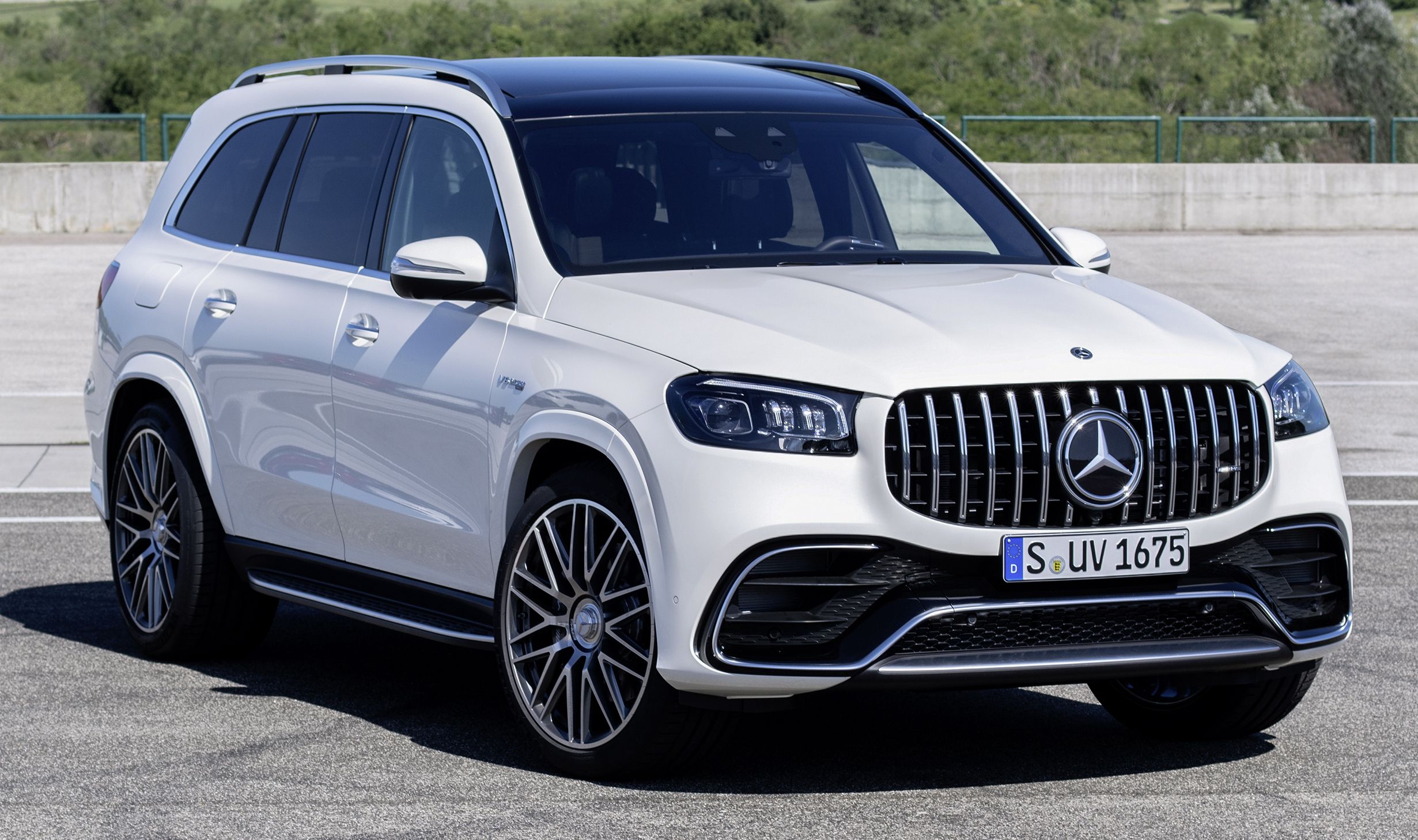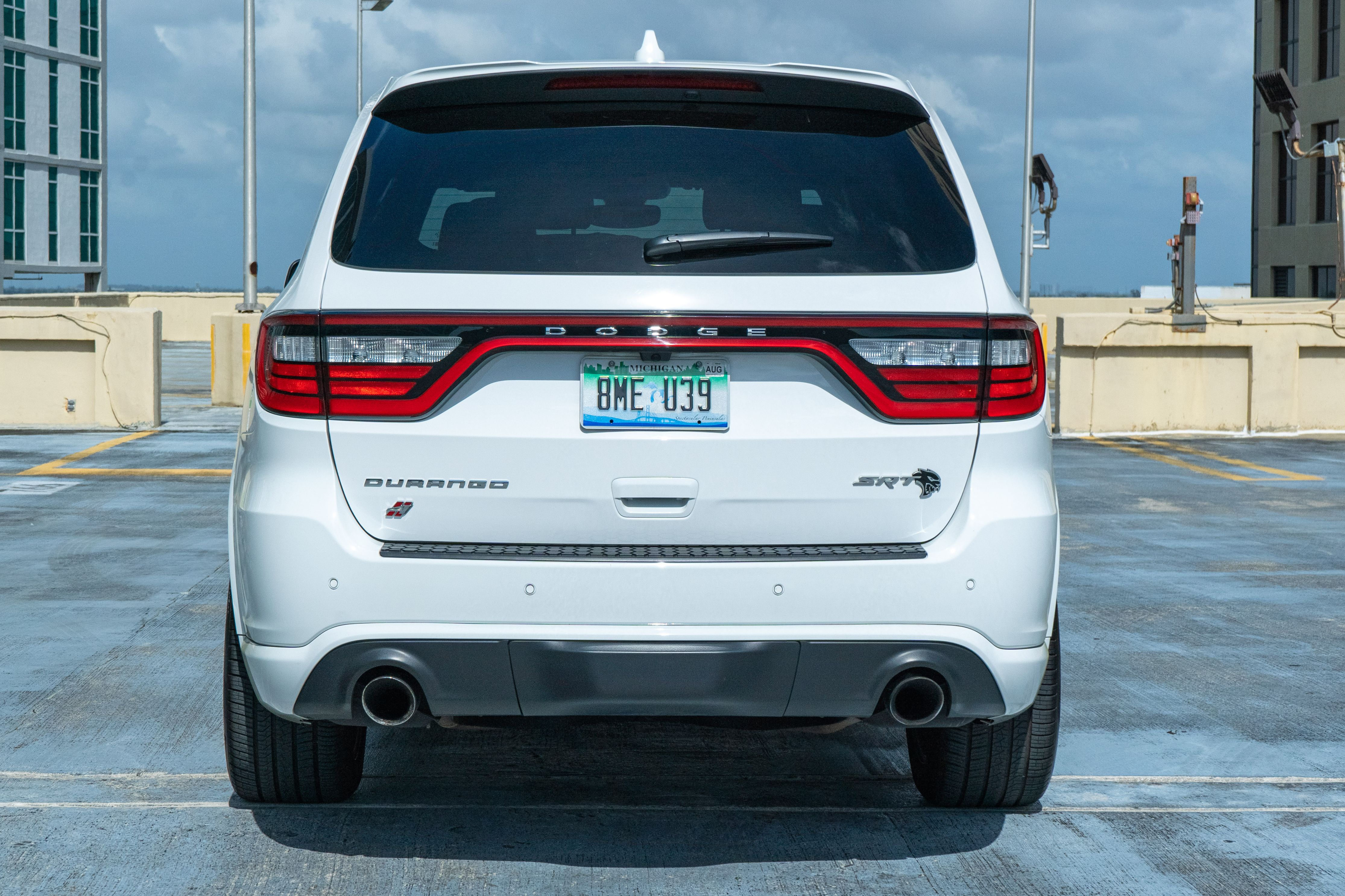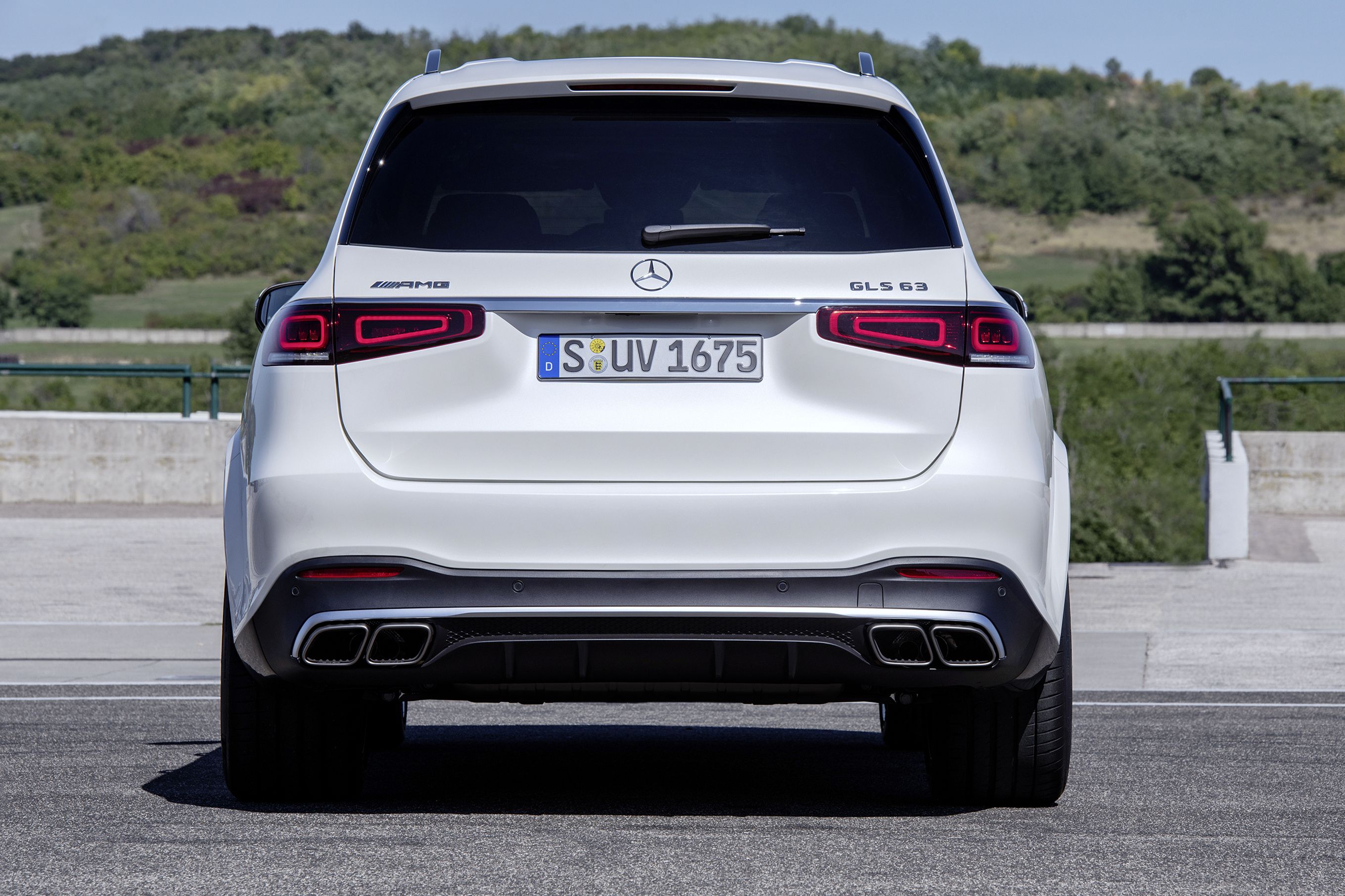Until 2020, the Dodge Durango was a family SUV with a sporty side to it. It came with a V-8 engine that churned out enough power to fulfill the adrenaline rush while also serving as a practical utility vehicle. For the 2021 model, however, Dodge upped the ante. As part of its process to plonk in the Hellcat engine in every product in its portfolio, the automaker transformed the Durango into a beast incarnate that just can’t be tamed. On paper, the Durango SRT Hellcat is now the most powerful production SUV. It can sprint to 60 mph from a standstill in 3.5 seconds. Isn’t that a wonderful and frightening sight at the same time?
2021 Dodge Durango SRT Hellcat - Driven
- Make: Array
- Model: 2021 Dodge Durango SRT Hellcat - Driven
- Engine/Motor: V8
- Horsepower: 710 @ 6100
- Torque: 645 @ 4300
- [do not use] Vehicle Model: Array
Dodge Durango SRT Hellcat Drivetrain, Performance Figures, and Fuel Economy
Power is sent to all the wheels as standard via an eight-speed TorqueFlite automatic gearbox. The same engine is plonked in the Jeep Grand Cherokee Trackhawk, too, but there it makes three horses less.
Complementing the engine is a 2.38-liter supercharger with twin-screw rotors to minimize air leakage and increase performance. This supercharger has a maximum speed of 14,600 rpm and has a drive ratio of 2.36:1. It can regulate a boost pressure up to 11.6 psi, courtesy of an integrated electronic bypass valve.
The engine comes with stuff like aluminum-alloy cylinder heads, forged steel crankshaft, specially-tuned crankshaft damper, and so on. The folks at Dodge even created a special cooling circuit that includes a water pump, coolant reservoir, and a heat exchanger. It helps keep the intake air temperatures below 140 degrees Fahrenheit, thus optimizing performance.
How Quick and Fast Is The Durango SRT Hellcat?
Speaking of its performance, the Durango SRT Hellcat takes just 3.5 seconds to sprint to 60 mph from a standstill. The top speed is rated at 180 mph, which is 10 mph shy of the current fastest production SUV, the Bentley Bentayga. Dodge noted that the Durango SRT Hellcat takes just 11.5 seconds to the quarter-mile, and according to the National Hot Rod Association, it is 1.5 seconds faster than the Durango SRT 392 on a 2.1-mile road.
What Is The Durango SRT Hellcat’s Fuel Economy?
The Durango SRT Hellcat delivers 13 miles in the city, 19 miles on the highway, and 15 miles combined for every gallon of fuel consumed. Its chief rival, the Grand Cherokee Trackhawk that also features the same engine and almost identical power specs, also delivers the exact same figures. The Mercedes-AMG GLS63 with a smaller displacement engine and lower power figures returns 16 mpg in the city, 18 mpg on the highway, and 16 mpg combined.
The Dodge Durango SRT Hellcat and the Jeep Grand Cherokee Trackhawk can gulp 24.6 gallons of fuel in one go whereas the Mercedes-AMG GLS63 can drink 26.4 gallons of fuel.
Dodge Durango SRT Hellcat Suspension, Drive Modes, and Towing Capacity
To handle so much power, the automaker has installed an upgraded suspension setup on the Durango SRT Hellcat. It is said to be more responsive and has a 20-percent increase in total rebound control as opposed to the system on the other Durango models. It also offers more grip with reduced understeer that makes this a strong corner carver.
The Durango SRT Hellcat comes with seven different drive modes to choose from - Auto, Sport, Track, Snow, Tow, Eco, and Valet. These modes are tuned to the new engine and make sure all the power is handled without any scope for mishaps. The SUV also comes with Launch Control and Launch Assist. The electric power steering wheel also comes with selectable steering tuning and three driving settings: Street, Sport and Track, and Custom. As for the braking duties, race-inspired Brembo brakes take care of that.
How Much Can The Durango SRT Hellcat Tow?
When equipped with the right packages, the Durango SRT Hellcat can tow up to 8,700 pounds. The Grand Cherokee Trackhawk and the GLS63, on the other hand, can tow up to 7,200- and 7,500 pounds, respectively.
Dodge Durango SRT Hellcat Exterior Design
The Durango SRT Hellcat doesn’t look vastly different from the other models. It looks more beefed up all around and has a flair that resonates with the Dodge Charger Widebody. The SRT Hellcat comes with an exclusive low-gloss black grille with large openings for improved cooling. And, to aid better aerodynamics, a front splitter is also equipped.
The SUV also comes with exclusive badges on the fenders finished in chrome as standard. They can be had in Neutral Grey Metallic as part of the optional Black Package. This 710-horsepower model rides on 20-inch machine-faced wheels with a mid-gloss black design as standard. They come shod in Pirelli Verde Zero all-season tires. If these don’t float your boat, Dodge offers 20-inch lights-out aluminum wheels and Pirelli P Zero three-season tires as optional. Both the Pirelli sets measure 295/45 section tires. You can also opt for a compact spare tire.
At the rear, Dodge has installed Racetrack LED taillights, and has redesigned and reshaped the that offers downforce at higher speeds. In numbers, provide a downforce of up to 400 pounds when traveling at its top speed of 180 mph. Dodge is offering five styles of dual-racing stripes for the Durango SRT Hellcat, and these include Black with Red Accents, Bright Blue, Flame Red, Gunmetal Low Gloss, and Sterling Silver. As for the exterior shades, the Dodge Durango is available in 10 different colors:
-* Billet Silver
-* DB Black
-* Destroyer Grey
-* F8 Green
-* Granite
-* Octane Red
-* Reactor Blue
-* Redline
-* Vice White
-* White Knuckle
White Knuckle comes as the standard paint option here. The Vice City White is the only paid paint option and Dodge charges $595 for it. Any of the other shades can be opted for at no extra cost.
How Big Is The Durango SRT Hellcat?
The Durango SRT Hellcat measures 201 inches in length, making it longer 11.2 inches longer than the Grand Cherokee Trackhawk, but 5.4 inches shorter than the GLS63. It measures 76.4 inches in width and is bettered by both the other SUVs. The Jeep is 0.1 inches wider, whereas the Mercedes is 3.5 inches wider at 79.9 inches. The Durango SRT Hellcat is the tallest of the lot at 72.1 inches. The GLS63 is 70.2 inches tall whereas the Grand Cherokee Trackhawk is the shortest at 67.9 inches.
The Durango SRT Hellcat has a 119.8-inch wheelbase which is not bad for a three-row SUV. The Jeep’s wheelbase measures 114.7 inches and the GLS63’s at 123.4 inches, both of which are proportionate to their respective lengths.
Dodge Durango Hellcat vs competition - exterior dimensions
|
Length |
201 |
189.8 |
206.4 |
|---|---|---|---|
|
Width |
76.4 |
76.5 |
79.9 |
|
Height |
72.1 |
67.9 |
70.2 |
|
Wheelbase |
119.8 |
114.7 |
123.4 |
|
Front Track |
64.5 |
63.9 |
67.1 |
|
Rear Track |
64.8 |
65.7 |
67.9 |
Coming to the angles, the Durango SRT Hellcat boasts of an approach angle of 18.4 degrees, breakover angle of 15.6 degrees, and departure angle of 20.2 degrees.
How Much Does The Durango SRT Hellcat Weigh?
The Dodge Durango SRT Hellcat weighs 5,710 pounds. This is almost 500 pounds heavier than the Grand Cherokee Trackhawk that stands at 5,253 pounds, but over 300 pounds lighter than its German counterpart which weighs 6,019 pounds.
Dodge Durango SRT Hellcat Interior Design and Technology
Step inside and you’ll be welcomed to a rather sporty cabin. The automaker has opted for a Challenger-inspired cockpit here. The driver-centric setup features an SRT-badged flat-bottom steering wheel that’s lied straight from the Challenger. The instrument cluster also features red gauges. It free flows into the infotainment system and gives the vibes of both being in a conjoined unit. It looks very different from the previous model year Durango.
The Durango SRT Hellcat comes with black leather seats with suede inserts as standard. The only other upholstery on offer is a $1,595 option that wraps the seats in Laguna leather. Our test model came with these seats. On the center console, there’s a 10.1-inch touchscreen that runs on FCA’s UConnect 5 infotainment system. It supports Apple CarPlay, Android Auto, as well as Amazon Alexa. Stuff like navigation, HD Radio, Bluetooth, and a few Sirius XM subscriptions are offered, too. People who prefer good beats and acoustics to the Hellcat’s grunt can opt for the 19-speak Harman Kardon audio system.
Courtesy of the neatly laid out dash, Dodge was able to provide a multitude of cup holders and cubby holes. In fact, there’s a slot to place the key fob right behind the gear shifter and a wireless charging pad in front of it. There are forged carbon fiber trims all around that give the cabin a sporty and premium vibe.
Another interesting option here is the Lightweight Performance Package that is offered at no extra cost. Basically, the third row is taken out here and your Durango is transformed into a five-seater with a 60:40 split rear bench. If the seating configuration was your only reason for picking the Grand Cherokee Trackhawk over the cheaper Durango SRT Hellcat, well, Dodge has solved it for you.
Is The Durango SRT Hellcat Spacious?
Despite being sized differently, all three SUVs offer almost similar space inside the cabin. The Durango SRT Hellcat and the Jeep Grand Cherokee offer the same headroom in the front row – 39.9 inches. The GLS63’s headroom measures 39.4 inches. All three SUVs offer the same 40.3-inch legroom. As for the shoulder room, the Dodge offers 58.5 inches, the Jeep 58.7 inches, and the Mercedes 59.3 inches. The hip room is an identical 57 inches on the Dodge and the Jeep.
In the second row, the GLS63 offers the best space in all the departments. The Durango SRT Hellcat offers 39.8 inches of headroom, 38.6 inches of legroom, and 57.7 inches of shoulder room. The Jeep Grand Cherokee Trackhawk and the GLS63 offer 39.2- and 402 inches of headroom, 38.6- and 41.9 inches of legroom, and 58- and 58.5 inches of shoulder room, respectively. The hip room is rated at 55.5 inches on the Durango and 56.2 inches on the Grand Cherokee.
The Grand Cherokee doesn’t come with a third row, but the other two do. The Durango comes with 37.8 inches of headroom, 33.5 inches of legroom, 50.4 inches of shoulder room, and 42.4 inches of hip room. The GLS63’s headroom is rated at 38.9 inches, legroom at 34.6 inches, and shoulder room at 50.3 inches.
Dodge Durango Hellcat vs competition - interior dimensions
|
1st Row Headroom |
39.9 |
39.9 |
39.4 |
|---|---|---|---|
|
1st Row Leg Room |
40.3 |
40.3 |
40.3 |
|
1st Row Shoulder Room |
58.5 |
58.7 |
59.3 |
|
1st Row Hip Room |
57 |
57 |
NA |
|
2nd Row Headroom |
39.8 |
39.2 |
40.2 |
|
2nd Row Leg Room |
38.6 |
38.6 |
41.9 |
|
2nd Row Shoulder Room |
57.7 |
58 |
58.5 |
|
2nd Row Hip Room |
55.5 |
56.2 |
NA |
|
3rd Row Headroom |
37.8 |
NA |
38.9 |
|
3rd Row Leg Room |
33.5 |
NA |
34.6 |
|
3rd Row Shoulder Room |
50.4 |
NA |
50.3 |
|
3rd Row Hip Room |
42.4 |
NA |
NA |
How Much Cargo Can The Durango SRT Hellcat Carry?
Behind the third row, the Durango SRT Hellcat offers 17.2 cubic feet of space, which is just 0.2 cubic feet less than the GLS63. In case you didn’t know, the Grand Cherokee Trackhawk is a five-seater, although the company came up with the three-row version of the SUV called the Grand Cherokee L. For now, the Grand Cherokee L is not available in the Trackhawk trim.
Anyway, with the third row folded, the Durango SRT Hellcat offers 43.3 cubic feet of space, which is 0.6 cubic feet more than the GLS63’s 42.7 cubic feet capacity. The Grand Cherokee Trackhawk offers 36.3 cubic feet of space behind the second row. With the second row folded, and even the third row in the case of the Mercedes and the Dodge, The Durango offers the best capacity – 85.1 cubic feet. The GLS63 and the Grand Cherokee Trackhawk offer 84.7- and 68 cubic feet of space, respectively.
Dodge Durango SRT Hellcat Pricing
The 2021 Dodge Durango SRT Hellcat starts at $80,995 plus a destination charge of $1,495. This brings the starting price to $82,490. This makes it around $7,000 cheaper than the Jeep Grand Cherokee Trackhawk. The GLS63 is in a different league altogether, starting at around $130,000. The SRT Hellcat is also the priciest model in Durango’s lineup, making it over $16,000 more expensive than the next-placed SRT.
Is The Dodge Durango SRT Hellcat Better Than The Jeep Grand Cherokee Trackhawk?
|
|
ids=981667,981668 |
no_overlay=false |
before_label=Dodge Durango SRT Hellcat |
after_label=Jeep Grand Cherokee Trackhawk> |
The Durango SRT Hellcat’s chief rival is its cousin, the Jeep Grand Cherokee Trackhawk. There is nothing modest about this SUV. It’s big, brawny, luxurious, loud, and insanely fast. It rides on 20-inch wheels wrapped in 295/45 section tires. The SUV is powered by the same 6.2-liter, supercharged V-8 HEMI engine that dishes out 707 horses and 645 pound-feet of torque. Three horses less don’t make much of a difference, but on paper, the Durango is still more powerful.
The biggest difference is that the Trackhawk comes with a two-row setup, unlike the Durango’s three-row configuration. You can opt for a third-row delete in the latter if you’d like to. It comes with a smaller 8.4-inch touchscreen system that runs on the UConnect 4 system. Both being FCA products, there aren’t a whole lot of other differences that set them apart. You would expect them to be priced on par or have a price difference of probably a couple of thousand bucks. But, the Jeep Grand Cherokee Trackhawk is significantly more expensive, starting at $89,615. This makes it over $7,000 more expensive than the Durango SRT Hellcat.
|
|
ids=981669,981670 |
no_overlay=false |
before_label=Dodge Durango SRT Hellcat |
after_label=Jeep Grand Cherokee Trackhawk> |
Dodge Durango Hellcat vs Jeep Grand Cherokee Trackhawk
|
Dodge Durango Hellcat |
Jeep Grand Cherokee Trackhawk |
Engine |
6.2-liter HEMI Hellcat V-8 |
6.2-liter supercharged V-8 |
|
|---|---|---|---|---|---|
|
Fuel |
Premium |
Premium |
|||
|
Horsepower |
710 bhp @ 6,100 rpm |
707 hp @ 6,000 rpm |
|||
|
Torque |
645 lb.-ft. @ 4,300 rpm |
645 lb.-ft. @ 4,800 rpm |
|||
|
Transmission |
8-speed automatic |
8-speed automatic |
|||
|
Drive |
AWD |
AWD |
|||
|
Fuel Economy |
13/19/15 |
13/19/15 |
|||
|
Curb Weight |
5,710 |
5,253 |
|||
|
Fuel Capacity |
24.6 |
24.6 |
|||
|
0-60 MPH |
3.5 seconds |
3.5 seconds |
|||
|
Top Speed |
180 mph |
180 mph |
Read our full review on the Jeep Grand Cherokee Trackhawk
Is The Dodge Durango SRT Hellcat Better Than The Mercedes-AMG GLS63?
|
|
ids=981671,981672 |
no_overlay=false |
before_label=Dodge Durango SRT Hellcat |
after_label=Mercedes-AMG GLS 63> |
The Mercedes GLS63 comes with the AMG treatment here that makes it a much more premium product than the Dodge Durango. It is undoubtedly a lot plusher and luxurious. It offers almost the same amount of space inside the cabin, but is marginally bigger on the outside. Things, however, are vastly different on the drivetrain and performance front.
The GLS63 also features a V-8 engine under the hood, but it comes with a bi-turbo setup unlike the Hellcat with a supercharger. It makes 603 horses and 627 pound-feet of twist, which is over 100 ponies fewer than the Durango’s. Power is sent to all the wheels via a slick nine-speed automatic gearbox. It takes 4.1 seconds to 60 mph, which is 0.6 seconds slower, and has a top speed of 174 mph, just a shade less than Durango SRT Hellcat’s 180 mph top speed. The GLS63 starts at $132,100.
|
|
ids=981673,981674 |
no_overlay=false |
before_label=Dodge Durango SRT Hellcat |
after_label=Mercedes-AMG GLS 63> |
Dodge Durango Hellcat vs Mercedes-AMG GLS63
|
Dodge Durango Hellcat |
Mercedes-AMG GLS63 |
Engine |
6.2-liter HEMI Hellcat V-8 |
4.0L V8 Biturbo |
|
|---|---|---|---|---|---|
|
Fuel |
Premium |
Premium |
|||
|
Horsepower |
710 bhp @ 6,100 rpm |
603 @ 5,750 - 6,500 |
|||
|
Torque |
645 lb.-ft. @ 4,300 rpm |
627 @ 2,500 – 4,500 |
|||
|
Transmission |
8-speed automatic |
9-speed automatic |
|||
|
Drive |
AWD |
AWD |
|||
|
Fuel Economy |
13/19/15 |
14 / 18 / 16 |
|||
|
Curb Weight |
5,710 |
6,019 |
|||
|
Fuel Capacity |
24.6 |
26.4 |
|||
|
0-60 MPH |
3.5 seconds |
4.1 secomds |
|||
|
Top Speed |
180 mph |
174 mph |
Read our full review on the Mercedes-AMG GLS63
Dodge Durango SRT Hellcat Warranty
The Durango SRT Hellcat comes with a 3-year/36,000-mile basic warranty and a 5-year/60,000-mile powertrain warranty.
Dodge Durango SRT Hellcat Optional Packages
-* Black Package - $1,845
-* Lightweight Performance Package – No cost
-* Technology Group - $2,395
-* Rear DVD Entertainment Center - $1,995
-* Trailer-Tow Group IV - $1,195
-* Premium Interior Cargo - $2,495
Dodge Durango SRT Hellcat Safety Features
Some of the Durango SRT Hellcat’s safety features include:
-* Four-Wheel Traction Control
-* Electronic Stability Control
-* Enhanced Accident-Response System
-* Hill-Start Assist
-* Front and Rear Park-Assist
-* Rear Back-Up Camera
-* Remote-Start System
-* Security Alarm
-* Tire Pressure Monitoring Display
-* Trailer Sway Damping

